Introduction
Welcome to OmniPlan 3 for iOS!
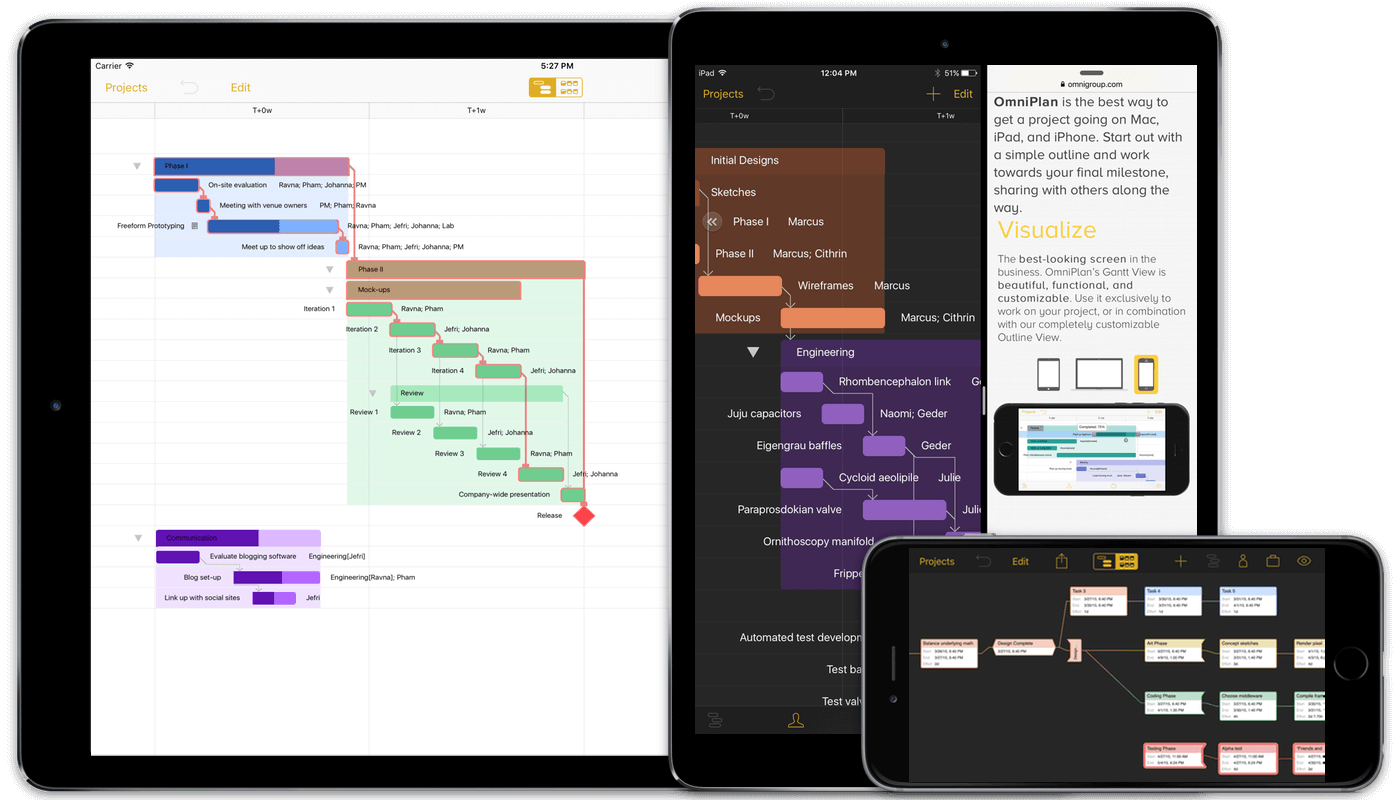
OmniPlan for iOS is designed to help you visualize, maintain, and simplify your projects. Break down tasks, optimize the required resources, control costs, and monitor your entire plan—all at a glance. Collaborate with your colleagues and share every detail, update a calendar with your days off, and process changes one-by-one or all in one go. OmniPlan provides features like Gantt charts, schedules, summaries, milestones, and critical path highlighting to let you manage all of your activities. From customizable views to fast data entry, OmniPlan helps you manage projects that are as simple or complex as you need them to be—without the complexity.
OmniPlan 3 is the most advanced desktop-class project management app you’ll find on iOS. Built to be fully compatible with OmniPlan 3 for Mac, you can seamlessly manage your projects in OmniPlan wherever you are. Whether you’re in the boardroom or in your truck on a job site, OmniPlan is there for you.
Note
- OmniPlan for iOS (the subject of this manual) is available on the App Store as a Universal app that works on all of your iOS devices capable of running iOS 9 or later.
- OmniPlan for Mac is available both on the Mac App Store and directly from The Omni Group.
- Single user file sync via OmniPresence is supported in the standard versions of OmniPlan 3 for iOS and OmniPlan 3 for Mac.
- Collaboration via server repository is supported via publication and subscription in OmniPlan 3 Pro for iOS and OmniPlan 3 Pro for Mac.
- OmniPlan 3 for Mac requires OS X Yosemite (version 10.10 or later), while OmniPlan for iOS requires iOS 9.
How This Documentation is Organized
This manual that you have before you (either online or in iBooks on your Mac or iOS device—or both) has been assembled in such a way that you’re provided with a complete tour of OmniPlan.
This introductory chapter provides an overview of the new features in OmniPlan 3, and explains just what this manual is all about. The few chapters following are a great introduction to the app, so if you’re new to OmniPlan proceeding through from the start isn’t a bad idea.
Note
If you just need a quick update on what's new in the current release, see the Release Notes in OmniPlan Settings for a list of recent changes.
To help guide you through the documentation and better learn everything there is to know about OmniPlan, a list of the chapters in this book follows.
- Chapter 1, Introduction
- The chapter you are currently reading provides an introduction to OmniPlan, describes the contents of this book, and offers tips on staying up to date with the latest versions of the OmniPlan documentation (the downloadable eBook is a great way to stay on top of updates).
- Chapter 2, Managing Your Project Files
- This chapter describes managing your project files using OmniPlan’s built in document browser. Beyond creating, organizing, and sharing your documents, the document browser also holds tools for getting help and customizing your OmniPlan experience at a high level—you’ll learn all about those tools here.
- Chapter 3, Getting Synced
- If you’re working on a project with OmniPlan on multiple devices and you’d like your documents to stay in sync between them, or you’d just like the additional layer of backup provided by cloud-based storage, you’ll find instructions here for setting up single user file sync with OmniPresence. For users of OmniPlan Pro, this chapter also includes a quick-start guide for connecting to a shared server repository (setting up and using the collaborative publication and subscription features of OmniPlan Pro is covered in Chapter 7).
- Chapter 4, Working in the Project Editor
- In OmniPlan for iOS the project editor is where you will spend most of your time, from creating your project’s first task to marking the last milestone complete. This chapter provides an overview of the tools available for creating, customizing, and curating even the most complex projects using the editing tools available in the Gantt chart and its associated inspectors.
- Chapter 5, Building Your First Project
- Once you are familiar with the tools in the Project Editor you are ready to get your first project up and running. The tutorial in this chapter guides you through the preliminary phase of effective OmniPlan use: building a model simulation-style description of your project inside OmniPlan. When completed, you’ll have the first baseline picture of a plan from which your project can begin in earnest.
Note
Revised for OmniPlan 3, this tutorial offers fresh insight into OmniPlan for new and experienced users alike. It's worth a look even if you’re familiar with a previous version of the app.
Topics covered include:
-
- Creating a new project
- Adding tasks, milestones, and task groups
- Describing dependency relationships between tasks
- Setting the project’s work schedule
- Adding resources and assigning them to tasks
- Assigning costs to tasks and resources
- Optimizing resource use by leveling
- Setting a baseline for progress
- Chapter 6, Managing a Project
- Once your project is set up with as many of its constituent variables, dependencies, resources, and scheduling constraints as possible, the real power of OmniPlan emerges. This chapter introduces the tools you will use to monitor, update, and revise your project as work proceeds, to help ensure that the work—from the first task to the last milestone—will be as quick and efficient as possible.
Once a project begins the tasks required to manage it aren’t as chronologically linear as the steps required to set it up. This tutorial chapter covers a range of tools available to help keep the project on track—but it’s not expected that you’ll need to use them all every day. Topics covered include:
- Chapter 7, Multi-User Collaboration (Pro)
- If you are working on a project with multiple contributors, the publication and subscription features of OmniPlan Pro can be invaluable. This chapter introduces OmniPlan’s multi-user collaboration features, and guides you through setting up an account and syncing your files with a shared server repository. Balancing resource loads across projects that share a common resource pool and tracking changes to the project made by other users are also covered here.
- Chapter 8, Keyboard Shortcuts
- If you are using OmniPlan for iOS with an external keyboard connected to your device, you can take advantage of OmniPlan’s built-in keyboard shortcuts. This chapter provides a list of the available shortcuts based on where you are and what you’re doing in the app.
- Chapter 9, Getting Help
- If you ever get stuck when working on something in OmniPlan, if you have a problem installing the app, or you just want to tell our Support Humans or DocWranglers what an awesome job they’re doing, feel free to get in touch. This chapter points you to all of the help resources we have available: Support Humans, Support Articles, Videos, and Documentation.
- Glossary
- The glossary contains an alphabetical list of special terms you will encounter throughout the app, this documentation, and other project management resources you might be familiar with. If you are just starting out in project management or you are curious about how OmniPlan implements certain concepts, this is a great place to check.
Using This Book
One of the beauties of having OmniPlan’s documentation available in electronic form is that it’s always available whenever you need it. In addition to having all of the documentation on our website where it can be searched and bookmarked, we’re continuing the ongoing trend of creating EPUB versions of the docs and making them freely available on the iBooks Store.
Features of OmniPlan 3
With OmniPlan 3 for iOS, our vision is simple: to bring OmniPlan on your iOS device to the position of a true peer of OmniPlan for Mac. We’ve brought several previously Mac-only features to this release, including the new Network Diagram view in the project editor, the Meeting task type for work that requires all assigned resources to be available, expanded leveling options for adjusting task duration, effort, or assigned amounts, and much more.
New standard features in OmniPlan 3 include:
- Network View—An elegant and easy way to rapidly prototype and visualize your project’s flow as a network diagram of nodes connected by dependencies.
- Meeting Task Type—A new resource allocation option that allows you to specify if multiple resources need to work on a task independently or simultaneously.
- Catch-Up—If everything is going as planned, bring the completion percentage of every task (or just the selected tasks) in your project up to today’s date.
- Reschedule—If you have tasks which were planned to be complete by now, but aren’t, reschedule them with the tap of a button.
- Leveling Priority—Define leveling priority for tasks in your project.
- Display Off-Hours—Display all off-hours, holidays, and weekends as shaded vertical bars in the Gantt chart.
- Unlinked Duration and Effort—Set different values for a task’s effort and duration, then let OmniPlan crunch the numbers for your resource assignment percentage.
These features are on top of a list of returning features that make OmniPlan for iOS the leader in its class, including:
- Meticulously Designed Gantt Chart Interface—Rapidly build and easily maintain a project with this scalable, flexible view.
- Smart Scheduling and Automatic Leveling—Once your project is set up, OmniPlan’s automated scheduling and leveling tools help optimize your resource use every step of the way.
- Multiple Baselines and Critical Path Display—See your project's priorities clearly with critical paths, and reposition to address challenges that arise with as many baselines as you need.
- Printing and Export Options—Print over the air, send OmniPlan files via email, or export to common formats such as PDF and HTML.
- The Latest iOS Technologies—On devices that support them, OmniPlan includes Spotlight search, multitasking, 3D Touch controls from the app icon, and hardware keyboard shortcuts.
- OmniPresence File Sync—Sync and store your OmniPlan projects in the cloud with a free Omni Sync Server account.
Introducing OmniPlan Pro
Many OmniPlan users find that the tools to create, maintain, monitor, and complete a project—all features of the base app—fully encompass their needs. If your project management requirements are more complex, we offer a package of additional tools designed to extend OmniPlan to unprecedented levels of flexibility, extensibility, and power.
The suite of new OmniPlan Pro features includes:
Monte Carlo Simulations and Effort Estimation
OmniPlan 3 Pro brings the ability to estimate on-time project and milestone completion using Monte Carlo simulations. These are a great aid for planning ahead, providing tip-offs for when resources should be shifted to ensure on-time project completion. The simulation package also provides a handy Auto-Estimate Effort tool for tasks where effort isn’t already assigned, making completion forecasts quick and easy.
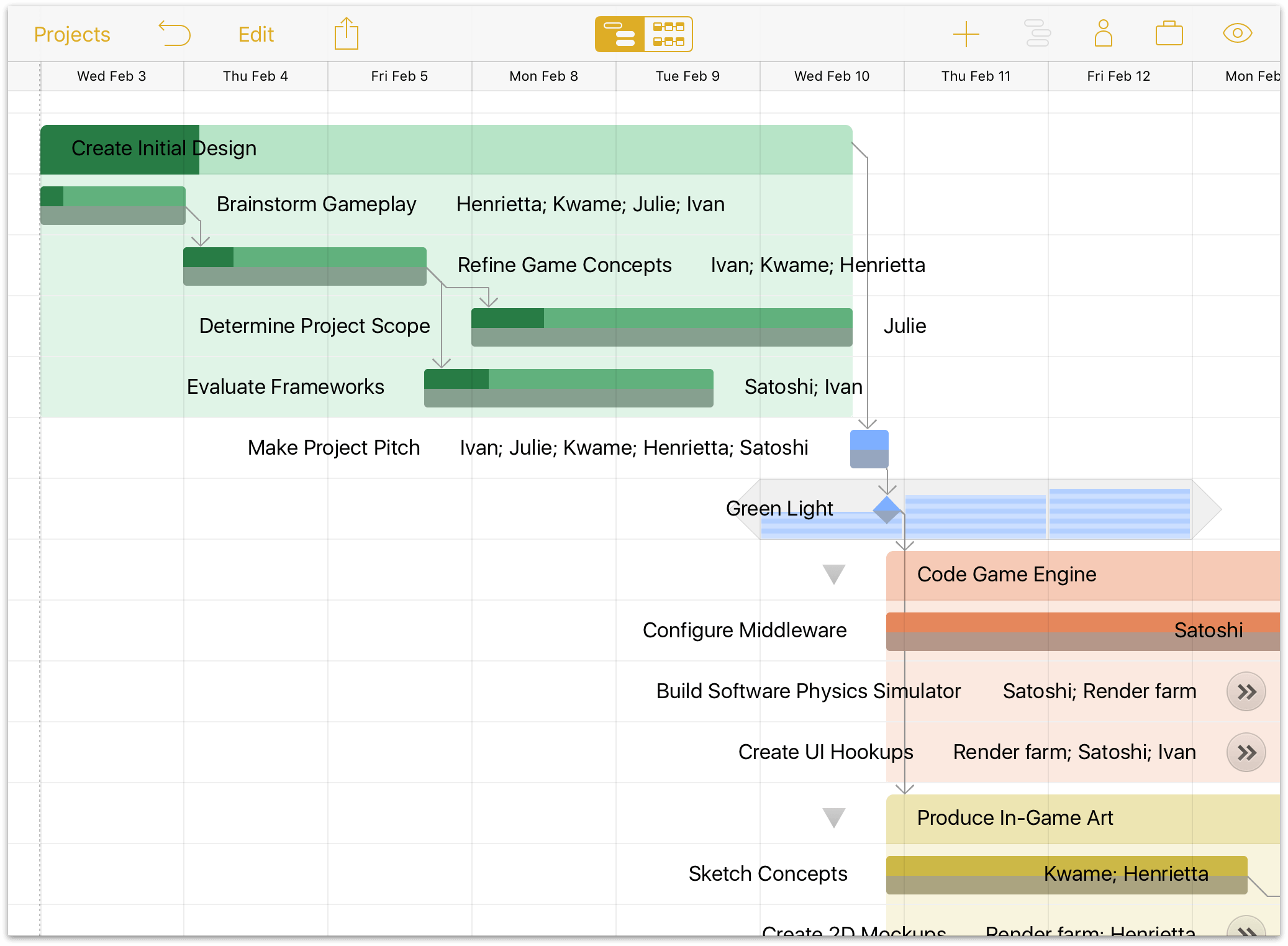
Upon running a simulation, a set of horizontal bars appears on days surrounding each milestone (represented as a small diamond); one bar equals 10 percent confidence that the milestone will be complete on that day (10 bars on a day means that according to the simulation, a milestone is 100% likely to be completed on that day).
The following features also return to Pro in OmniPlan 3:
- Microsoft Project Import and Export—Consistently updated interoperability with Microsoft’s project management software, including Microsoft Project 2016.
- Publishing, Subscribing, and Change Tracking—Multi-user sync and collaboration across one or many projects via shared server repository.
The OmniPlan Pro upgrade is available as an in-app purchase from the Settings menu in the document browser. To preview OmniPlan’s support for Microsoft Project files, see the MS Project Support example document in the Local Documents folder (if it’s missing, choose Restore Sample Documents from the Settings menu to create a new copy). You can also import your own Microsoft Project documents to preview them in OmniPlan before purchasing.
Throughout this manual, Pro features are denoted by a box with a border color distinct from other text (just like the one here) to indicate that the content within applies to features present when the OmniPlan Pro upgrade is installed.
Tell Us What You Think
We’re constantly working on updates for our documentation. Whether it’s CSS work, correcting the occasional typo (they do sometimes slip through), or adding details or clarification for a specific feature based on something we’ve heard from a customer, we’re always trying to make our documentation better and more useful for you.
If you have any specific comments you’d like to send us about the documentation, please do. You can drop us an email message via our Support queue, or you can ping us on Twitter; we’re @OmniWranglers.
Finally, we’d like to thank you for taking the time to read the docs.
Managing Your Project Files
Like many other document-based apps (word processors, spreadsheets, and the like), OmniPlan keeps information about your projects in files that are stored for safekeeping either along with OmniPlan on your device, or in an account in the cloud where they can be synced and accessed from multiple devices. This chapter describes the ins and outs of navigating OmniPlan’s document browser, while the next chapter, Getting Synced, has details on connecting to a cloud sync account.
Note
OmniPlan files use the .oplx extension, a bit of text appended to the filename that tells the operating system what app the files belong to. This extension is hidden when browsing files in OmniPlan for iOS, but is retained when syncing back and forth with OmniPlan for Mac to make sure everything stays in order.
Document Locations
When you first open OmniPlan, you’re taken to the Locations screen which is the place you go to access all of your documents. There is a Local Documents folder, which we’ve preloaded with some sample OmniPlan files that you can use as inspiration for the projects you create.
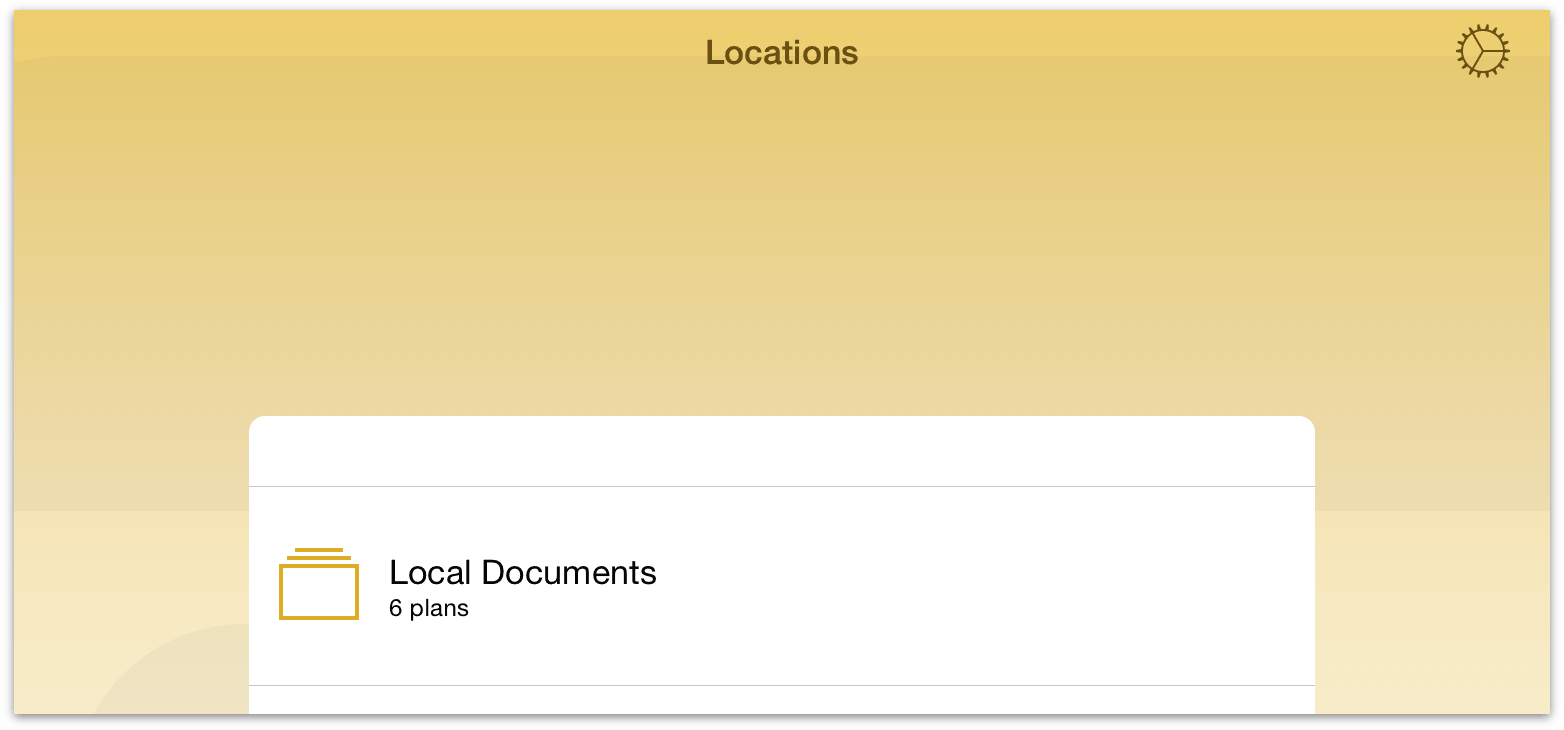
Tap the Local Documents folder to see what’s inside. This opens the Document Browser, which is the place to view, create, and manage your projects.
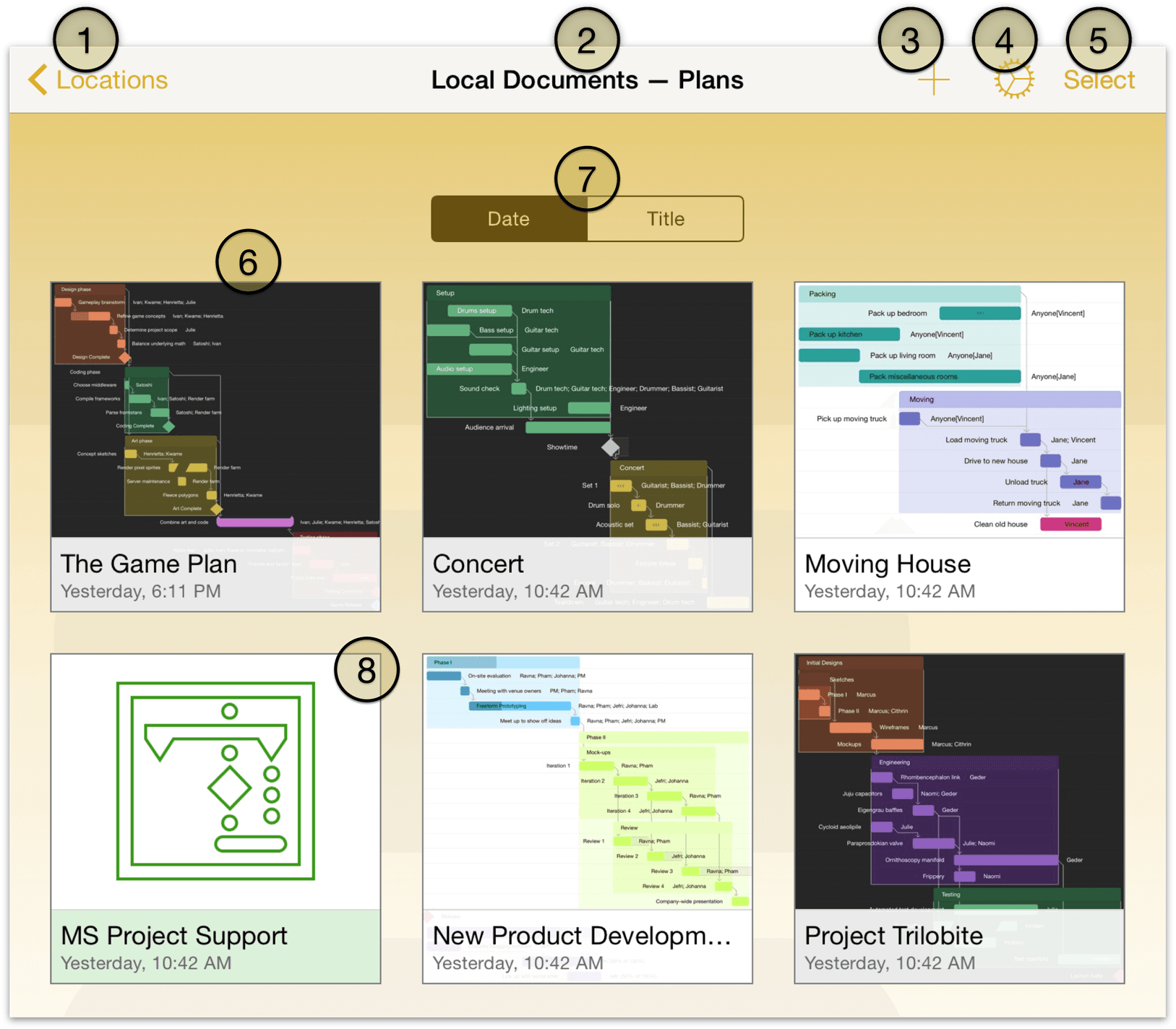
Locations—Tap here to go back to the main screen where you can view the Local Documents folder and any server repositories you’re synced with.
Folder Name and Document Type—This is the name of the current folder. Your default folder for storing files locally is titled Local Documents, and the document type is Plans (this is currently the only document type available).
Add/Plus—Tap to create a new project.
Settings—Tap to reveal a menu with preferences for OmniPlan, as described in Settings.
Select—Tap to edit the contents of a folder. For example, you can select one or more documents and move them to another folder, to the trash, or create a subfolder within the current folder that contains the projects you’ve selected.
Projects—These are your saved projects and any subfolders you’ve created in OmniPlan.
Sort—When you pull down on the screen, the super secret Sort bar comes into view. By default, the projects you create are sorted by their creation date, or you can opt to sort them by title.
MS Project Support—A preview document for the Microsoft Project file import feature, available with the OmniPlan Pro in-app purchase.
Note
With OmniPlan Pro, you can import Microsoft Project .mpp files created by modern versions of Microsoft Project up to 2016. Once imported, these documents can be managed just like any other OmniPlan Project.
OmniPlan Pro can also export Microsoft Project .mpp files. Once exported, these documents can be used in Microsoft Project 2016.
To create a subfolder, tap Select in the navigation bar, and then tap and select one or more files in the Document Browser. Next, tap Move to in the upper-left corner and then tap New folder.
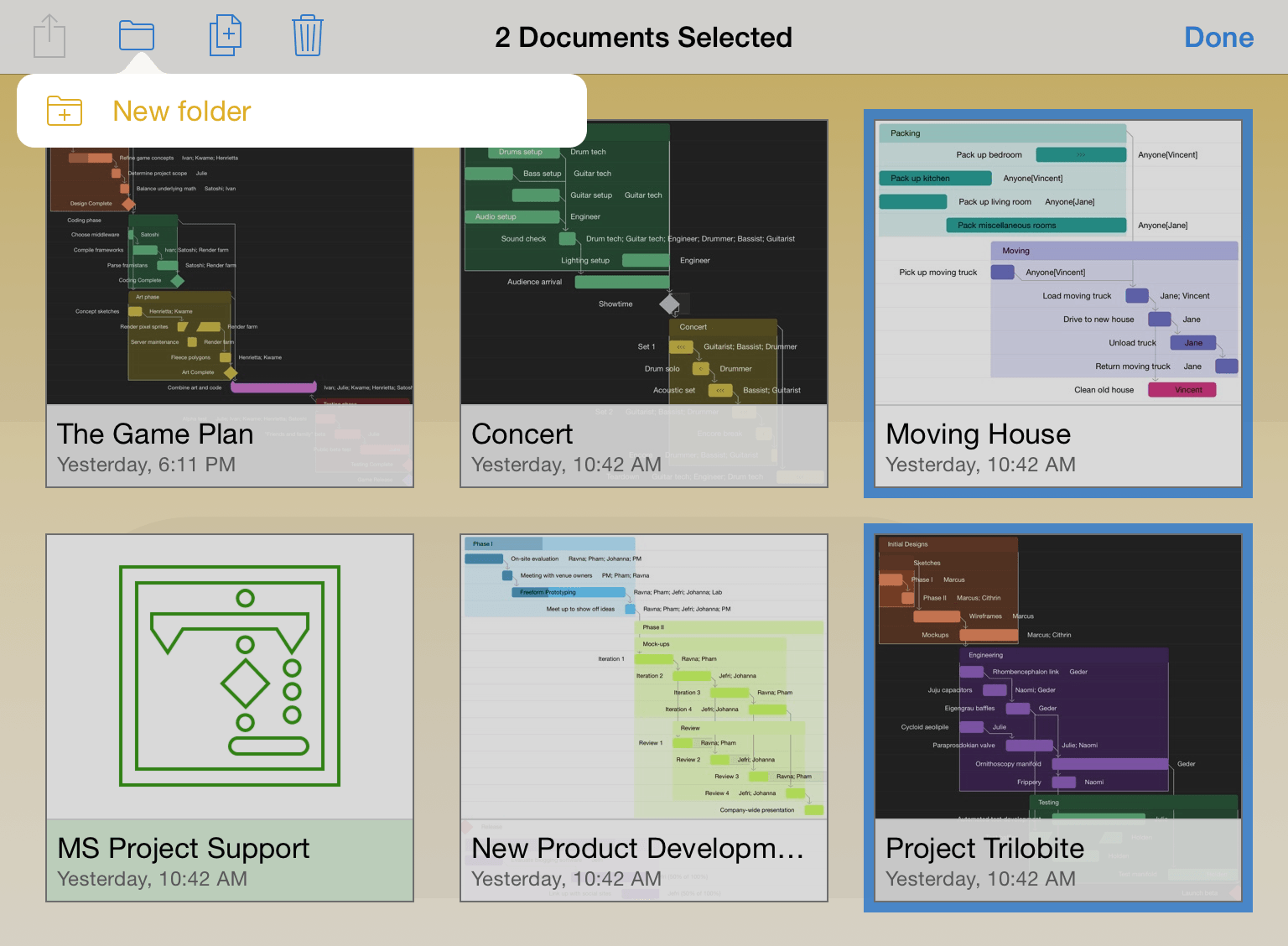
Enter a name for the folder and then tap Done. Subfolders have a dark gray background and display tiny icons for the projects they contain.
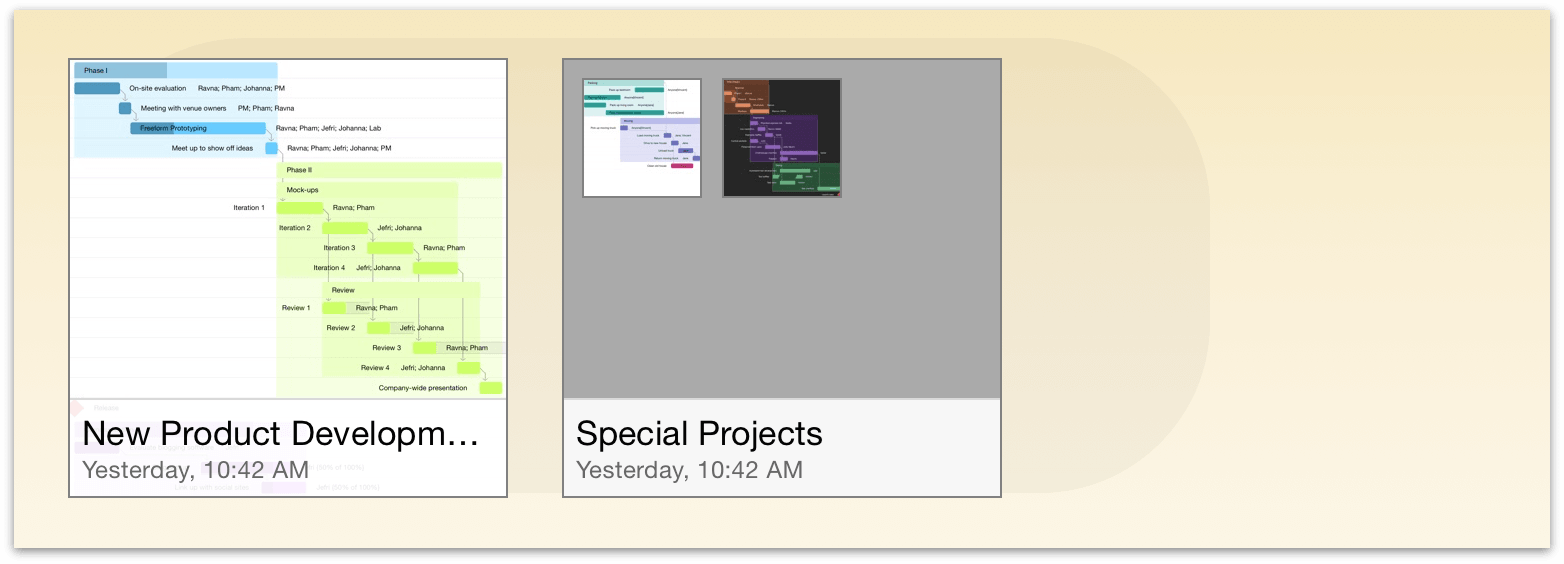
Adding Locations
Beneath the Local Documents folder on the locations screen, you’ll see one or more options for adding locations to the list of document sources available to OmniPlan. Unlike Local Documents—which by definition reside on your device—these options grant access to cloud-synced accounts with files that you’ve stored remotely.
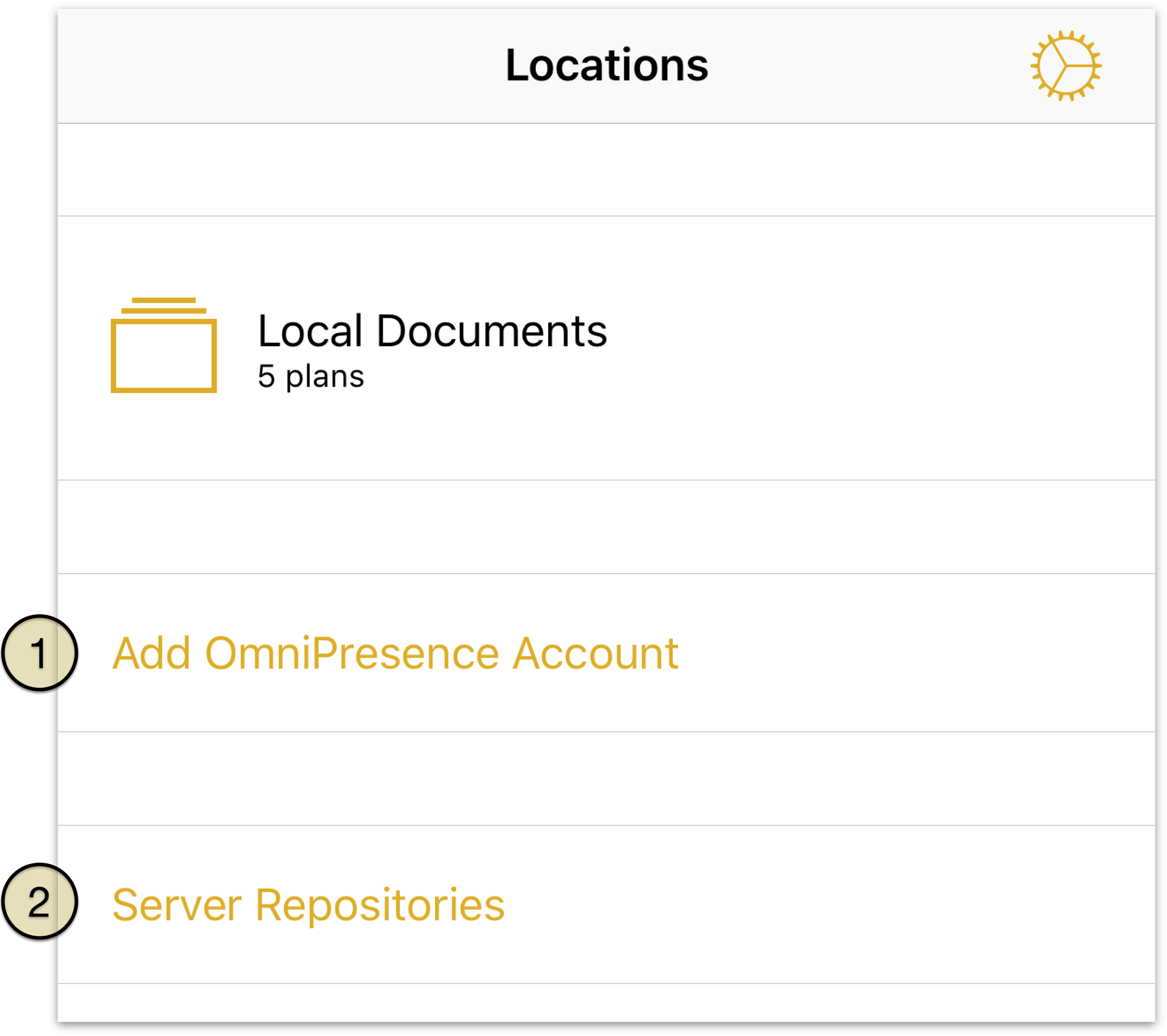
- In the standard version of OmniPlan for iOS, the Add OmniPresence Account option is presented to create an account for syncing between multiple devices used by a single person.
- OmniPlan Pro adds the option to sync with Server Repositories, useful when collaborating with multiple project contributors.
Learn more about setting up the various sync options in the Getting Synced chapter.
After adding an OmniPresence account, you’ll see it listed as a folder that’s a peer to your Local Documents folder on the Locations screen. Any connected server repository accounts are listed on the Server Repositories screen; to view them, tap Server Repositories.
Creating a New Project
To create a new project, go to the Locations screen, select the folder in which you’d like to store the new project file, and then tap the Add button (the + sign) in the navigation bar.
See Working in the Project Editor for details on using the Gantt chart and Network Diagram, or check out the Building a Project chapter to get started with your first project.
Taking Out the Trash
Every now and then, you will find that it’s time to do a little housecleaning in OmniPlan. When a project is no longer relevant, you can queue it for purging from your device (or from a synced cloud location, if you have one configured) forever.
Fortunately, deleting files from OmniPlan is easy. When viewing a folder of documents, tap Select in the navigation bar at the top of the screen. Then tap the documents you’d like to delete; you’ll see that the files now have a blue highlight.
Tap the trash can in the navigation bar to move the document to the Trash.

If you tap Locations in the navigation bar, you’ll see a Trash folder in your list of OmniPlan folders. Until you empty the trash, the files remain on your device.
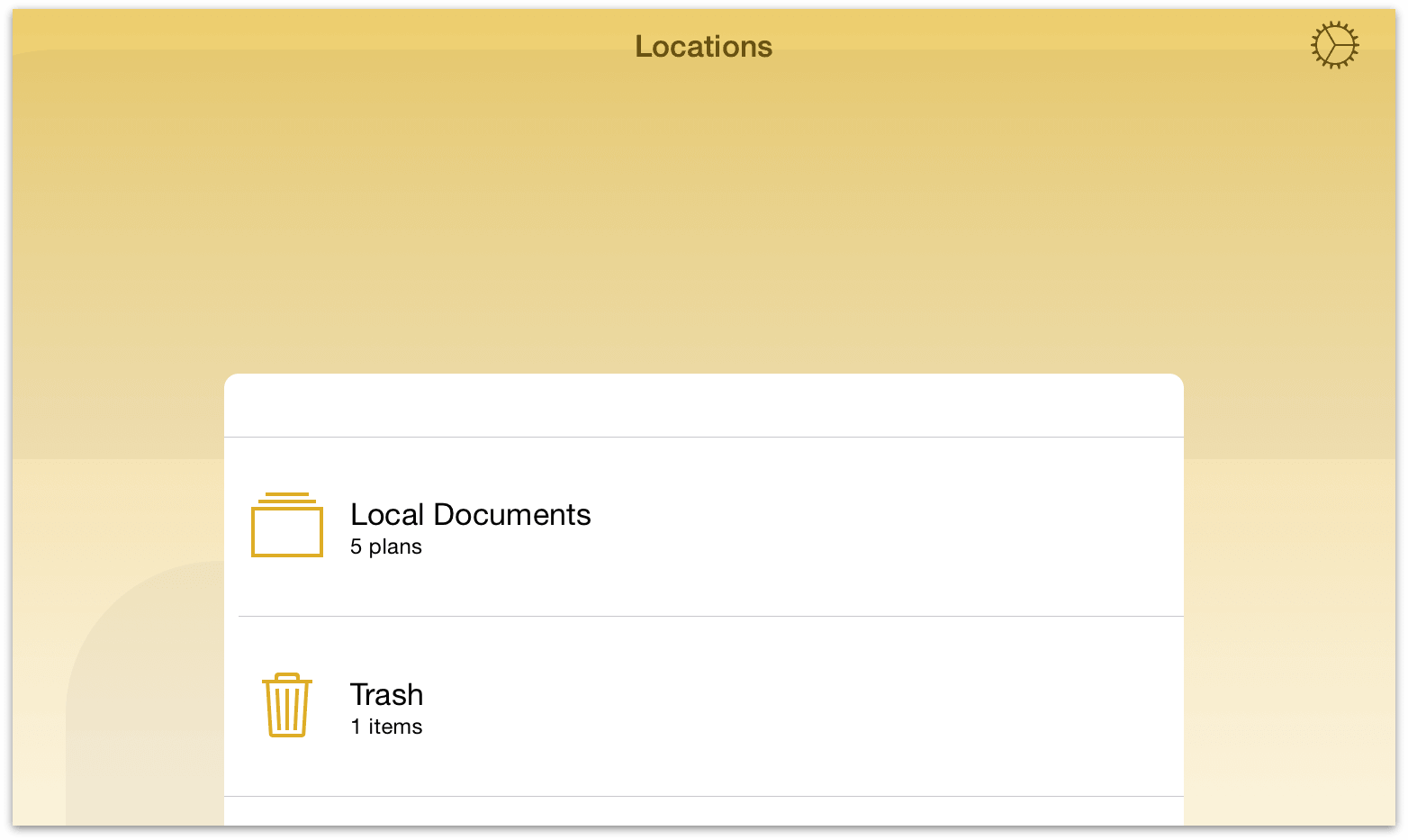
Tap the Trash folder to open it in the Document Browser, and then tap Empty Trash to permanently delete the files from your device. The Delete button (the shredder icon, circled) will also delete items selected normally.
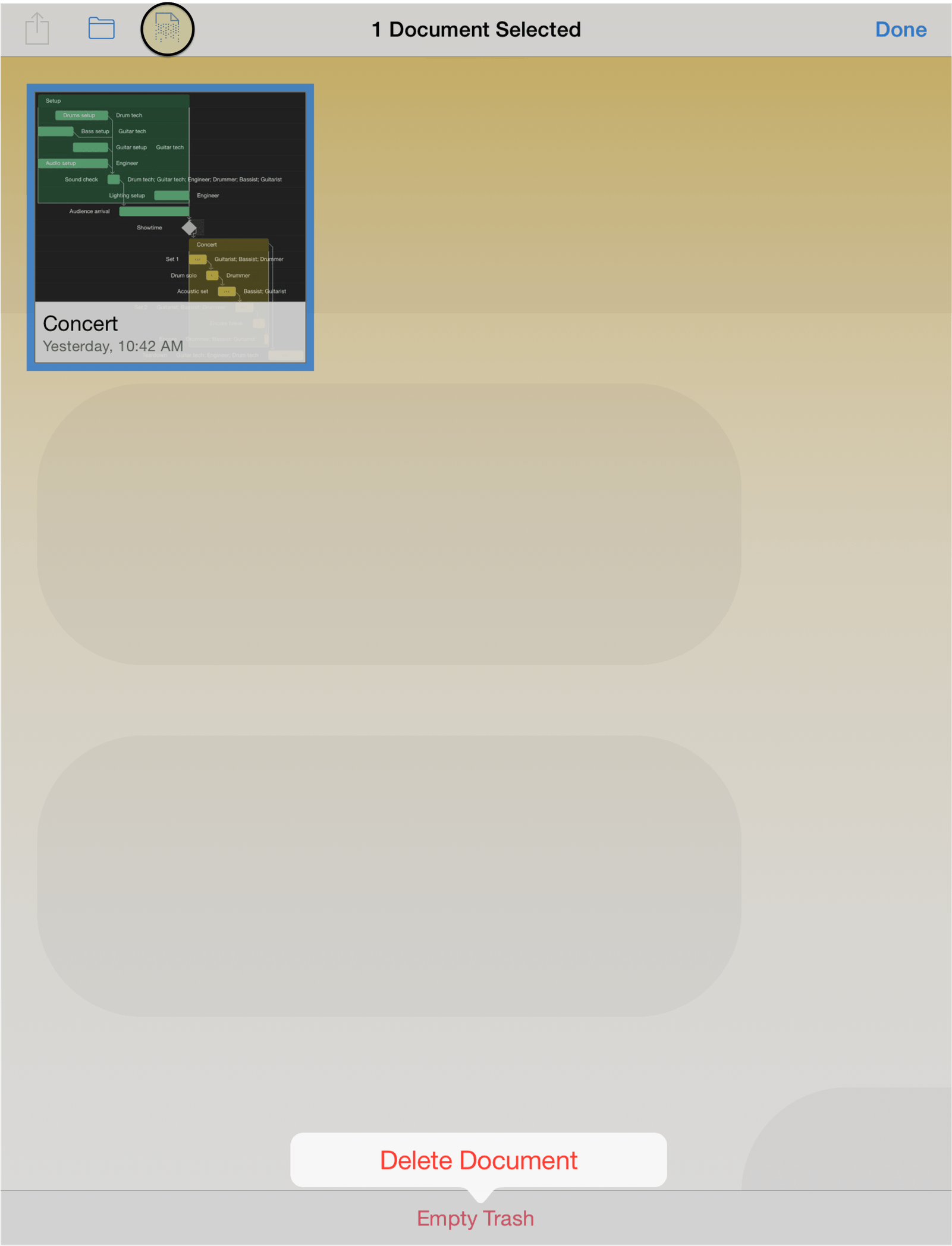
After all files in the Trash folder are deleted, you’re taken back to the Locations screen in OmniPlan.
Exporting from OmniPlan
Every now and then you’ll find the need to share some document you’ve created in OmniPlan with someone else. But with files local to your device, how are you going to do this?
When you open a folder, such as your Local Documents folder, tap Select in the navigation bar, and then select the project that you’d like to share. This places a blue highlight around the file to let you know which file you have selected.
Now tap the Share button in the navigation bar and select from one of the following options:
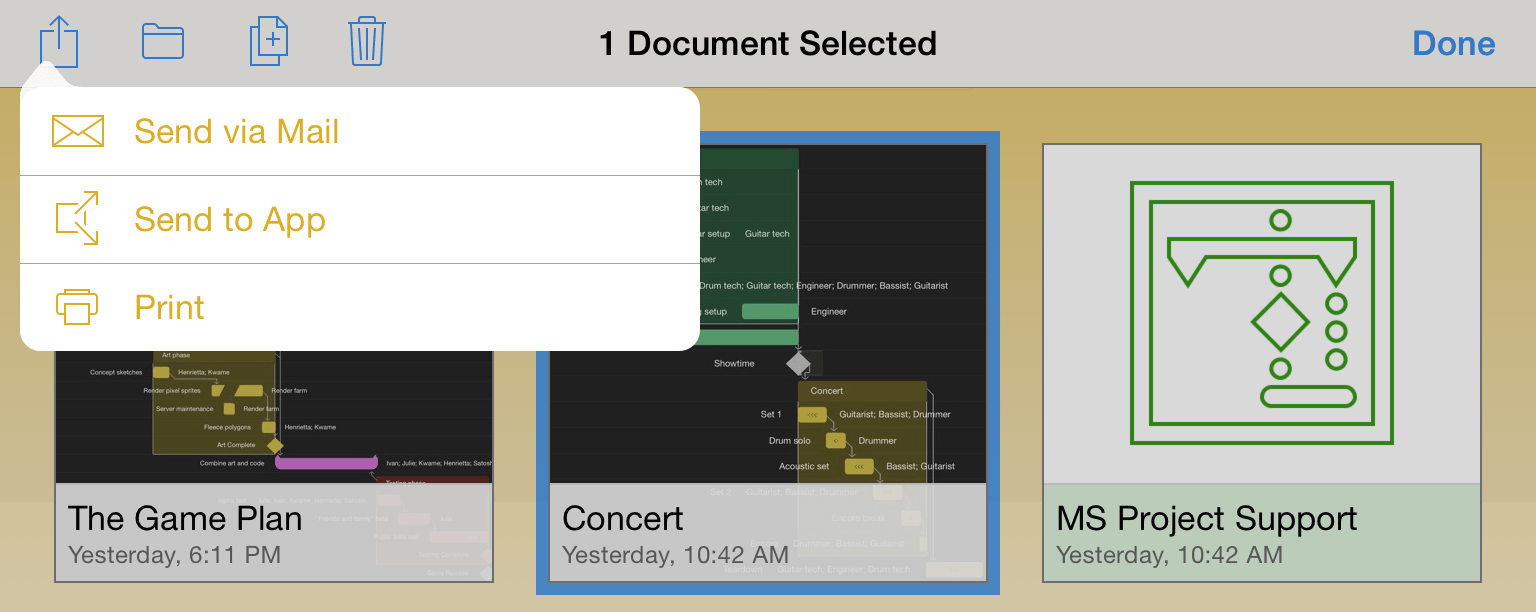
Send via Mail—lets you choose a document format for the file you want to email, and then queues up an email message for your to send.
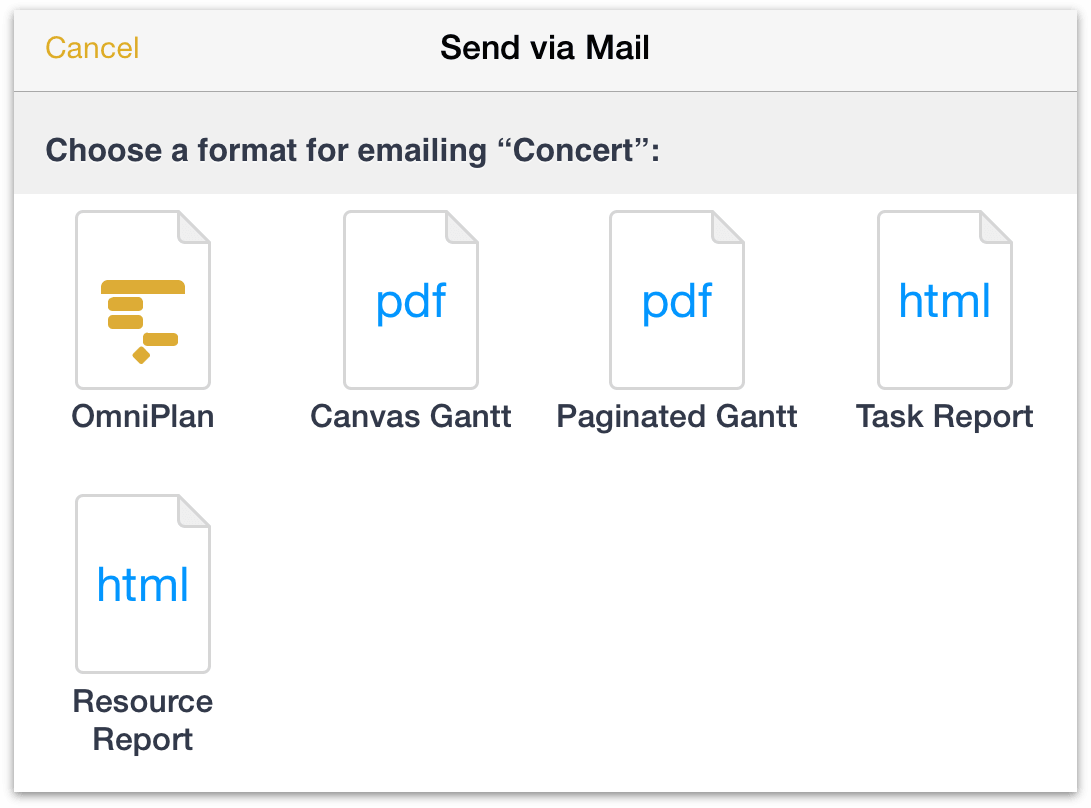
Send to App—lets you open the file in a compatible app on your device, or, if you are on a Wi-Fi network with someone you know, you can share the file with another iOS device using AirDrop. The two PDF options—Canvas Gantt and Paginated Gantt—can also be sent to iBooks or any other iOS app that can render a PDF file.
Print—lets you print the project’s Gantt chart to an AirPrint-compatible printer.
Importing to OmniPlan
If you receive OmniPlan files from elsewhere and would like to open them in OmniPlan for iOS, there are two primary ways to import files from other locations into OmniPlan on your iOS device.
Note
When using OmniPlan on other devices you own, syncing (as described in Chapter 3) is preferable to other methods. It’s faster, simpler (once set up), provides a layer of backup for your documents, and helps avoid a mess of contradictory file copies.
The first way to bring OmniPlan documents from the outside into OmniPlan for iOS is to copy them from another app. This works particularly well with Apple’s built in Mail app for iOS—you can email an OmniPlan file to yourself from anywhere, then tap the attachment and choose Copy to OmniPlan from the Send dialog that appears.
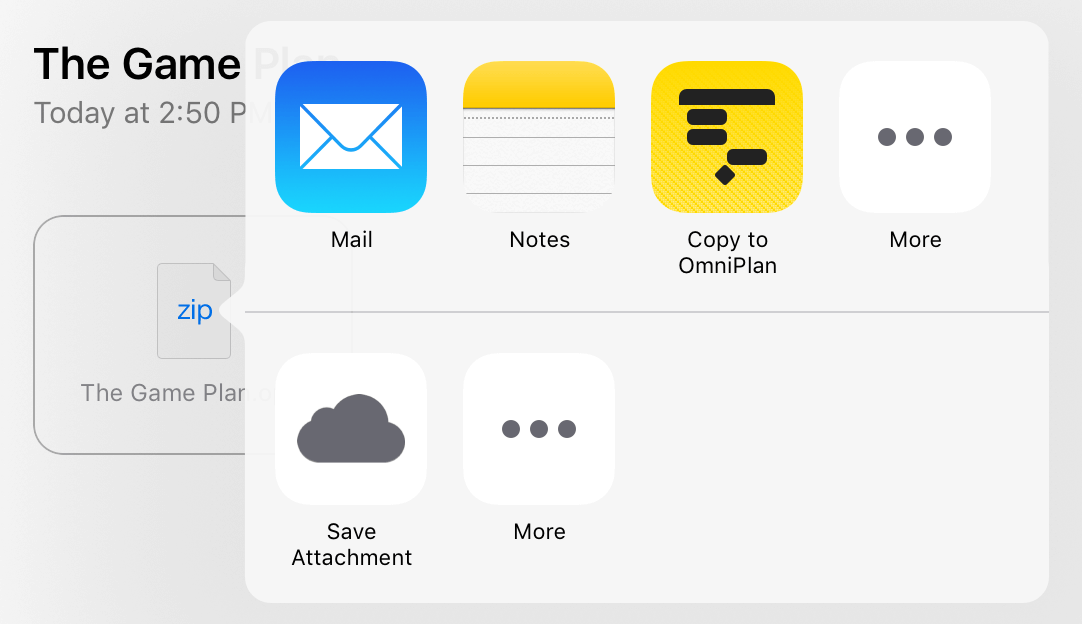
If you have a Mac or a PC with iTunes installed, a second way to transfer OmniPlan files to your iOS device is with iTunes file transfer.
- Make sure your iOS device with OmniPlan is connected to iTunes.
- Choose your device from the device list.
- Choose Apps in the device’s Settings sidebar and scroll down to the File Sharing section of the apps list
- Select OmniPlan in the list of file transfer-capable apps, and drag and drop your files into the list of OmniPlan documents.

Microsoft Project Import and Export (Pro)
With OmniPlan Pro, OmniPlan gains the ability to edit and export Microsoft Project .mpp files.
Tip
The OmniPlan Pro upgrade isn’t required to import and view your Microsoft Project documents in OmniPlan for iOS—just to edit and export them.
If you’re not sure whether OmniPlan’s Microsoft Project support will meet your project’s needs, it’s a good idea to try importing a few files first to see how they look.
With OmniPlan Pro, the option to export documents as Microsoft Project .mpp files is displayed alongside the other options when choosing Send via Mail or Send to App.
To import Microsoft Project files, select them in any app where they live on your device (such as the built-in iOS Mail app) and use that app’s Send feature to choose OmniPlan as its destination.
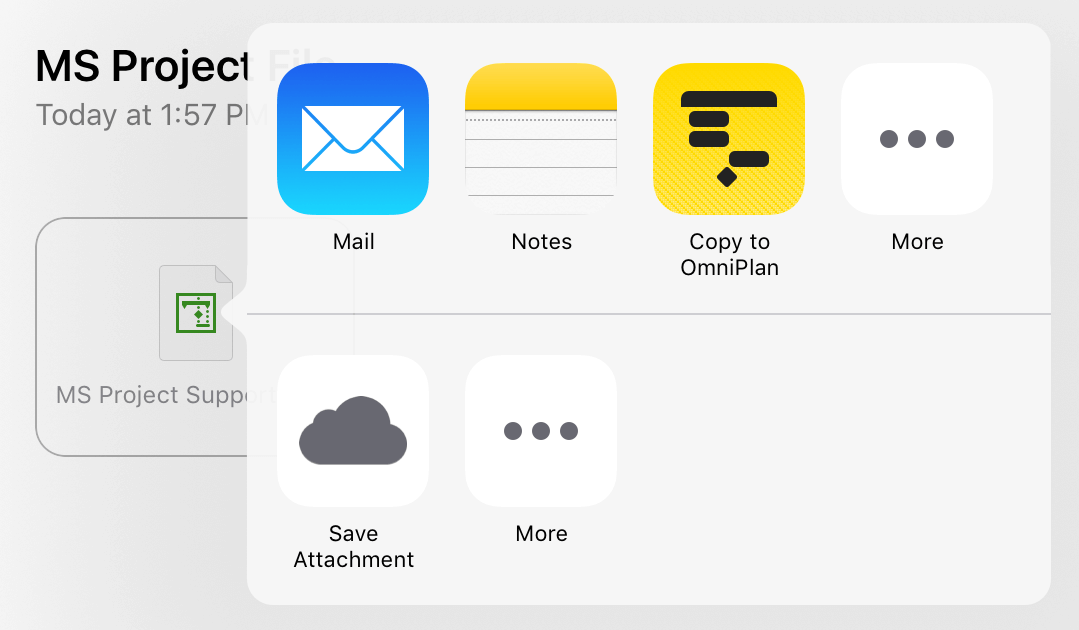
Alternatively, if you have a Microsoft Project file on your Mac or PC with iTunes installed, you can use iTunes file transfer to drag and drop documents directly into OmniPlan for iOS.
- Make sure your iOS device with OmniPlan is connected to iTunes.
- Choose your device from the device list.
- Choose Apps in the device’s Settings sidebar and scroll down to the File Sharing section of the apps list
- Select OmniPlan in the list of file transfer-capable apps, and drag and drop your .mpp files into the list of OmniPlan documents.

Microsoft Project .mpp files that haven’t yet been converted to OmniPlan’s .oplx file format are shown in the document browser with the following icon.

Once converted and saved, a Microsoft Project file appears and behaves just like any other OmniPlan document, and must be exported in the .mpp format again to be read by Microsoft Project.
OmniPlan Settings
Tap the gear icon in the Document Browser toolbar to access OmniPlan settings. You will find lots of useful information about the app here, including links to support resources, the upgrade dialog for accessing Pro features, and diagnostic reference information if you ever need technical assistance from Omni.
About OmniPlan—this displays a screen with information about the version of OmniPlan you have installed.
OmniPlan Help—this takes you a screen with links to support resources for OmniPlan, including web-based and eBook versions of this manual.
Contact Omni—this queues up an email message that you can send to the kind and wonderful Support Humans here at Omni. Don’t hesitate to ask us a question or send us feedback.
Release Notes—discover what’s new in the latest version of OmniPlan.
Restore Sample Documents—if you previously deleted any of the sample documents that came with OmniPlan, tap here to restore them to your device.
Upgrade to Pro—the Pro in-app purchase is an add-on for OmniPlan that includes multi-collaborator publication, subscription, and change tracking, Monte Carlo effort estimation simulations, the ability to import Microsoft Project files as OmniPlan files, and export of OmniPlan files to the MPP format readable by Microsoft Project 2016.
Settings—this screen provides additional privacy options for OmniPlan, and lets you choose to share anonymous device information to help us improve the app.
App Lock—to keep others from accidentally viewing or modifying your OmniPlan data, add a password (or use Touch ID) to unlock the app. See Keeping Your Work Private with App Lock for details on this feature.
Send Anonymous Data—if you’d like to help Omni improve future versions of OmniPlan, you can choose to share anonymous usage data with us. The full content of the data sent is displayed when you tap here.
Keeping Your Work Private with App Lock
If you use OmniPlan on a device that you occasionally share (with your children, coworkers, or clients, for example), there may be times when you would prefer that your OmniPlan data be out of reach.
The App Lock feature prevents accidental taps and casual glances by adding a password-locked privacy screen that must be dismissed before any of your documents or settings can be accessed.
A Note on Security
App Lock does not encrypt your data, and does not prevent someone with access to your device from connecting it to iTunes and copying your files, using VoiceOver to navigate content behind the lock screen, or deleting OmniPlan from your device outright.
App Lock is intended as a privacy feature to prevent accidental exposure or corruption of data when others are using your device. It is not meant to thwart serious attempts to access or compromise your data.
Device-level security measures are recommended for those with additional security needs.
To use App Lock, tap the gear icon ![]() in the Document Browser toolbar and choose Settings. App Lock appears in the Privacy section of Settings, and is turned off by default.
in the Document Browser toolbar and choose Settings. App Lock appears in the Privacy section of Settings, and is turned off by default.
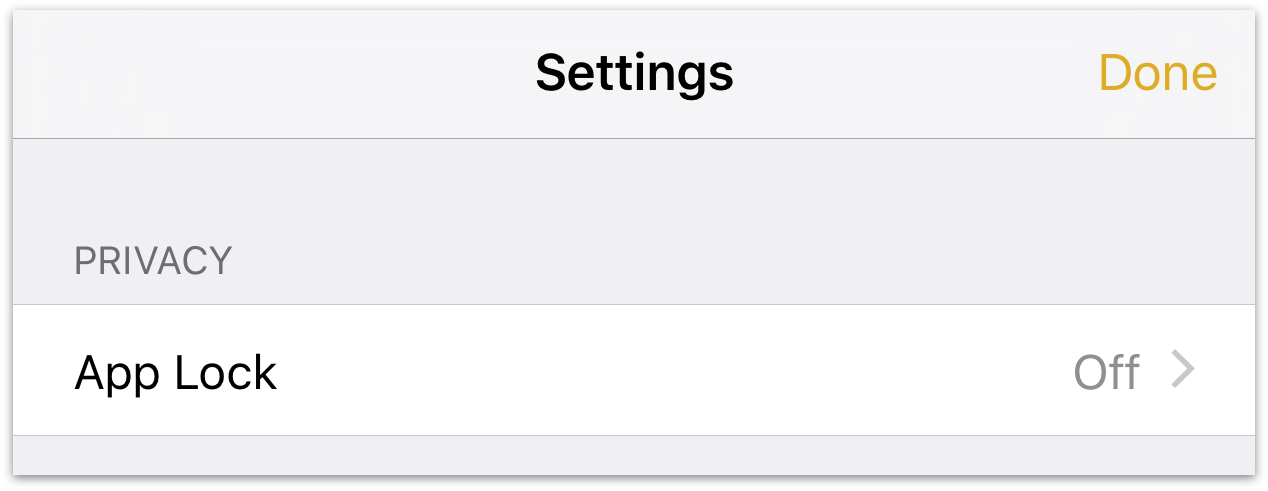
When you turn on App Lock, you will be prompted to choose and confirm a new password. If you use OmniPlan on multiple iOS devices, you need to configure and set an App Lock password on each device. App Lock passwords are device-specific and do not sync across devices.
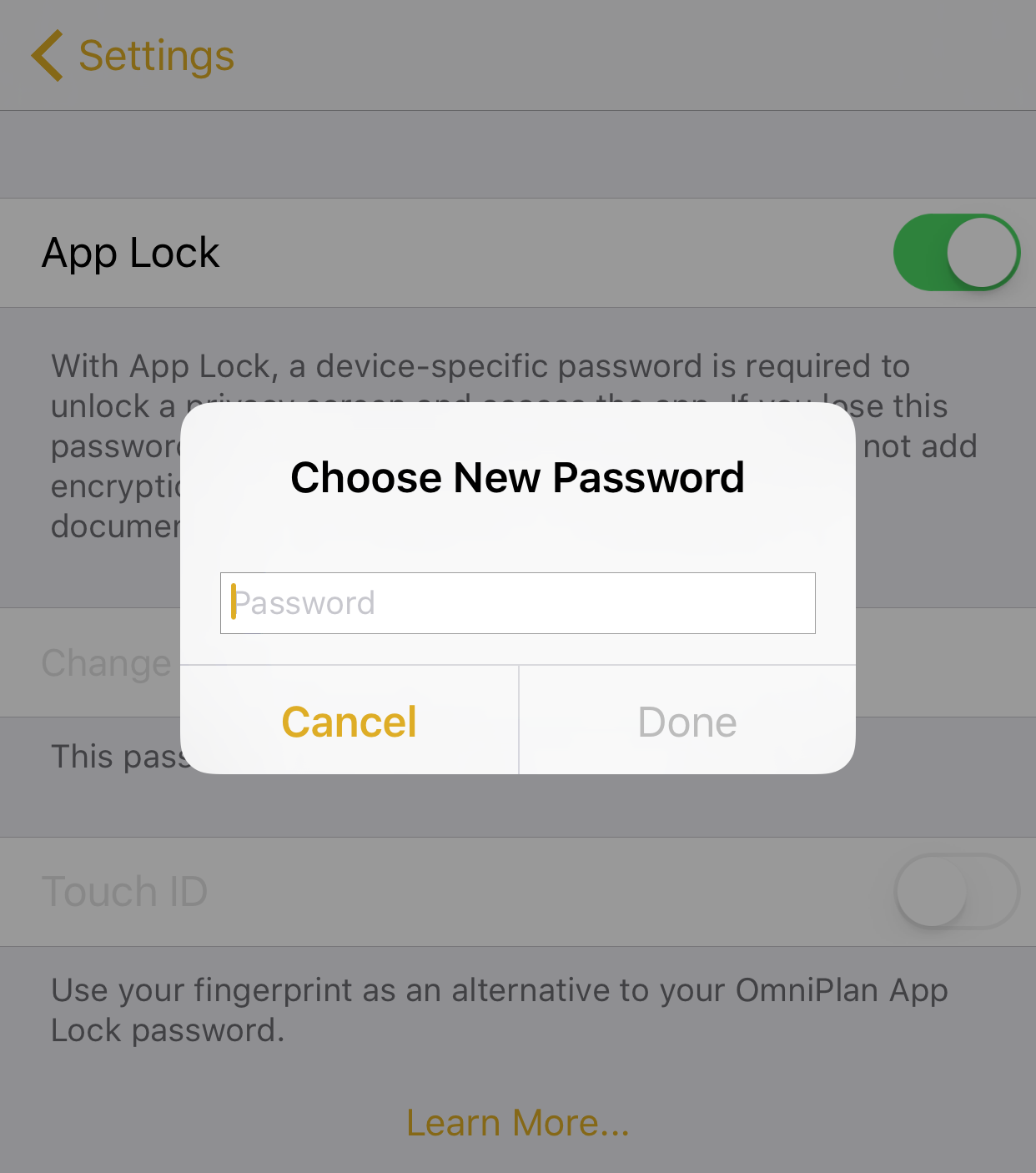
Warning
If you forget the App Lock password, OmniPlan can no longer be used on your device. However, you can retrieve your OmniPlan data by connecting your device to a computer with iTunes and copying your files to a safe location.
After saving a backup of your data, remove App Lock by deleting OmniPlan from your device and reinstalling it from the App Store. When you delete OmniPlan, your files—and your App Lock password—are deleted from the device. After reinstalling OmniPlan, you can set a new App Lock password and use iTunes again to load your OmniPlan files back onto your device.
If, however, you have your files stored in the cloud—either on Omni Sync Server via OmniPresence or some other cloud storage system—you can skip the whole iTunes process and just delete and then reinstall OmniPlan from the App Store.
After choosing a password, App Lock is turned on. The App Lock Settings screen offers the option to turn App Lock back off, change your password, or enable Touch ID as an alternative means of unlocking OmniPlan on devices that support it.
To change your password, Tap Change Password.... You are prompted to enter your old password, and then to choose and confirm a new one.
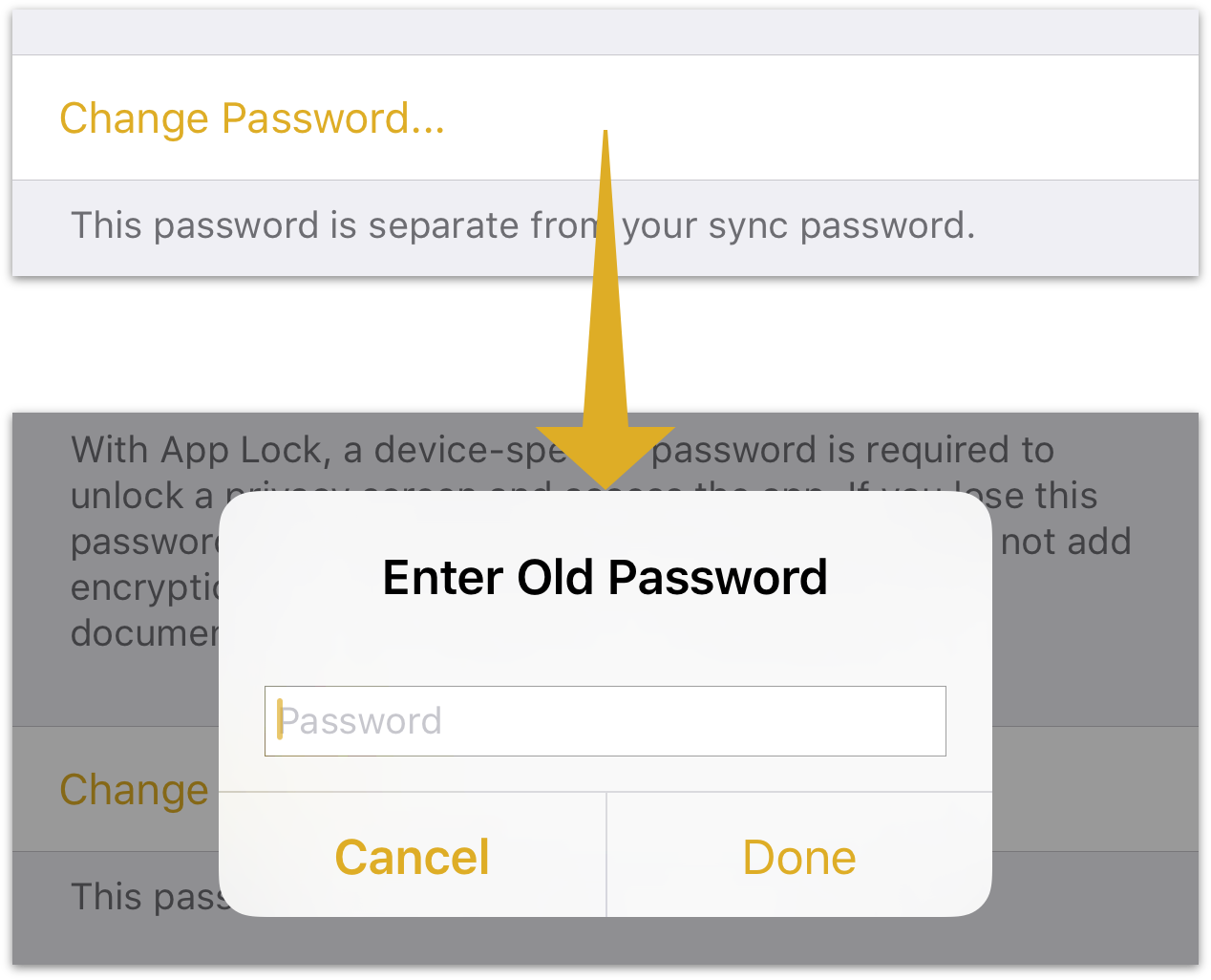
With App Lock turned on, the next time you open OmniPlan you will see a privacy screen with a field to enter the password you chose. Enter the password, and work resumes unimpeded.
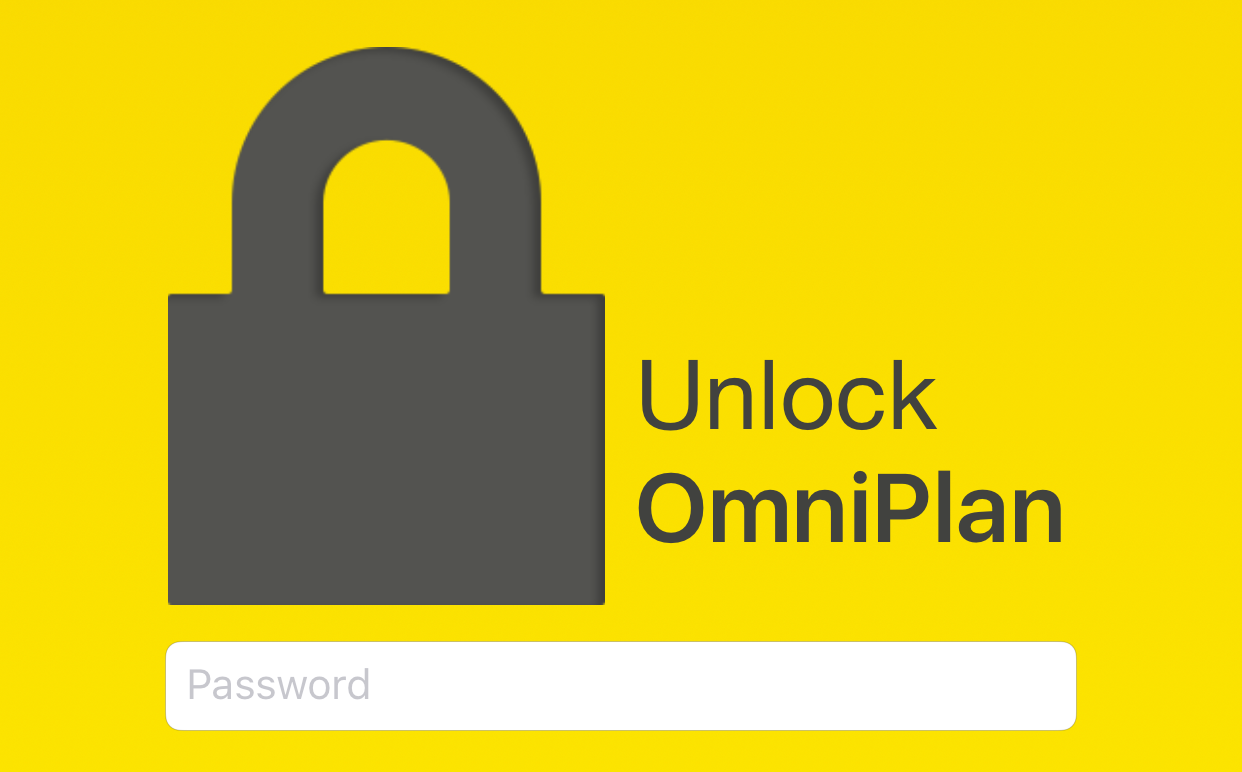
If you choose to use Touch ID, a prompt for your fingerprint will appear instead. You will still have the option to enter your password, or you can tap the fingerprint icon next to the password field to unlock with Touch ID if you dismissed the prompt initially.
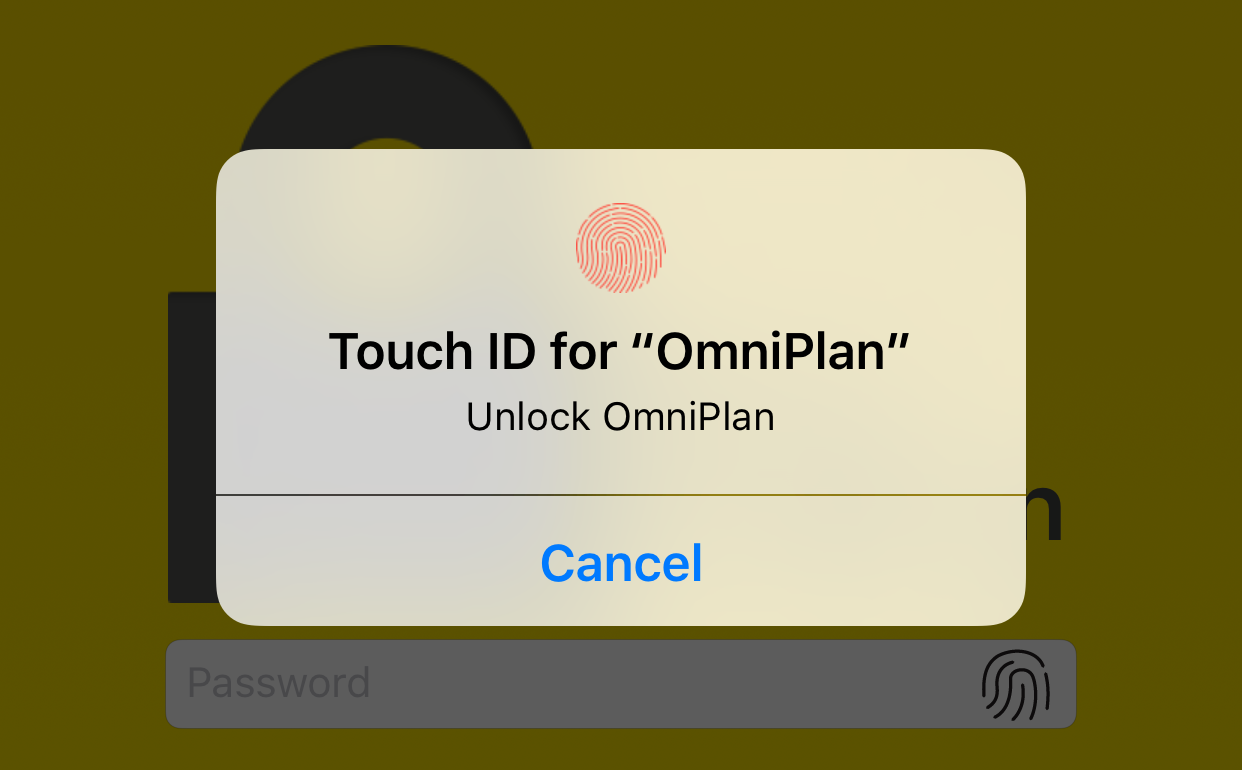
Getting Synced
By default, OmniPlan stores files locally on your iOS device. As mentioned in the previous chapter, Managing Your Project Files, your files are saved in the Local Documents folder on the device. But now that OmniPlan works across iOS devices, you can consider storing your files in the cloud. If you choose to do so, your files are accessible on any of your iOS devices with OmniPlan installed—and on your Mac if you use OmniPlan there, too.
There are two sync methods available in OmniPlan 3 for iOS. OmniPresence sync, intended for a single user to keep projects in sync across multiple devices, is available to all OmniPlan users. Publication and subscription to a server repository, useful when multiple collaborators need to contribute to a shared project, is part of the OmniPlan Pro in-app purchase upgrade. This chapter describes setting up sync in these two distinct ways.
Setting Up Single User Sync with OmniPresence
This section shows you how to create a new sync account and connect to Omni Sync Server—or another WebDAV-enabled server of your choice—via OmniPlan’s built-in OmniPresence sync service. You can add as many of these accounts as you’d like; for example, you could create a cloud account for personal use alongside separate accounts for different work clients. The only real limitation is the amount of available storage space on the device syncing with the accounts.
What Does it Mean to Work in the Cloud?
Working in the cloud means that your files are safely stored somewhere else—on a server connected to the internet—with copies of those files stored locally on your iOS device.
Whenever you make a change to a file, the file in the cloud is updated when OmniPlan performs its next sync operation (assuming that your iOS device is connected to the Internet). If it isn’t, those changes will sync the next time you connect.
Another benefit of storing files in the cloud is that, if you lose or misplace your iOS device, your documents are safe and secure on your cloud provider’s server. All you need to do to access your files is log in to your cloud account, sync the files with your new device, and then you’re back in business.
Note
Of course, your files are only as safe as the strength of your account passwords—including the Passcode (and/or Touch ID) on your iOS device. Don’t use a simple, dictionary-derived password or something that would be easy for anyone to guess, such as the name of your dog whose name and photos are plastered all over Instagram and Facebook.
Choose a strong password—or look to other iOS and Mac apps such as 1Password and its built-in Password Generator—to help keep your cloud account secure. As an additional measure, if your cloud provider offers two-step verification, you should take them up on that, too.
While most cloud services—including Omni Sync Server—maintain backups, you shouldn’t trust that your cloud provider will help you out in a pinch. Just because you are storing your files in the cloud doesn’t absolve you from backing up your files—you totally should maintain backups of all your stuff! Be sure to regularly backup your iOS device (either to iCloud or to your Mac), and maintain a regular backup schedule for your Mac, too.
Getting Started with OmniPresence
We’ll start your journey into the clouds with the path of least resistance; OmniPresence. We built OmniPresence from the ground up as a solution for our users to store files in the cloud. For you, there are two options for storage:
- Omni Sync Server, which is a bank of servers we maintain so you can store files in the cloud. OmniPresence is built into our iOS apps (there’s a desktop app for your Mac, too), so there’s nothing additional to download. All you need to do is sign up for a free Omni Sync Server account.
- WebDAV Connectivity is a hook we provide in OmniPresence so users who wish to maintain their own server can store and sync files. You can connect to your own WebDAV server, a third-party service that you trust, or you can even set up a WebDAV service on your local network using WebDAVNav Server.
Now that you know your choice of paths for using OmniPresence, let’s show you how to set them up in OmniPlan.
Creating an Omni Sync Server Account
If you plan to use Omni Sync Server with OmniPlan, you will need to set up a free account if you don’t already have one. You can create a free Omni Sync Server account online at:
Just go to that page, enter your email address, and click Sign Up. We’ll send you an email with instructions on how to set up your Omni Sync Server account.
When everything is ready to go with your Omni Sync Server account, return to the Locations screen in OmniPlan and then follow along.
Connecting to Omni Sync Server with OmniPresence
If you have an Omni Sync Server account, follow these steps to configure a cloud account:
- To start syncing to Omni Sync Server, start on the Locations screen and tap Add OmniPresence Account.
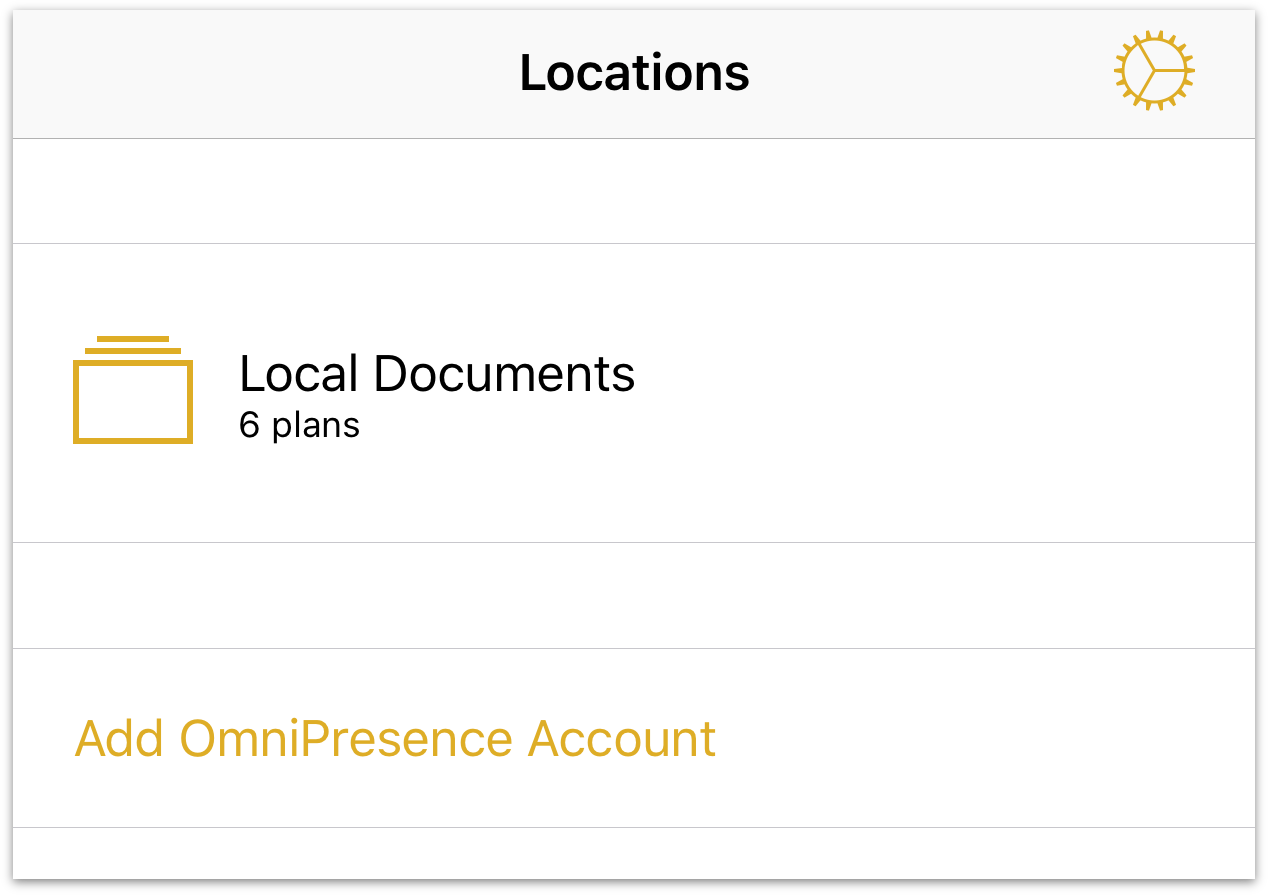
- Next, choose the type of cloud account you would like to use; you can choose between Add Omni Sync Server Account or Add WebDAV Server. The difference between the two is that we host and maintain Omni Sync Server, whereas you would need to find a third-party WebDAV server (or host your own) and entrust them to maintain the server.
Tap Add Omni Sync Server Account.
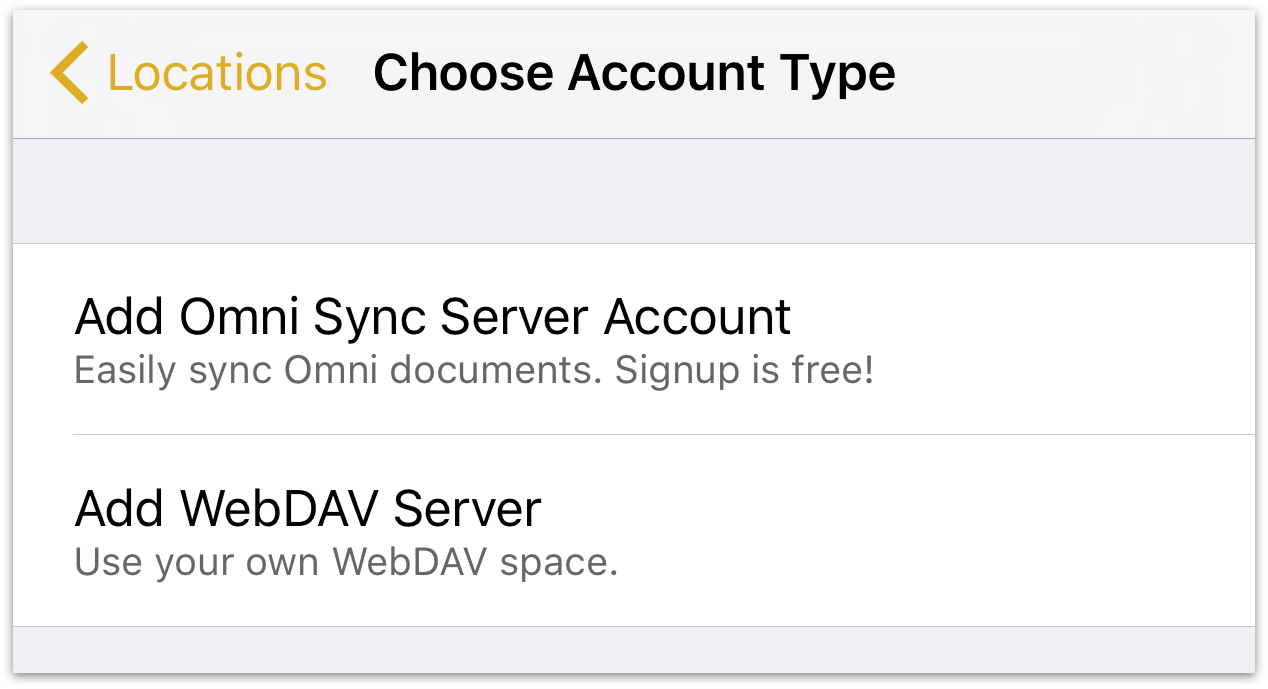
-
On the Account Info screen that appears:
- Enter your Account Name
- Enter the Password for your account
- Optionally, enter a Nickname to be used as the name for your synced folder
- Tap Save to authenticate with Omni Sync Server
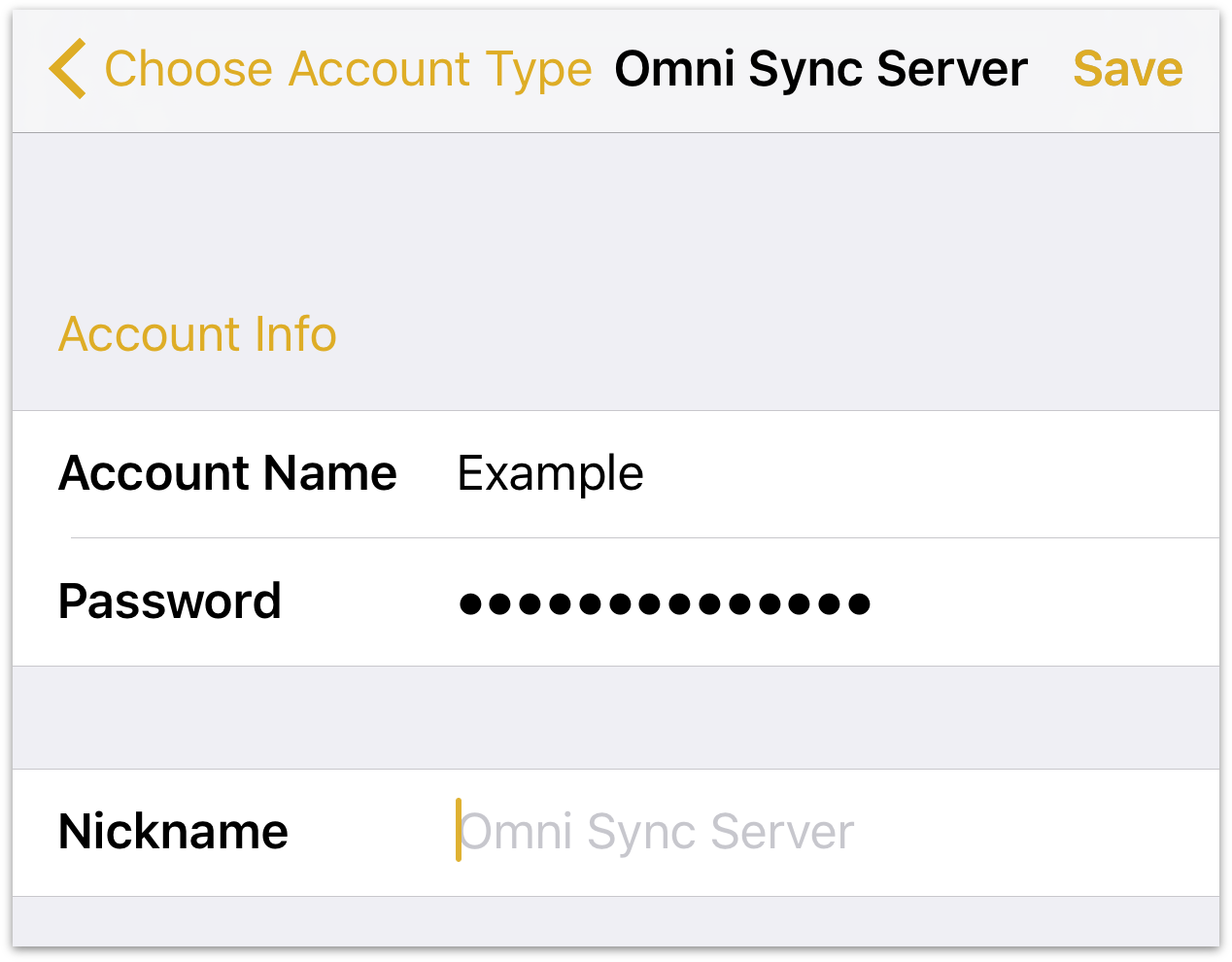
The next message you’ll see is Testing Server for Compatibility along with a progress bar. If everything checks out, OmniPlan lets you know that it has successfully connected to Omni Sync Server.
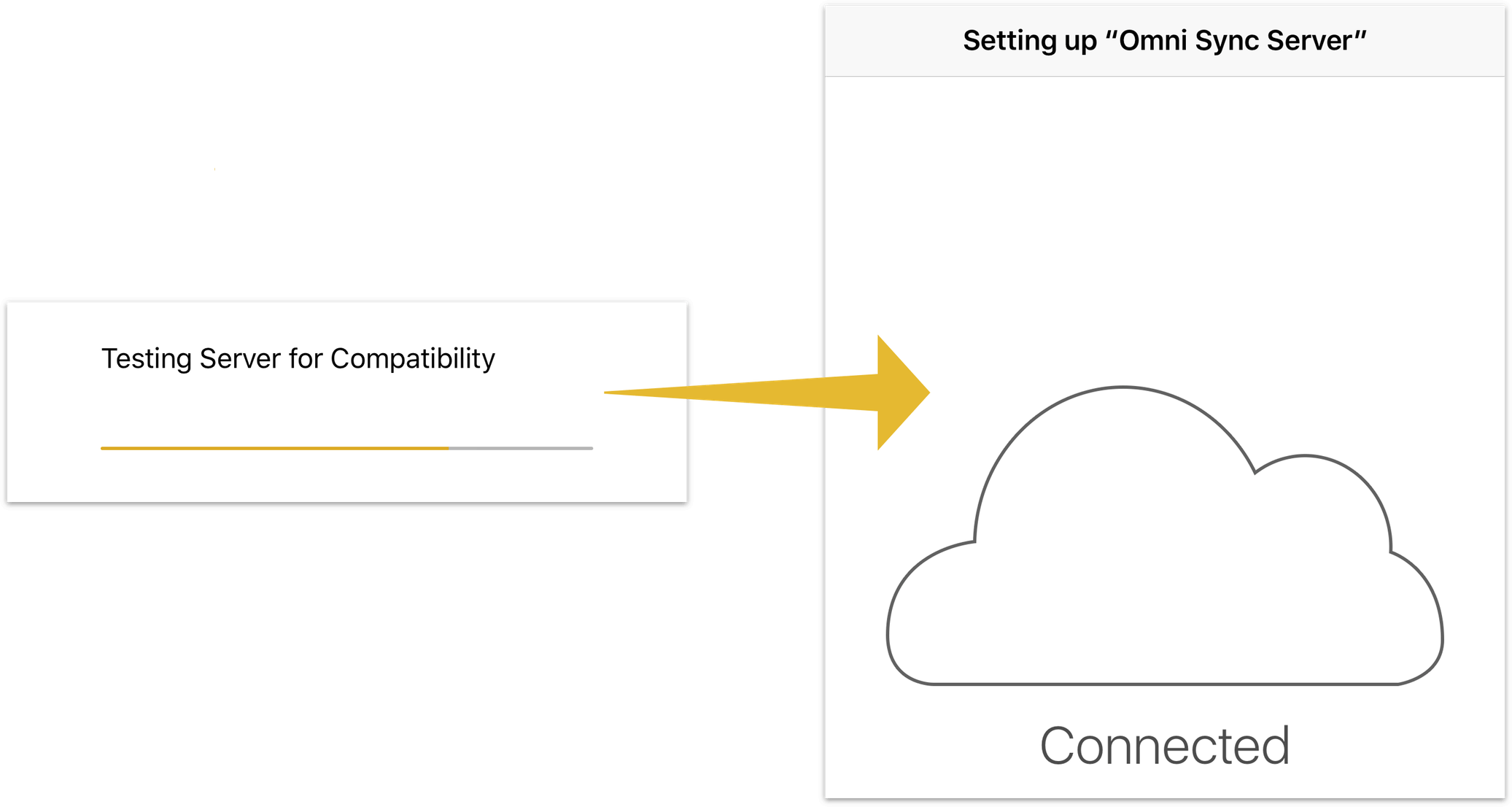
When your credentials have authenticated, you’re taken back to OmniPlan’s Locations screen where you’ll see a new folder for your synced files.
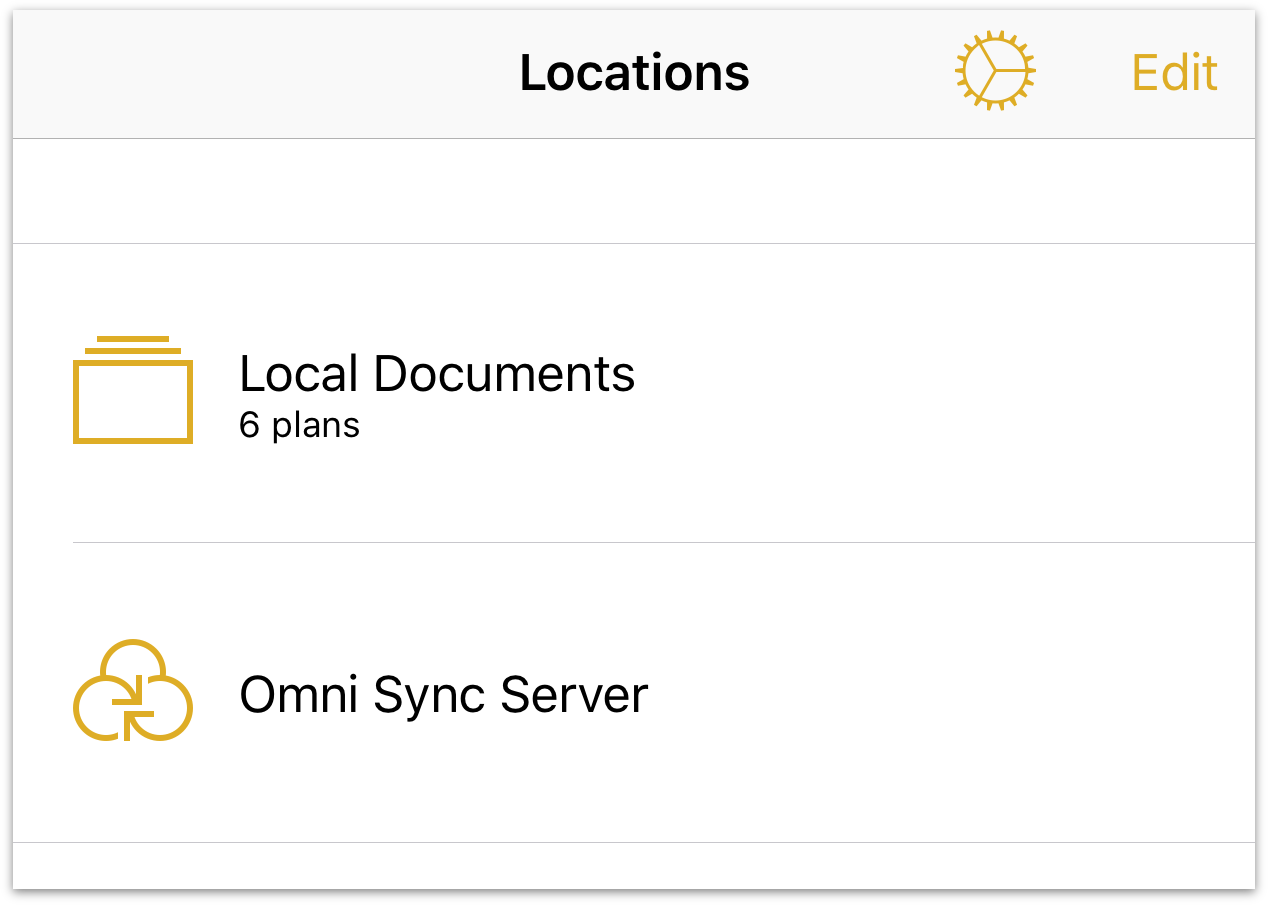
To access the files within a document folder, just tap the folder of your choice, and then tap the file you would like to work on. Or, tap the Add button (+) to create a new OmniPlan project.
Other WebDAV Options
Omni Sync Server is a great syncing solution for most OmniPlan users. If your sync needs require that your data be kept completely within a system you control, you can configure a private WebDAV server to sync your OmniPlan files. This can be a third-party server (there are many fine providers out there) or one that resides on your own Mac.
While we’re not able to provide comprehensive support for WebDAV servers we don’t administrate (since it isn’t our software), we’re glad to help you get started with some pointers.
See this support article for information on Apple’s Server.app for use in setting up a WebDAV server on OS X. Another option for setting up WebDAV on your Mac is WebDAVNav Server, which is free on the Mac App Store.
Warning
When you expose files and folders on your computer to the Internet (even with strict password protection), you assume some risk. Make sure you understand this risk before setting up a server, and be sure to keep your server up to date with the latest security patches. If you’d prefer not to host your own server, you can sign up for a free Omni Sync Server account or use another standards-compliant WebDAV host to sync files with OmniPlan.
Connecting to WebDAV Servers with OmniPresence
On the Account Info screen that appears, follow these steps:
- Enter the URL for the Location of your WebDAV Server
- Enter your Account Name
- Enter the Password for your account
- Optionally, enter a Nickname to be used as the name for your synced folder
- Tap Save to authenticate with the WebDAV server
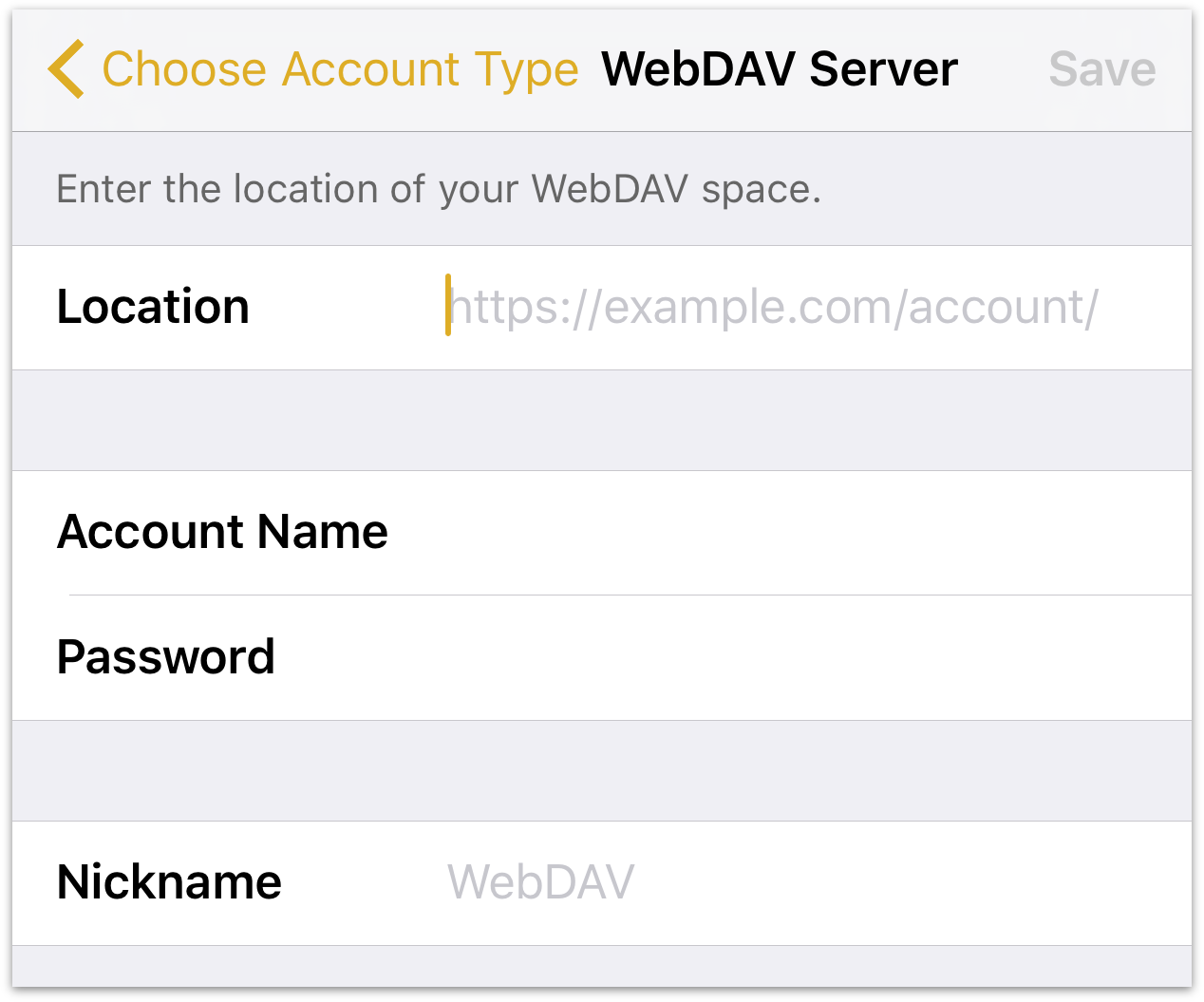
As with connecting to Omni Sync Server, OmniPlan informs you that it is Testing Server for Compatibility, and displays the Connected screen when it has connected to the WebDAV server successfully.
Monitoring OmniPresence
When you have configured OmniPlan to use either type of cloud account (Omni Sync Server or WebDAV), you’ll notice an OmniPresence icon in the toolbar of connected cloud folders.

Keep an eye on this icon to monitor OmniPresence’s sync status:
 — denotes that OmniPresence is active and ready to sync files to the server.
— denotes that OmniPresence is active and ready to sync files to the server. — denotes that a sync is currently in progress.
— denotes that a sync is currently in progress. — denotes that your iOS device does not have access to an active Wi-Fi or cellular network.
— denotes that your iOS device does not have access to an active Wi-Fi or cellular network. — denotes that there was an error when trying to sync your files. You may see this icon if another device is working on the same file, or if a connection cannot be made to the sync server you are using. Try tapping the OmniPresence icon again and if you get the same error icon, please contact our Support Humans for assistance.
— denotes that there was an error when trying to sync your files. You may see this icon if another device is working on the same file, or if a connection cannot be made to the sync server you are using. Try tapping the OmniPresence icon again and if you get the same error icon, please contact our Support Humans for assistance.
OmniPresence checks in with your active sync servers every minute or so, and saves any updates you’ve made to the server. OmniPresence also saves a version of your file to the server whenever you close a file or switch from OmniPlan to another app on your device. Alternately, you can tap the OmniPresence icon to force an update to the server at any time.
Multi-User Publication and Subscription (Pro)
Publishing a project to a shared server repository provides an additional level of resource administration and change tracking not available with standard single-user OmniPresence syncing. Keeping changes gated for approval prevents local versions of the project from being modified remotely without oversight, making this the preferred sync method for working collaboratively with multiple users. To learn more about the benefits provided by publication, subscription, and change tracking, see Chapter 7: Multi-User Collaboration (Pro).
Note
Sync in the form of publishing and subscribing to a shared server repository (the process described in this section) is a feature available separately as part of the Pro upgrade to both OmniPlan 3 for iOS and OmniPlan 3 for Mac. Both the iOS and Mac apps must be upgraded to Pro to use pub/sub to sync between them.
With OmniPlan Pro installed, alongside Add OmniPresence Account on the Locations screen you’ll also find the Pro-only Server Repositories sync option. To work on a project accessible for editing by multiple OmniPlan users, start by tapping here.

You’ll see the OmniPlan Server Repositories screen, from which you can choose either Add Omni Sync Server Account or Add WebDAV Account.
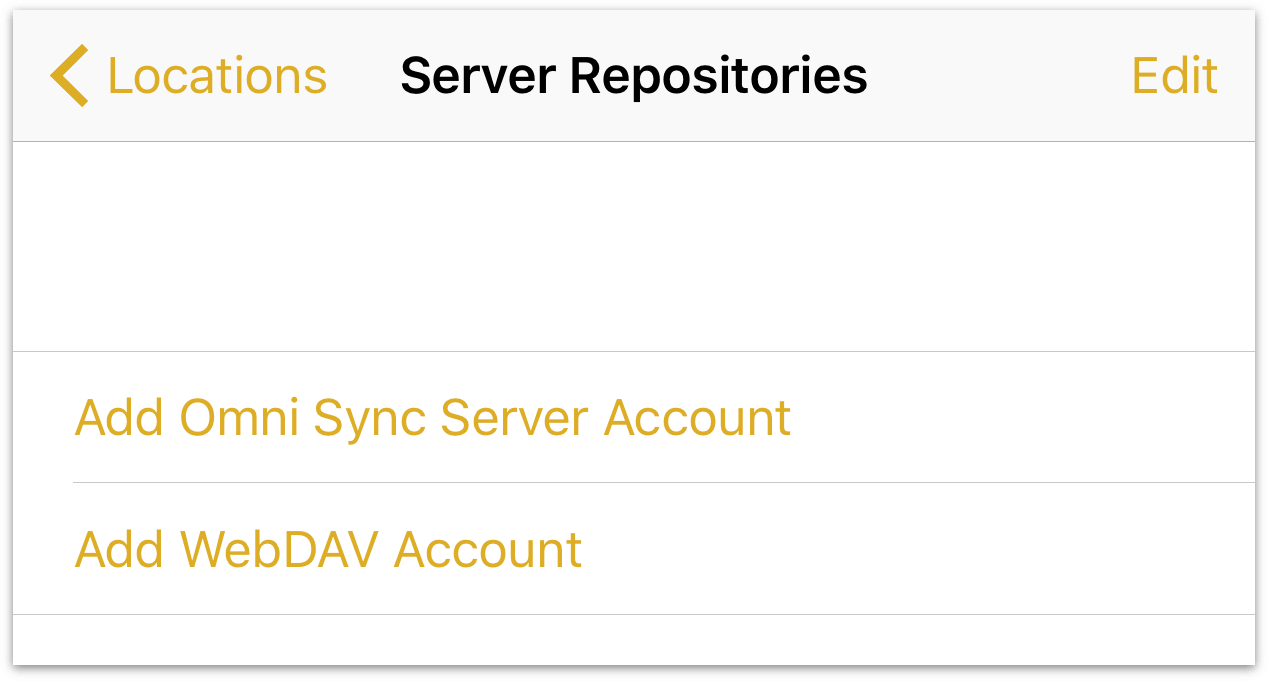
You can create a free Omni Sync Server account online at sync.omnigroup.com; see Creating an Omni Sync Server Account for details on the account creation process.
Warning
Omni Sync Server is available as a cloud sync option for both OmniPresence sync and server repository based publication and subscription. However, these two methods rely on different mechanisms under the hood and are not compatible.
Files stored with OmniPresence on Omni Sync Server (or another WebDAV server) are not accessible via publication and subscription, and vice versa.
Connecting to an Omni Sync Server Account
Tap Add Omni Sync Server Account, and on the Server Details screen that appears:
Enter your Username.
Enter the Password for your account.
Set the default Path (or folder) to use for the shared repository. By default, OmniPlan uses the root directory (as denoted by the slash, / ), but you can change this to another folder; for example, using /OmniPlan assumes you have a folder named OmniPlan at the root level of your Omni Sync Server directory.
Optionally, enter a Description that will be used on the Locations screen as the name for your synced folder.
Tap Connect to authenticate with Omni Sync Server.
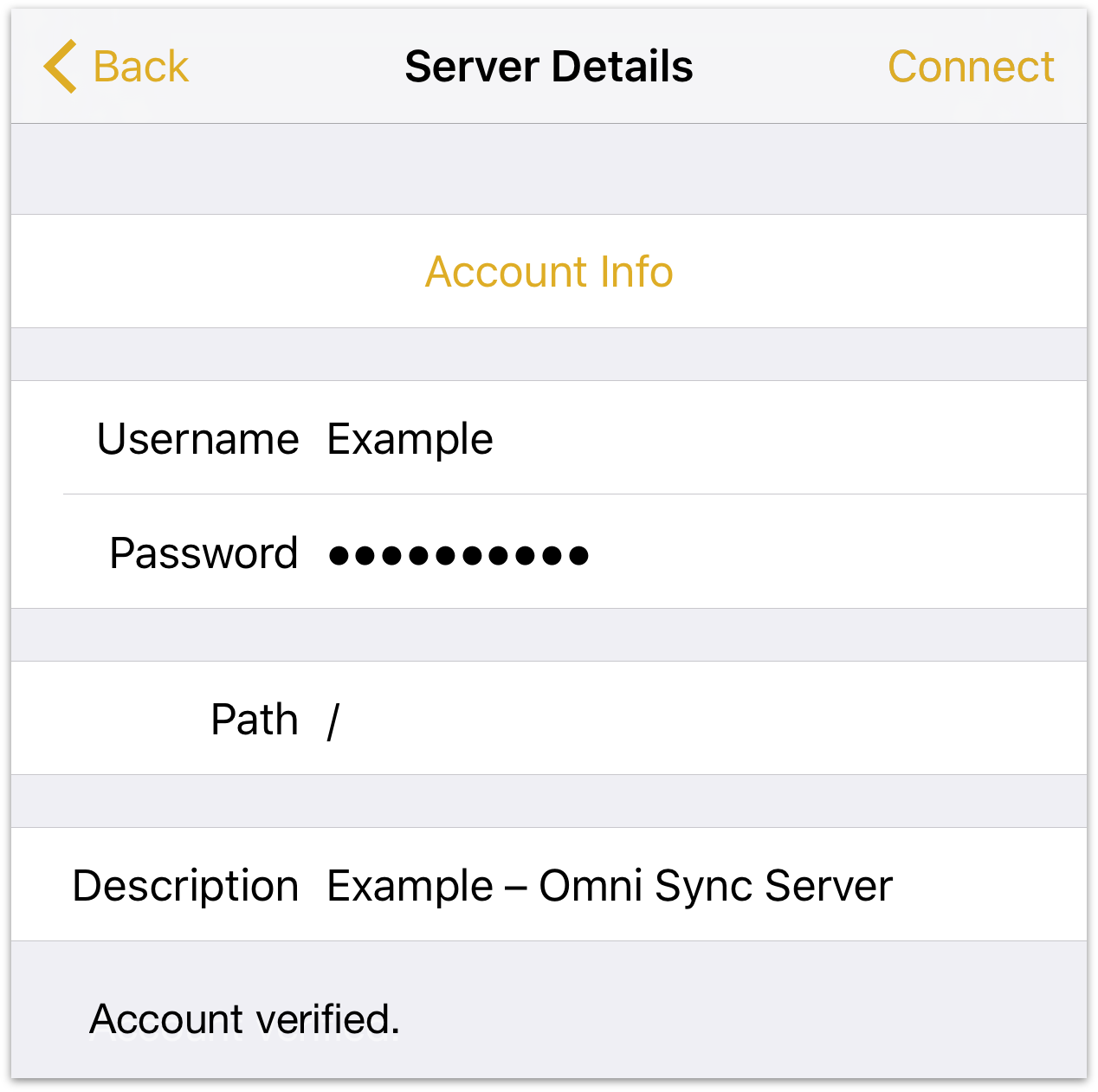
When you tap Connect you’ll see Checking account… at the bottom of the window. When your account information has been validated, the text changes to Account verified and the Omni Sync Server folder is added to OmniPlan on your device.
Connecting to a WebDAV Account
Tap Add WebDAV Account, and on the Server Details screen that appears:
Enter the Address (in the form of a URL) for your WebDAV server.
Enter your Username.
Enter the Password for your account.
Optionally, enter a Description that will be used as the name for your synced folder.
Tap Connect to authenticate with your WebDAV server.
When you tap Back, you’ll see a list of your available server repositories.
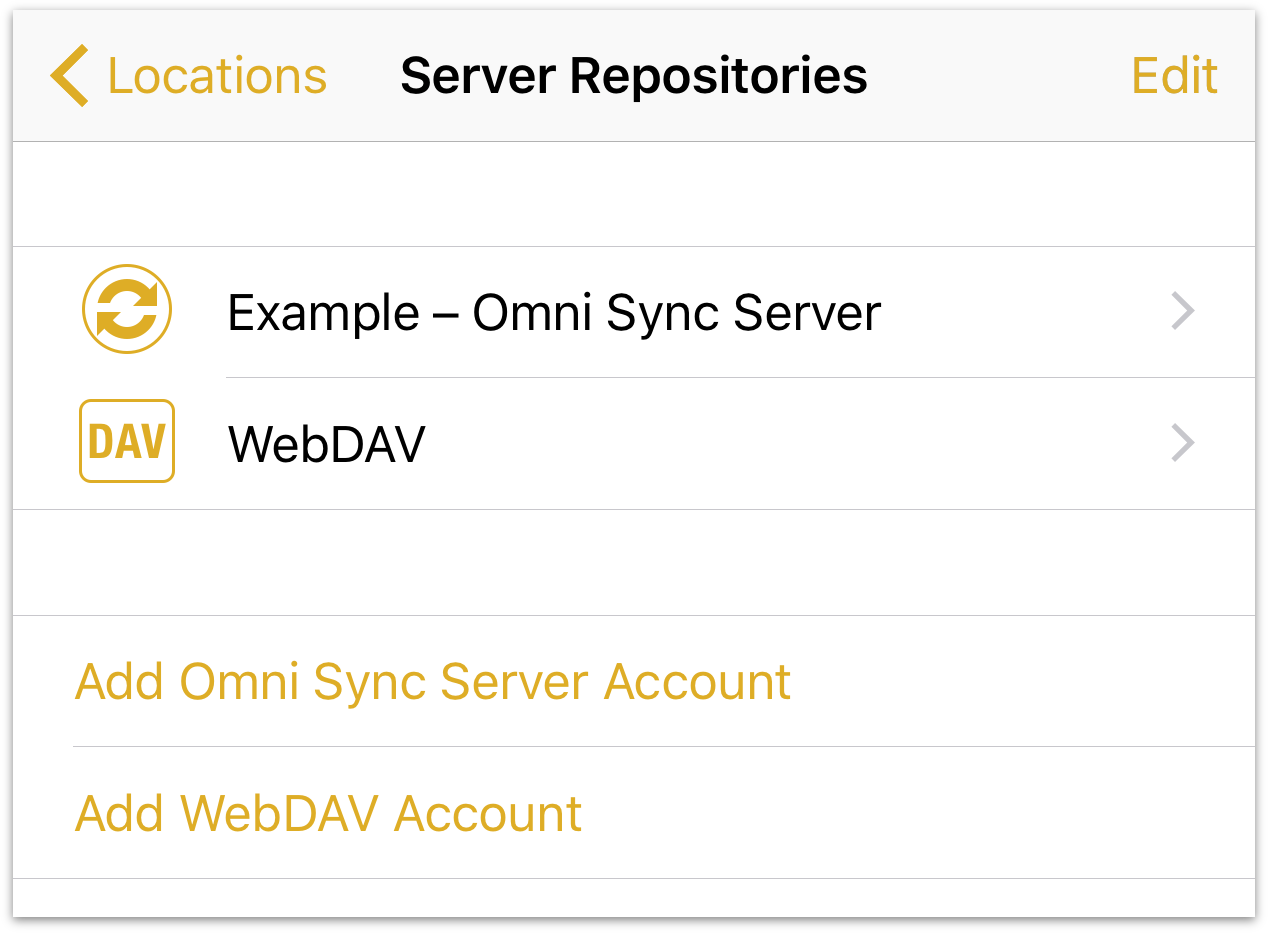
To remove an account, tap Edit; a delete handle appears to the left of the account name. If you tap the delete handle, the account name slides to the left and a Delete button appears on the right edge; tap that to delete the account. A quicker way to do this is to just swipe left across the account name to bring up the Delete button. If you change your mind before deleting the account, tap Done and the Delete button goes away.
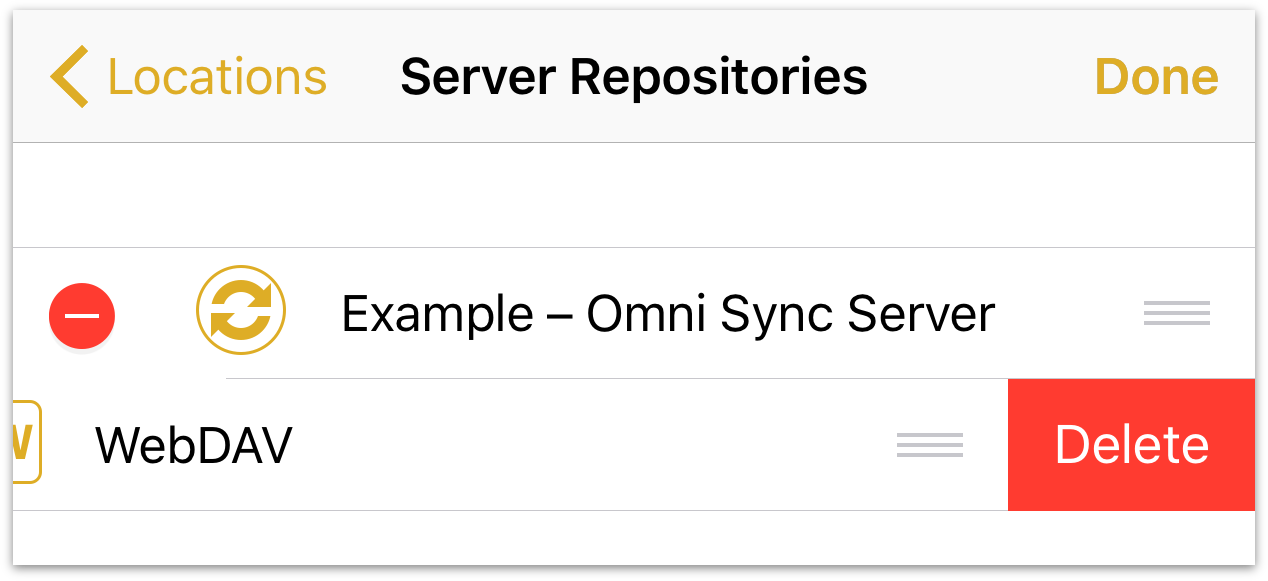
Warning
Undo will not restore an account that you delete. If you delete one (or all) of your repository accounts, you will need to complete the account setup process again to restore access to that repository.
Tap Locations to return to the Locations screen, where you’ll see the Local Documents folder along with any synced services you’ve added to OmniPlan.
Accessing Documents for Publication and Subscription
With a server repository account connected, tap its name in Server Repositories to see a list of projects synced to that account. To edit one of these projects locally, tap it and it will be downloaded to your Local Documents folder.
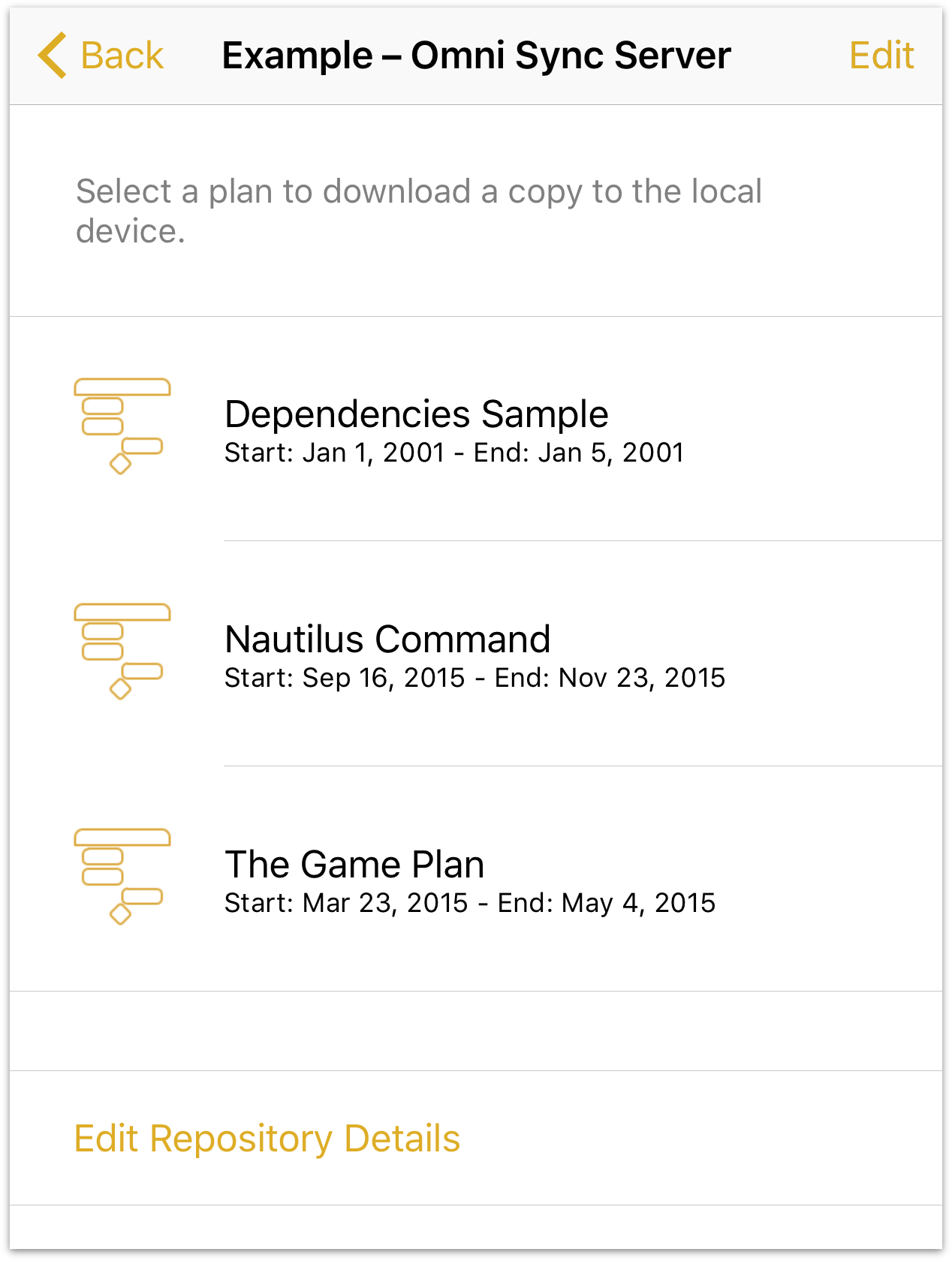
Note
Publishing and subscribing to files in a server repository has a special meaning within OmniPlan. Unlike OmniPresence sync, it’s not just a way to access files from multiple devices. For more on how to collaborate with OmniPlan, see Chapter 7: Multi-User Collaboration (Pro).
Working in the Project Editor
When the time comes to build a new project or edit an existing one, tap the project in the document browser to enter OmniPlan’s Project Editor. The Project Editor consists of the Gantt chart, Network Diagram and associated controls you’ll use to add and manage the tasks, resources, and calendars that form your project.
This chapter describes navigating the Project Editor and outlines the tools available within. As you read, one option is to dive right in and start building a new project. However, if you’re new to OmniPlan, exploring one of the pre-populated sample projects may help provide some initial context. The next chapter, Building a Project, offers a tutorial for when you’re ready to begin building in earnest.
As you explore the Project Editor, there are a few navigational tools that can help you get your bearings and fully contextualize the scope of the project at hand.
Landscape Mode—Because tasks progress chronologically along the x-axis of both the Gantt chart and Network Diagram, their information is presented most efficiently in landscape mode. Rotate your device to try it out—it’s where OmniPlan for iOS is most comfortable.
Pinch to Zoom—Many projects have more tasks than will fit on the screen at once at the default zoom level. When you need to view an entire project, use the vertical pinch gesture to zoom in or out.
Changing Time Scale—In the Gantt chart, pinch horizontally to change the view’s time scale on the fly, or tap the date header to choose a scale from among granular options (including the ever-handy Scale to Fit Project).
Navigating the Project Editor
While the capabilities of OmniPlan’s Project Editor are identical across iOS devices, button placement varies slightly based on device size. The following figure shows the layout for larger devices (iPads and larger iPhones), along with the bottom toolbar on smaller devices that contains the row of inspector buttons.
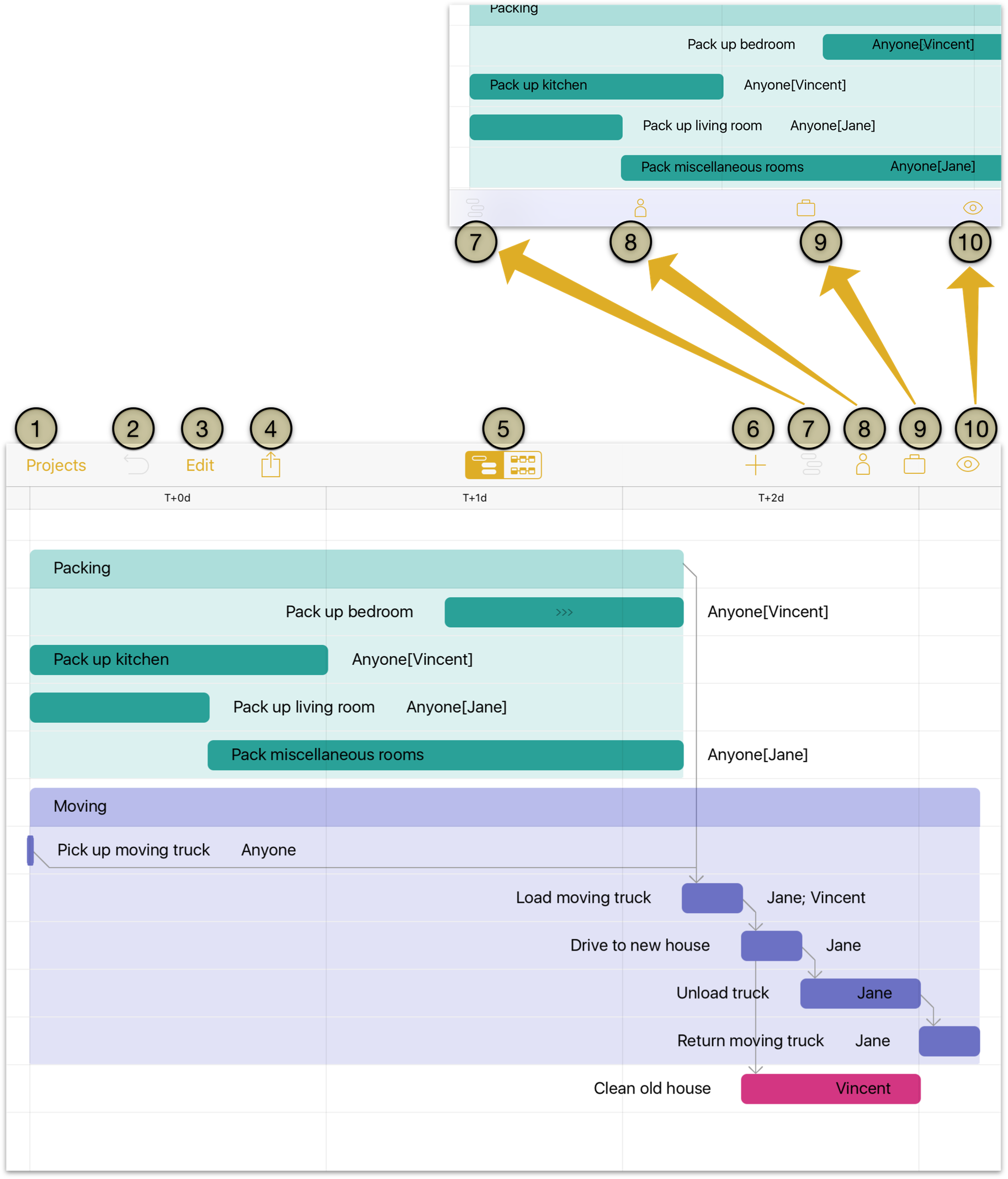
The numbered controls correspond to the tools that make OmniPlan’s Project Editor tick. These tools are available both in the Gantt chart and in the Network Diagram, and function similarly in each view.
Projects—tap to exit the project you’re working on and return to the current folder in the Document Browser.
Undo/Redo—tap to undo or redo the previous change.
Edit—tap to enter edit mode and reveal the editing controls at the bottom of the screen. See Working in Edit Mode for details.
Share—tap to choose an export method for the current project: Send via Mail, Send to App, or Print.
View Switcher—tap to switch between the Gantt chart and Network Diagram views.
Add—tap to add a new task to the project. Touch and hold to add a new Task, Milestone, or Group from the popover menu that appears.
With a task selected in the Gantt chart, choose Set Task Default from the popover to designate it as the default for new tasks added to the project. Subsequently created tasks will be added as copies of the default task, complete with pre-filled name, duration, and resource assignments.
Task Inspector—with a task or group selected, tap to open the Task Inspector. Use the Task Inspector to customize various aspects of the task across three panes: Task Info, Scheduling, and Assignments.
Resources Inspector—Use the Resources Inspector to create and edit resources (Staff, Equipment, Materials, and Groups), and to modify their calendars of working hours.
Project Inspector—use the Project Inspector to set the structure and parameters for your project.
View Inspector—use the View Inspector to set a project filter, turn on change tracking, check for violations, and view baselines and critical paths.
Using the Gantt Chart
The Gantt chart is a chronological list of the tasks that comprise your project, displayed as horizontal bars whose length represents their duration. Tasks that depend on other tasks are connected via a series of stepwise dependencies (dependencies are explained in greater detail in the Building a Project chapter). The Gantt chart is where you will spend much of your time in OmniPlan for iOS—whether you’re creating a new project or guiding one to fruition, this is where the hard work comes together.
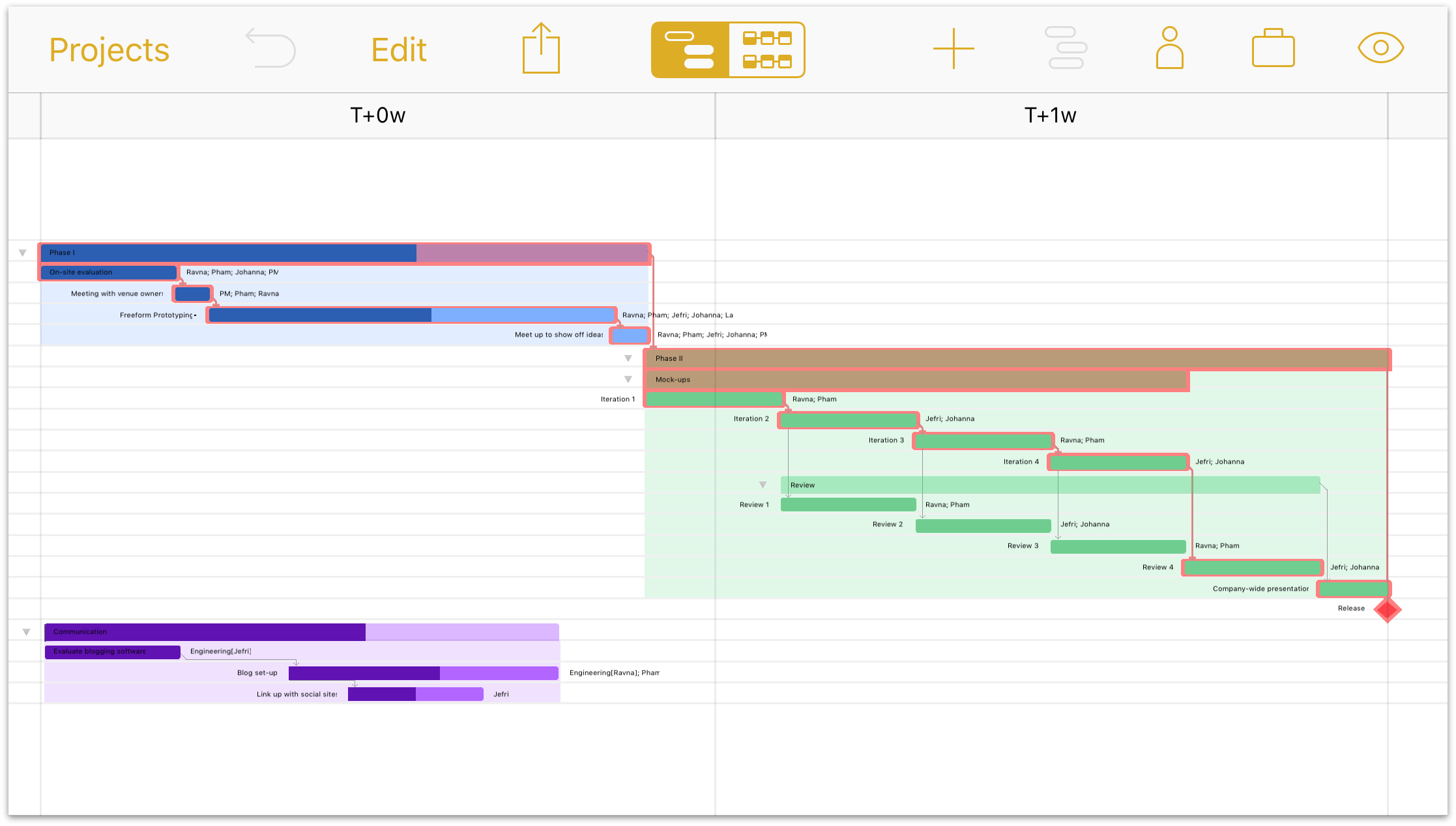
Working in Edit Mode
The Add button in the toolbar—mentioned in the Project Editor section—is the easiest way to rapidly add tasks to your project. But beyond simply adding new tasks and milestones, the Gantt chart includes a suite of editing tools that provide more fine-grained control over your tasks and the relationships between them.
Tap Edit in the toolbar to enter edit mode and reveal the editing controls at the bottom of the screen. Selecting an item (or multiples) allows the following actions to be performed.

Cut—Delete the selected item or items and copy them to be pasted later. Paste by tapping Done to exit edit mode and touching and holding an item on the Gantt chart to reveal the contextual menu. When pasted, the copied items will appear below the one selected.
Copy—Copy the selected item(s) to be pasted later.
Delete—Delete the selected item(s) from the Gantt chart.
Group/Ungroup—With multiple items selected, Group creates a group containing those items. With a group selected, Ungroup removes the grouping container (but not the tasks inside it).
Move—Move the selected item or items elsewhere in the Gantt chart.
To move an item or items in edit mode, tap to select them, then tap Move. To choose their destination, tap another row. A contextual menu appears that provides three location options: Above the chosen row, Below it, and Inside. Choosing Inside converts the chosen row into a group (if it isn’t one already) and adds the items to be moved as tasks inside it.
Connect/Disconnect—With multiple items selected, this command connects them with finish ▸ start dependencies (if they’re not already connected) or removes dependencies between them (if they’re currently connected).
Using the Network Diagram
A project’s Network Diagram offers an elegant, visually descriptive view that depicts the project’s tasks as a collection of nodes connected by dependencies. Whether used as a tool for rapidly prototyping a new project or getting a handle on the complexities of an existing one, using the Network Diagram provides a great new perspective on your project.
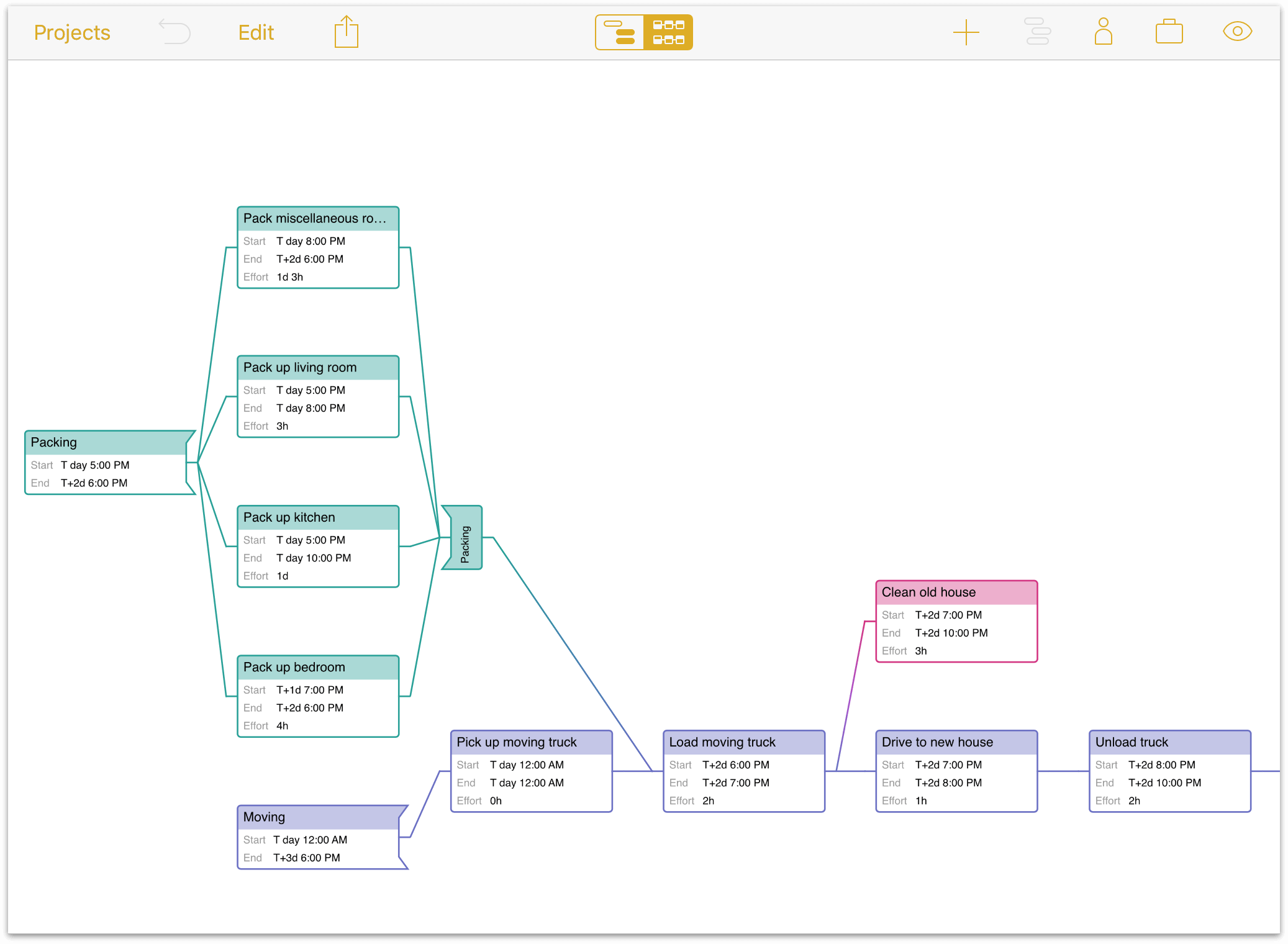
Charting Tasks and Dependencies
When you’re ready to start building (or adding to) a project in Network View, tap the View Switcher to toggle away from the Gantt chart, and tap Add. That’s it! A new task is created.
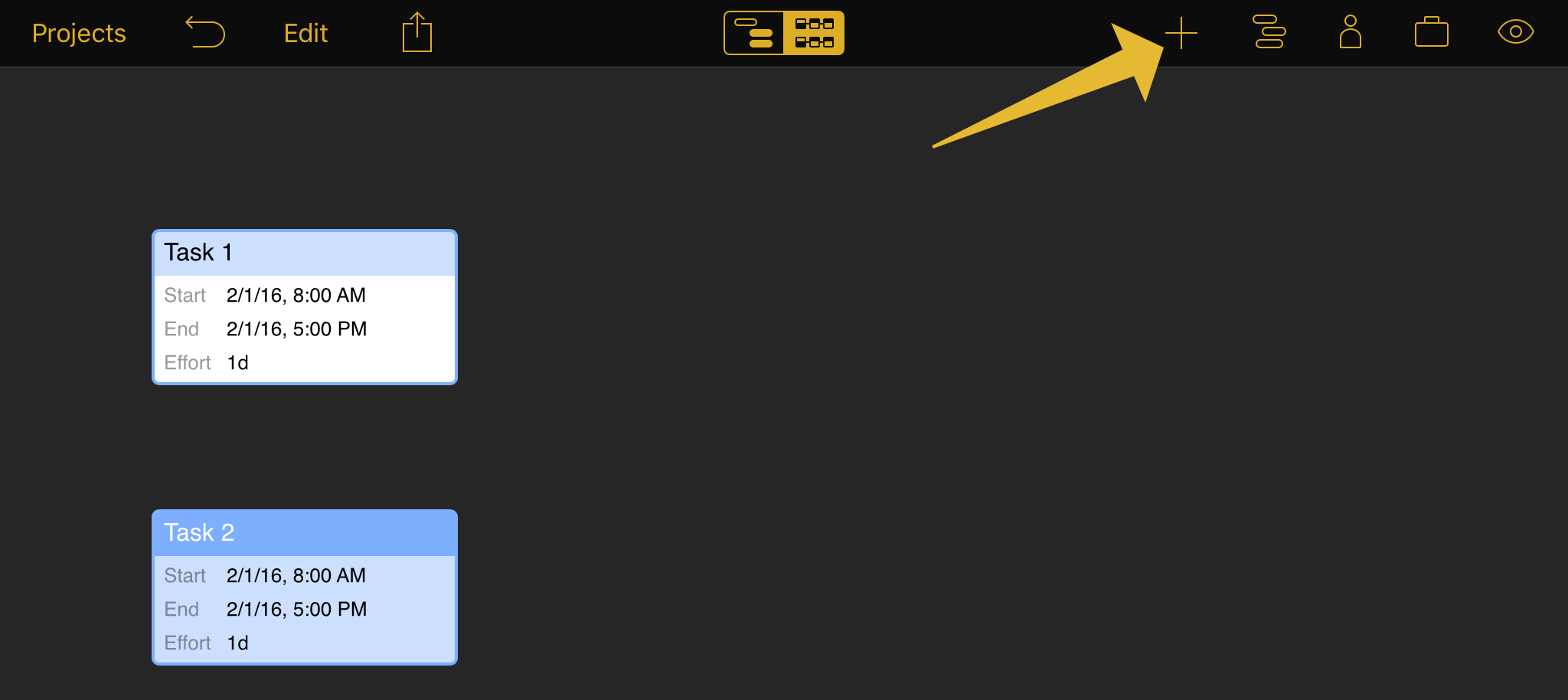
If you had a task selected previously, the new task will be connected to it by a line that represents a Finish ▸ Start dependency. As long as a task is selected, you can quickly create a chain of tasks connected with Finish ▸ Start dependencies by continuing to tap Add. If no tasks were selected, the newly created task is independent of any others.

An unbroken chain of tasks with Finish ▸ Start dependencies is arrayed in a straight horizontal line.
To create other dependency relationships, tap a task node to select it and drag the line that appears to another task. This creates a dependency between them, and you’ll see the tasks rearrange in the diagram automatically to reflect this new relationship.
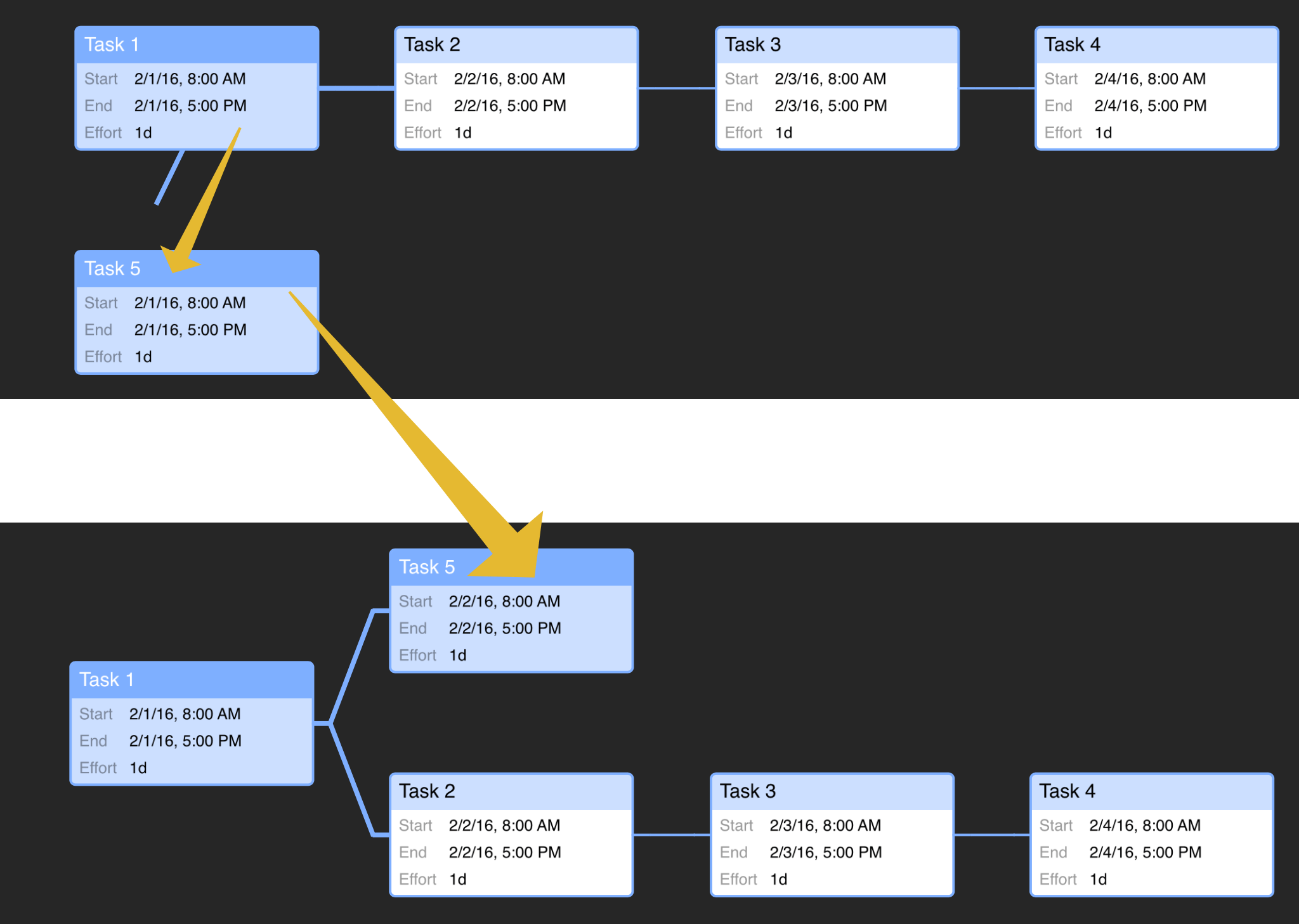
At any time while working in the Network Diagram, you can switch to the Gantt chart to see how your project-building exercise is looking, and see how its dependencies are described there.

When you’re working on a project of considerable size, you can zoom in and out on the Network Diagram using the vertical pinch gesture shared by the Gantt chart.
Using the Project Inspector
Accessed from the toolbar, inspectors are menus that contain sets of controls and input options for defining the parameters of all aspects of your project.
The Project Inspector contains tools for fine-tuning the details of your project’s structure and operating parameters.
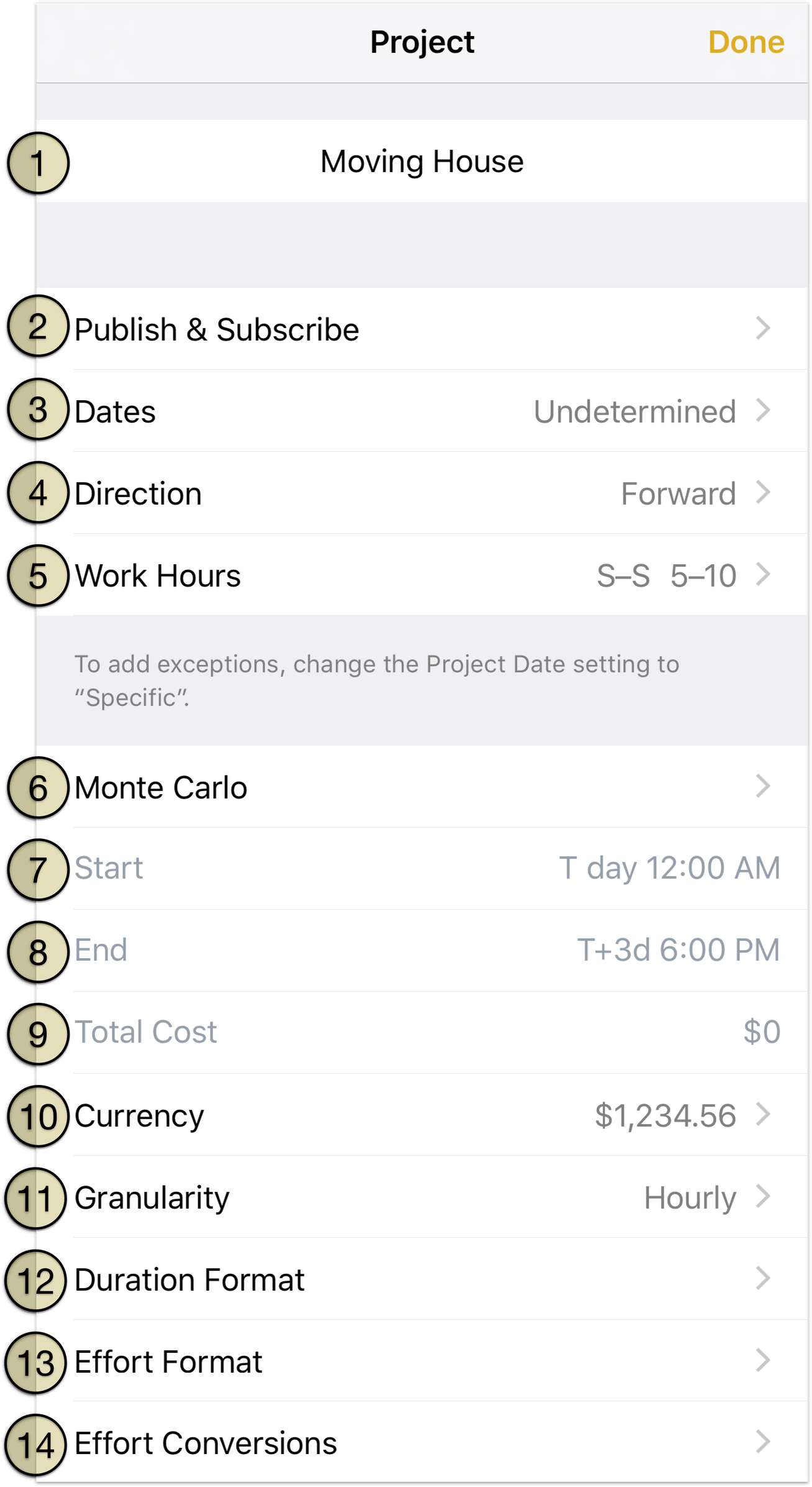
Project Title—edit the project’s name here.
Publish and Subscribe (Pro)—configure the publication and subscription settings for this particular project. The Multi-User Collaboration chapter describes this feature in detail.
Dates—choose from Undetermined or Specific dates for your project. Undetermined dates are represented by T+0d, T+1d, T+2d, and so on, while Specific dates are chronologically anchored to set days in the calendar.
Direction—choose whether work on your project proceeds Forward from a Fixed Start or Backward from a Fixed End. This determines the direction from which tasks will be scheduled; the former schedules tasks as soon as possible, while the latter schedules them as late as possible. Individual task directions can be set in the Task Inspector. Projects typically have a predefined start date or final deadline (and sometimes both), so choose whichever is appropriate for your project.
Work Hours—set the calendar of normal working hours for the project here.
Monte Carlo Simulations (Pro)—in OmniPlan Pro, use this control to assign effort estimates and run Monte Carlo simulations to estimate on-time milestone completion.
Start Date—set the start date for the project. This option is only available if you have set a Specific start date for your project, rather than an Undetermined date.
End Date—set the end date for the project. This option is only available if you have set a Specific end date for your project, rather than an Undetermined date.
Total Cost—check here to see the total cost for your project, based on Cost/Hour and Cost/Use values you’ve assigned to resources contributing to the project.
Currency—set the currency type for your project’s expenses and costs.
Granularity—choose from Exact, Hourly, or Daily to specify how precisely to schedule task start and end times (this applies when leveling, too).
Duration Format—choose how to display time amounts throughout the project. The duration at the top of the screen is a preview that changes based on which time units you choose to display.
Effort Format—choose how to display effort amounts throughout the project. The effort value at the top of the screen is a preview that changes based on which units you choose to display.
Effort Conversions—choose how many work hours to count as one day, week, month, or year. This affects how large amounts of effort are entered an displayed.
Using the Task Inspector
The Task Inspector contains tools for setting details of tasks (with the Task Info pane), scheduling influences and constraints on the task (with the Scheduling pane), and resources allocated to the task (with the Assignments pane).
The Task Info Pane
The Task Info pane of the Task Inspector provides settings for describing the parameters of the task, including its name, note, type, amount of effort or duration required to complete, and its visual appearance in the Gantt chart and Network Diagram.

Task Switcher—use the up and down arrows to move between tasks in the Project Editor while keeping the Task Inspector open.
Inspector Panes—switch between the three panes of the Task Inspector (Task Info, Scheduling, and Assignments).
Task Name and Note—edit the task’s name, and add a text note containing any additional relevant information.
Task Type—choose a type for the task: Task, Milestone, Group, or Hammock.
Task Metadata—attributes of the task that determine its scope, progress, cost, and visual presentation.
Effort—the amount of work hours required to complete the task. This value may be automatically adjusted based on the method for assigning resources chosen in Resource Assignment Options in the Assignments pane of the Task Inspector.
Duration—the length in actual time required to complete the task, based on the amount of effort assigned to it. This value may be automatically adjusted based on the method for assigning resources chosen in Resource Assignment Options in the Assignments pane of the Task Inspector.
Completion—the amount of work on the task that is currently complete, expressed as a percentage.
Task Cost—the cost of the task, in addition to the cost/hour or cost/use of any resources assigned to it. Expressed in the units of currency set up in the Project Inspector.
Bar Color—the color of the task’s bar in the Gantt chart.
Resources Cost—this value isn’t edited directly, but represents the total cost of the resources currently assigned to the project based on the resources’ cost per hour or cost per use.
Total Cost—as with Resources Cost, this value isn’t edited directly. It combines the Task Cost and Resources Cost values for an at-a-glance summary of the projected cost of the task in its entirety.
The Scheduling Pane
The Scheduling pane of the Task Inspector describes how the task is contextually integrated into the project. It lists other factors influencing when the task is allowed to begin, provides controls for locking the task at a point in the project’s calendar, and shows any other tasks that are dependent on the tasks completion to begin.
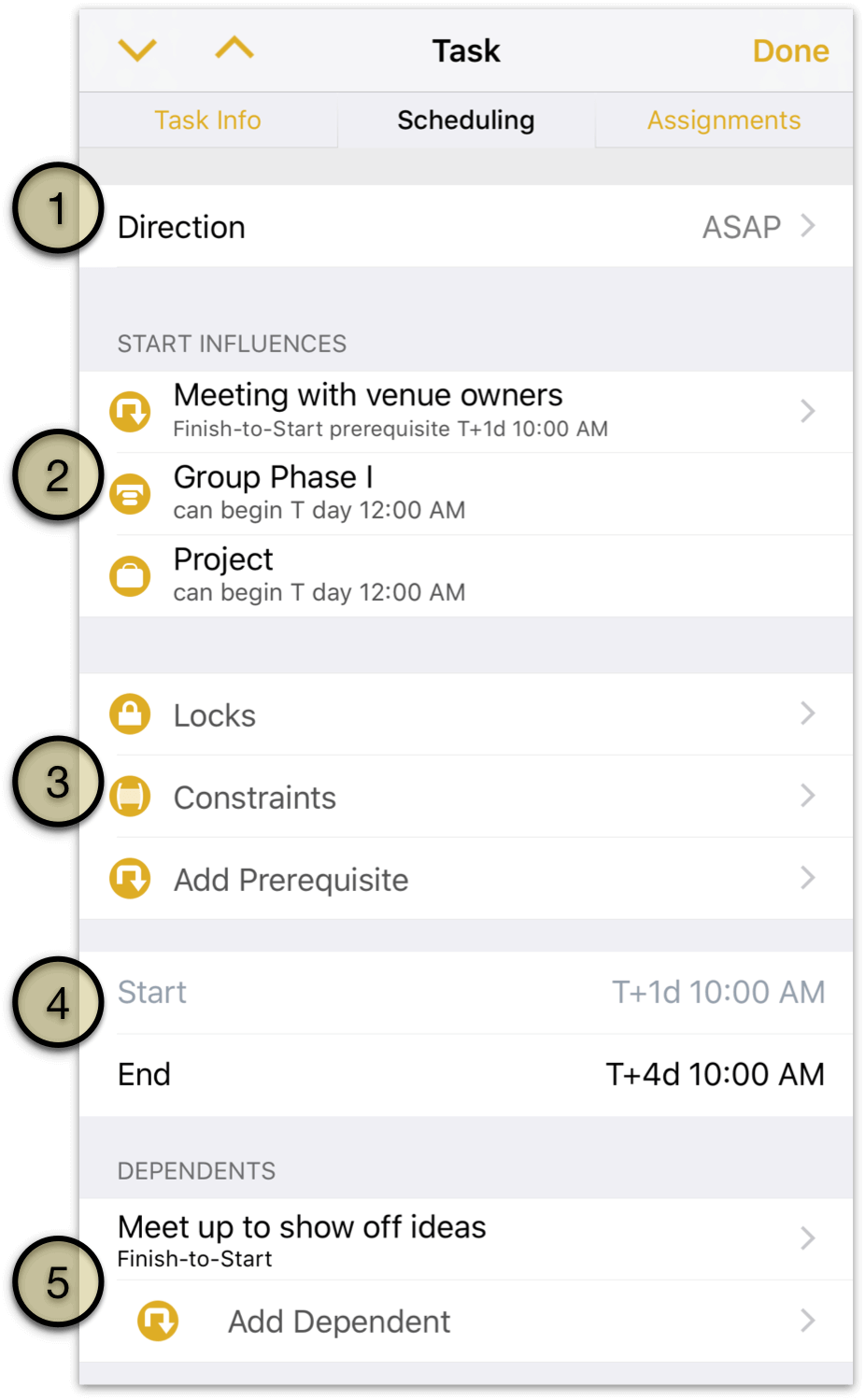
Task Scheduling Direction—choose whether the task should be scheduled as soon as possible (ASAP) or as late as possible (ALAP). This affects how the task is scheduled when leveling resources, and overrides the Direction setting in the Project Inspector for this individual task.
Task Influences—this section lists other aspects of the project that affect when the task can be scheduled, such as the project’s overall start date or the date a task group containing the task can begin.
Task Constraint Editors—these editors control various task parameters that limit when the task can be scheduled.
Locks—lock the task’s start and/or end dates here. Locking either or both of these dates prevents other factors, such as leveling after assigning additional resources to the task, from changing the dates its work is scheduled for.
Constraints—add bounding constraints to anchor the task loosely in time between “bracket periods” during which the task is allowed to start or end.
Add Prerequisite—choose a task from the list to create a finish ▸ start dependency between that task and the one currently being edited, adding a new prerequisite task that must be completed before this one can begin.
Task Start and End—edit the task’s start and end dates. One or the other may be inaccessible; this can be due to a scheduling rule or other constraint (such as the absolute start date of the project). Note that unless they’re locked in, setting these dates doesn’t prevent them from being changed by leveling later.
Task Dependents/Prerequisites—a list of tasks dependent on the current task’s completion to begin. Tap a task to view its details and add lead time if desired. Tap Add Dependent to select another existing task to add as a dependent using a finish ▸ start dependency from the current task.
If the selected task has any prerequisites to its own beginning, those will be listed here as well.
The Assignments Pane
The Assignments pane of the Task Inspector controls how the task should be prioritized when leveling, and provides tools for assigning and configuring resources assigned to the task.
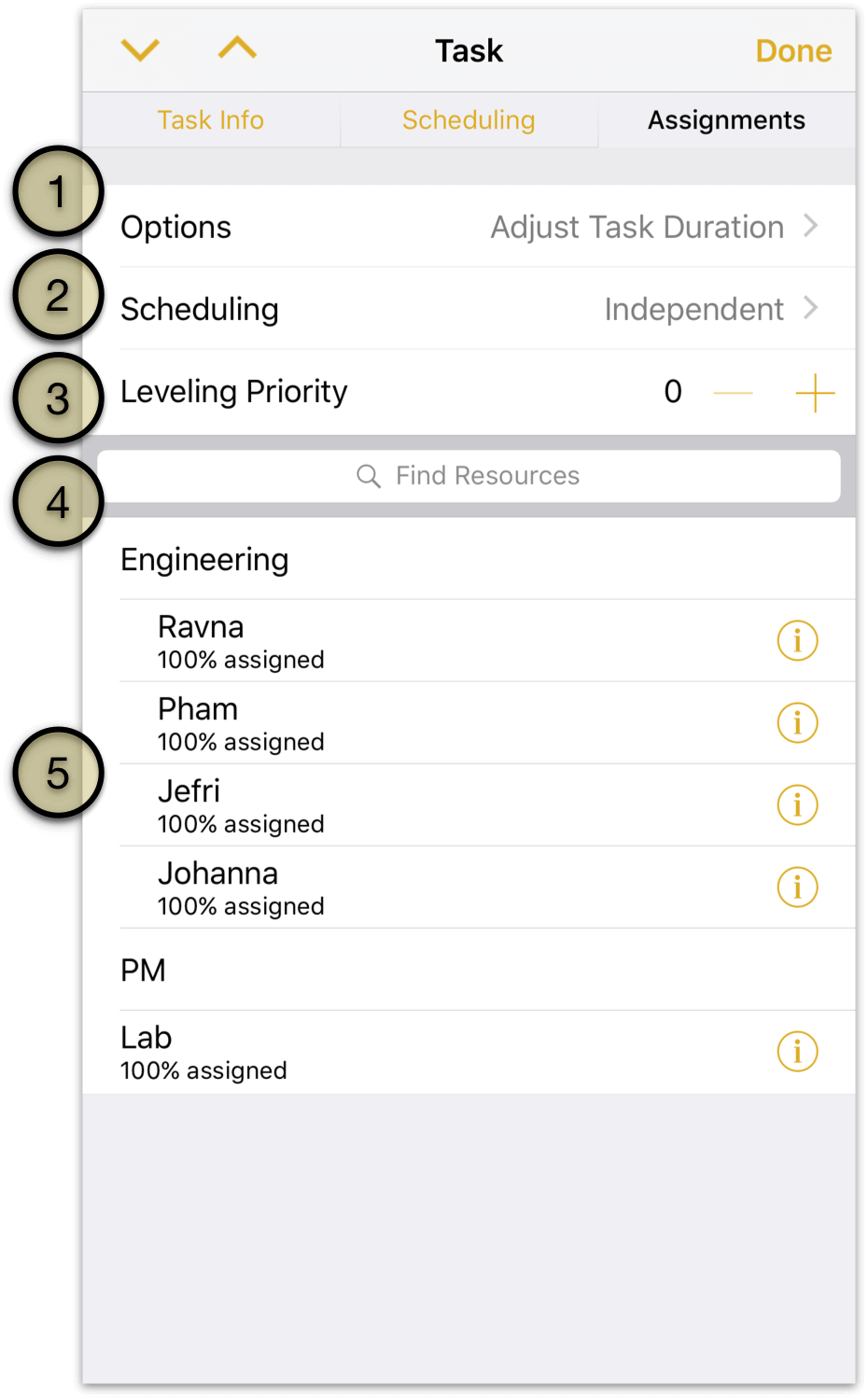
Resource Assignment Options—when resources are assigned to (or removed from) the task, set how the task’s effort, duration, and assignment percentages should change based on the revised resource allocation.
Resource Scheduling Method—by default, resources assigned to a task can put in their hours whenever is most convenient based on other scheduled work. The Meeting task type adds the option, when leveling, to require all resources be present to work on the task simultaneously.
Task Leveling Priority—when leveling, tasks with no constraints or dependencies will be queued based on their order in the Gantt chart unless they are given a priority here. Lower positive integers indicate higher priority (1 is the highest); tasks do not require consecutive priority numbers for their order to be respected.
Resource Selector—use this field to filter the resource list alphabetically. If a desired resource doesn’t already exist, add it using the Plus button that appears at the bottom of the filtered list.
Assigned Resources—view a list of all the project’s resources here, along with information about their assignments relative to the selected task. Any resource assigned to the task will list the percentage of its effort assigned below its name, and will have an Info button with details about the assignment and the option to change the percentage of effort being contributed.
Using the Resources Inspector
The Resources Inspector contains tools for resource creation, calendar customization, and resource leveling.
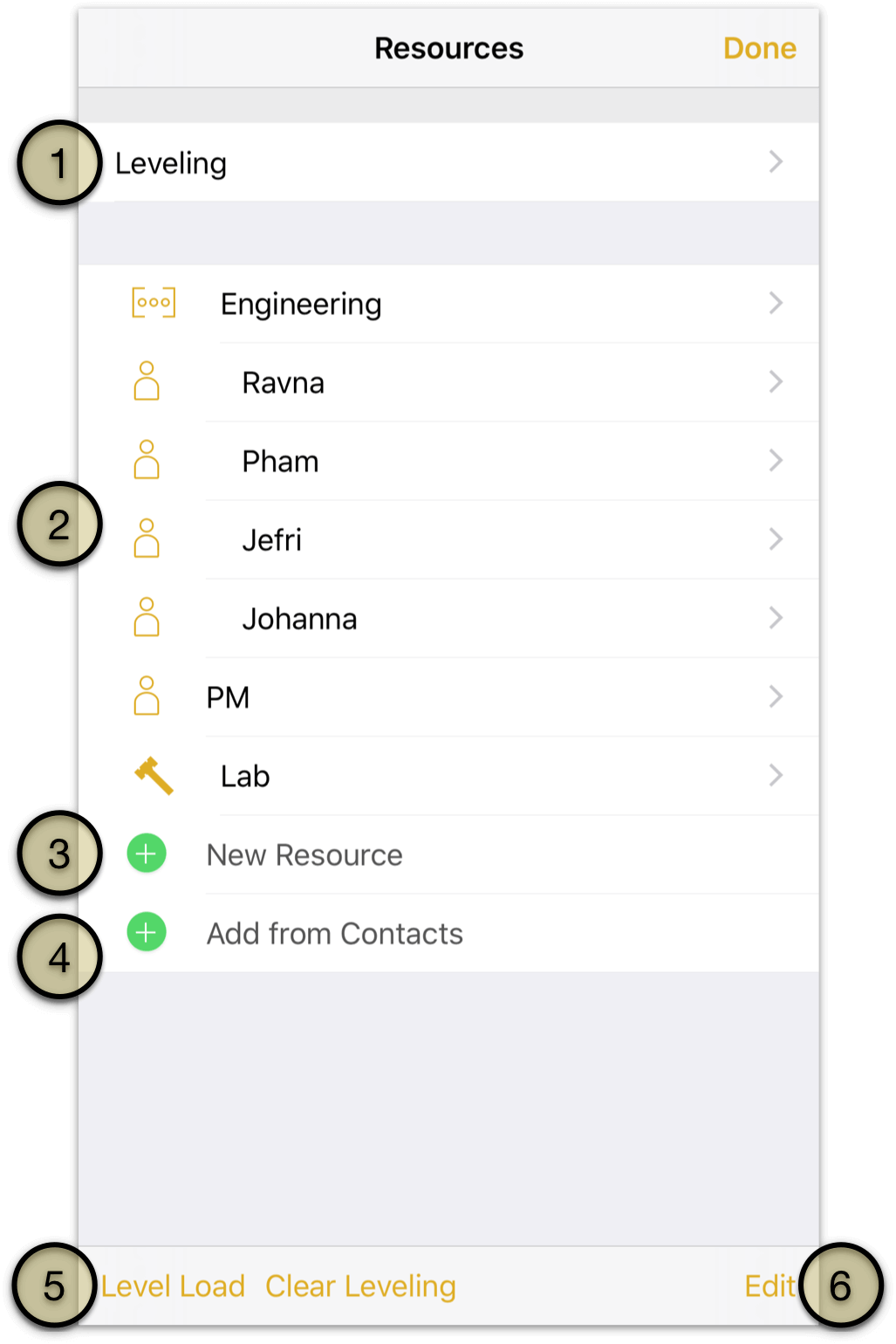
Resource Load Leveling Controls—choose whether to automatically level resource loads across the project whenever a change is made, whether leveling affects only the schedules of tasks in the future (from the current date), and whether to allow tasks to be split as part of the leveling process.
Resource List—a list of all resources currently assigned to the project. Tap a resource to view its details, including type, email address, regular work hours and off hours calendar, units and efficiency, cost/use and cost/hour, and bar color (only relevant when sharing resources with a project in OmniPlan Pro for Mac).
Add New Resource—add a new resource to the project and customize its details.
Resource types include:
Staff—people who work on the project. Staff units are measured as percentages. A person who is fully available to the project has a units value of 100%; someone who is spending part of their working hours on other projects would have lower available units. Note that this is not the same as having fewer working hours or being less efficient; these values can be edited by tapping the individual resource.
If you are collaborating with multiple users across projects, a staff member's email address serves as their unique identifier for purposes of leveling resources loads.
Equipment—some kind of reusable asset, such as special computer hardware. It can be useful to consider things like meeting rooms to be “equipment”, if you need to balance their use between different tasks. For equipment resources, “Units” means how many of the resource are available. The number of available units can affect resource leveling.
Material—consumable supplies. For material resources, “Units” means how many of the resource are being used throughout the project. This value updates as the resource is assigned to more tasks.
Group—a way to organize several resources together. As such, groups lack some characteristics of individual resources. Others, such as Efficiency and Cost, represent the average of the individual resources that form the group. If these values are changed for the group they are changed for each resource within the group as well, overwriting any existing values.
When a resource group is created, it is initially empty; to add resources to the group, create them and move them inside the group with Edit Mode.
Add from Contacts—grant OmniPlan access to your Contacts list to add resources to your project directly from there.
Level Resource Loads/Clear Leveling—reschedule tasks and change resource loads to most efficiently complete your project based on all the other parameters you’ve set up for individual tasks, resources, and the project as a whole. Or, remove leveling optimization with Clear Leveling.
Edit Resources—Switch to Edit Mode, where resources can be removed with the deletion switch next to their names, and reorganized—including movement between resource groups—with their reordering handles.
Using the View Inspector
The View Inspector contains tools for customizing how data is displayed in the Project Editor, with a particular emphasis on tracking project progress.
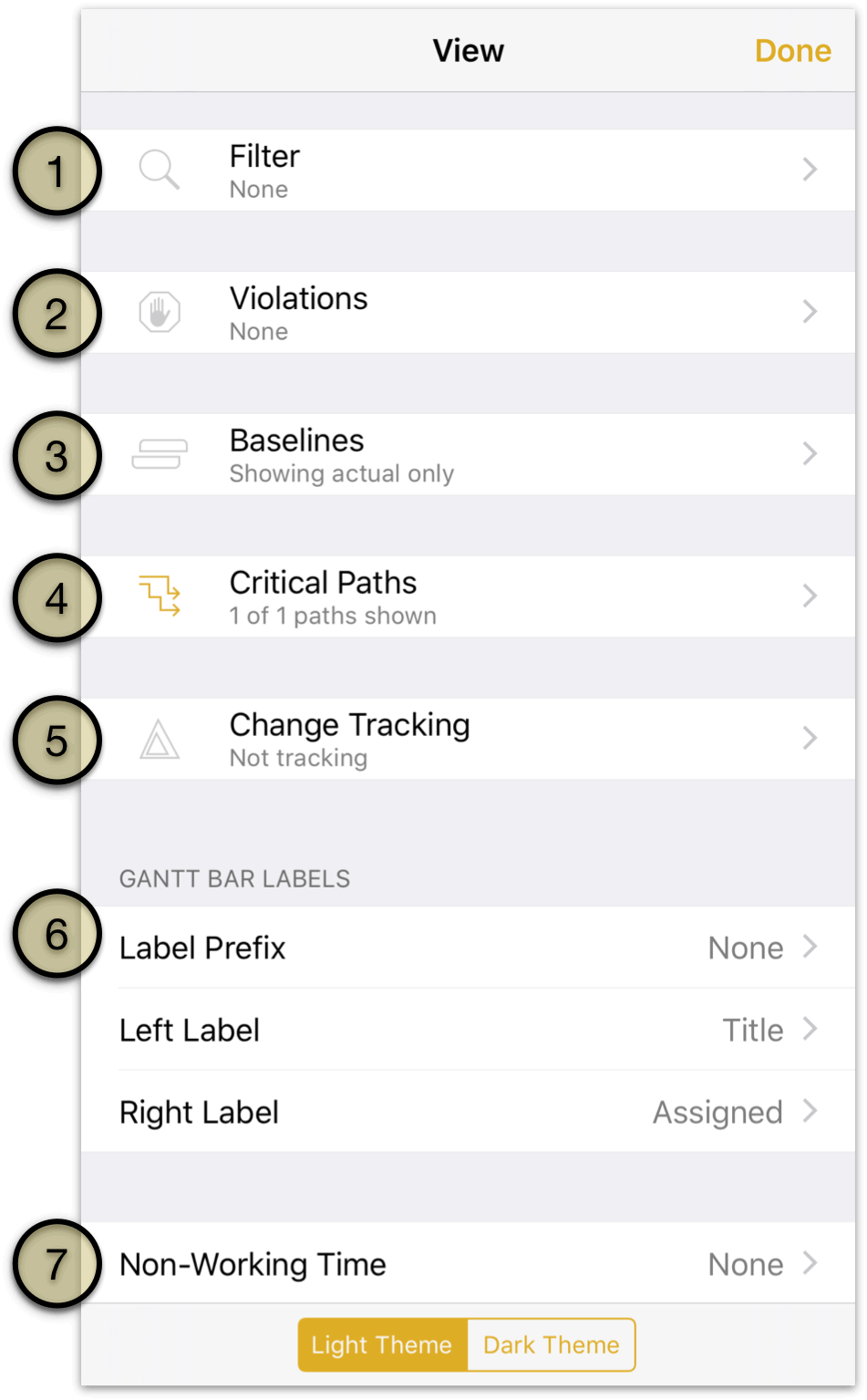
Project Task Filter—apply a filter to the Project Editor that limits which tasks are visible. Choosing a filtering parameter here doesn’t affect the hidden items beyond removing them from view.
Violations—when a logical contradiction arises in your project, such as a result of an impossible dependency relationship or a scheduling change that violates date restrictions you’ve set up, you’ll see details on the problem here along with a suggested solution to resolve it.
Show Baselines—a baseline is a snapshot of project’s state of affairs against which the actual schedule can be compared. Set a baseline with Set Baseline in the bottom toolbar, and choose which you’d like to compare against the actual schedule from the list. Tap Edit to remove baselines with the deletion switches next to their names.
Show Critical Paths—choose which critical paths you would like to display in the Gantt chart, including critical paths to each milestone and the overall project. Tap a milestone to edit details of its critical path display: choose whether or not resource constraints are considered in charting the path, pick a color for the path line, and set an amount of slack OmniPlan considers built in to tasks for purposes of considering them part of the critical path to that milestone.
Change Tracking—if you’re publishing your project to a shared server repository with multiple contributors, enable change tracking to view and approve changes made to the project by yourself and others. Select changes in the list and tap Accept Change or Reject Change at the bottom to approve or deny them.
Gantt Bar Labels—pick metadata to attach to the left and right side of task bars in the Gantt chart, and to add as a prefix.
Non-Working Time—add shading to date columns in the Gantt chart that correspond to time where no work is scheduled (based on Calendar settings in the Project inspector). Visualization options include None, Holidays, Holidays & Weekends, and All Hours.
With an overview of the tools in the Project Editor complete, the next step in mastering OmniPlan is to begin building your first original project.
Building Your First Project
Broadly considered, OmniPlan’s project management tools serve two distinct but connected purposes. The first is similar to tools used in drafting the design of a model airplane kit: describing, as accurately as possible, the intended shape of an ideal plan, executed in miniature at an acceptable level of abstraction and mathematical precision.
The second use of OmniPlan’s tools comes after the first, once the plan has been made and the project is in motion: adding a motor to that model airplane, refueling it and repairing any leaks, and recovering from bumps along the way. The “management” side of project management is covered in the Managing a Project chapter.
This chapter’s tutorial begins at the beginning, tracing the first step toward successful execution of a plan: building the model of the project itself.
Step 1: Creating a Project
For the purpose of this tutorial we’ll be looking at the development process of a game being put together by an independent team of intrepid designers, coders, and testers. The project design described as we proceed is loosely based on a software development cycle, but applies just as well to any complex work consisting of interdependent and occasionally concurrent phases.
Starting off in Local Documents, tap the New Project button.

This opens the Project Editor’s Gantt chart view, where a first task is waiting to be customized or edited. Before we get to that, let’s rename the project to something more interesting.
Open the Project inspector in the toolbar to edit the project title.
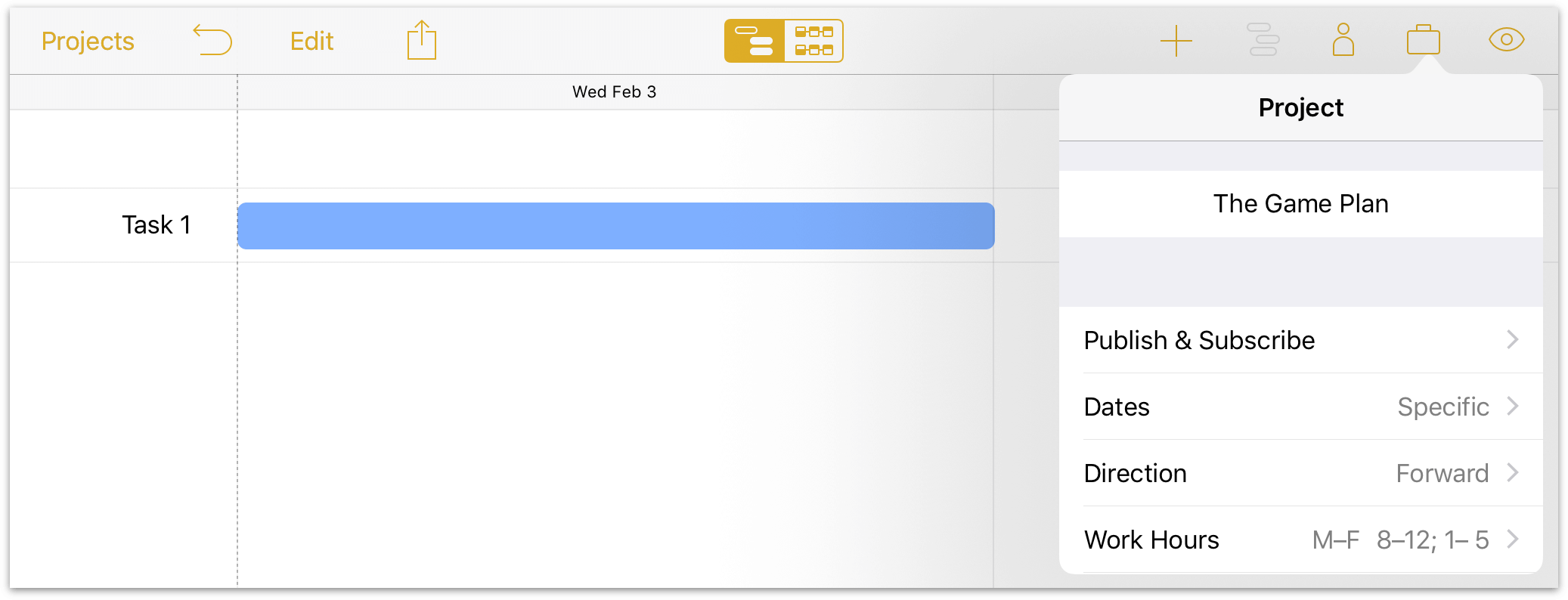
Step 2: Choosing a Start or End Date
When setting out to build a project, one of the most important aspects is the timeframe. This, in turn, is dictated by any deadlines or start constraints that exist for the project.
In the case of our game development scheme, we don’t have a hard deadline for the project to be finished - we want it to be done when it’s ready (but as soon as reasonably possible). To indicate this, we’ll go to the Project inspector and set the start date as today.
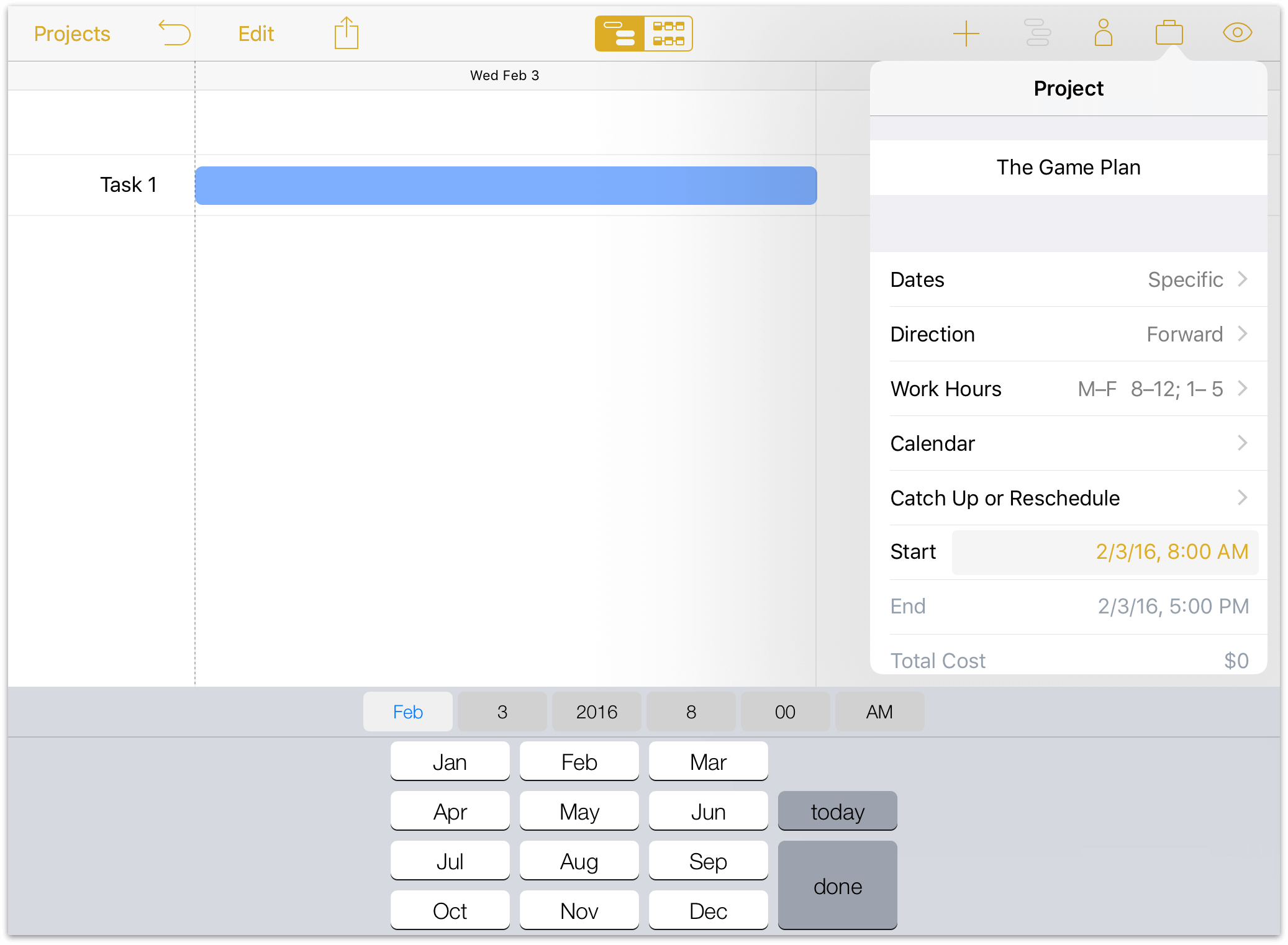
Conveniently, this is the default setting for any new project.
You’ll notice when setting the Start date that the End date field is greyed out. This is because for a project scheduled for task completion as soon as possible (also referred to as ASAP), an end date cannot be specified—by definition, the project ends as soon as all of its constituent tasks are complete.

If you’re planning a project with a specific do-or-die deadline, you’ll want to switch the project’s Direction from forward to backward and put the deadline date in the End field. Tasks will be scheduled back from this date (“as late as possible”, or ALAP), filling in the time from project completion to the present.
Note
If you’re planning a project in the abstract without a fixed start or end date, you can change the dates format Specific to Undetermined until the timeframe is more set in stone. You’ll get dates that display as T+1d, T +2d... instead.
Step 3: Creating Tasks
Now let’s turn our attention to the Gantt chart, where a first default task awaits us.
Tasks in OmniPlan represent discrete pieces of work that require substantial effort to complete, usually across a duration expressed in hours or days rather than minutes. Prepare morning coffee, for example, is a task that’s typically not within the scope of OmniPlan, while Install espresso machine very well could be — maybe even a group of tasks, if you need external help getting pipes or electricity connected.
Note
The notion of “task” in OmniPlan is in contrast with action item-based productivity apps such as OmniPlan’s counterpart OmniFocus, where anything you can conceive of as something you’d like to accomplish can—and should—be included in thinking about your project plans.
OmniFocus is built around personal task execution; the granularity of OmniPlan’s tasks is intended for work that must be considered by (or requires input from) a group of stakeholders, often as a team.
The process of project building starts with a brainstorm session for all the tasks you think the project will include. As noted, these are typically things that you think will take the effort of multiple people to complete, or have some impact on other work that the project requires. Don’t worry too much about whether a task fits the project’s scope at this point—it’s more important to get the ideas flowing. You can always come back and edit these later.
We’ll change the name of the default “Task 1” by double-tapping it or editing the name field in the Task inspector, and then tap the Add button to create new ones.
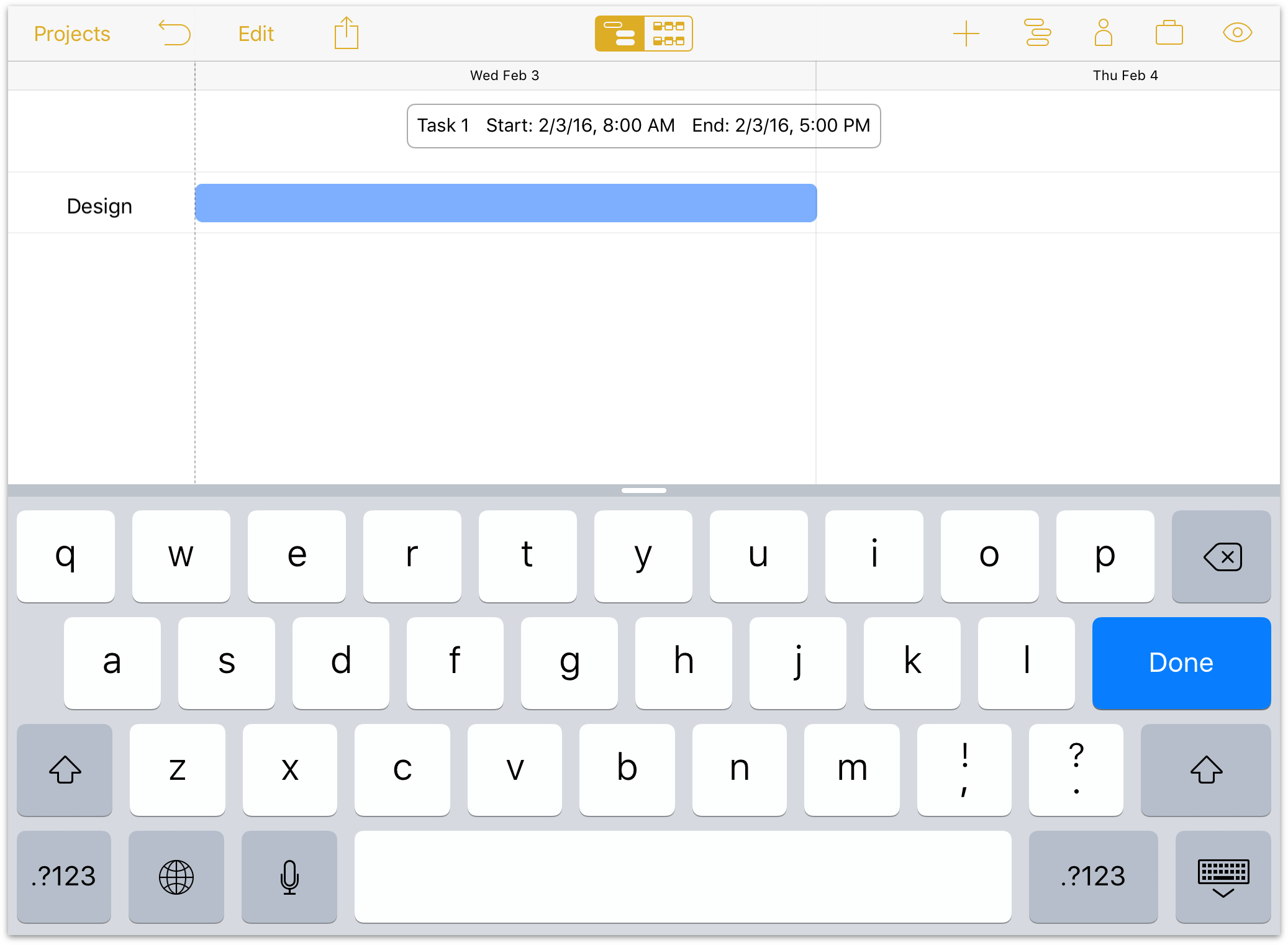
New tasks appear below the currently selected item in the Gantt chart, or at the bottom of the list if no tasks, milestones, or groups are selected.
Tip
As you create a list of tasks, try Network Diagram view! Tap the view switcher in the toolbar to see your tasks as a set of nodes—they’re currently not connected to one another, but that will change.
For our project we’ve created several tasks that we think we’ll need to accomplish on the road to a final product. Since we now have more items than will fit on the screen at once, pinch vertically on the Gantt chart to change the view scale.
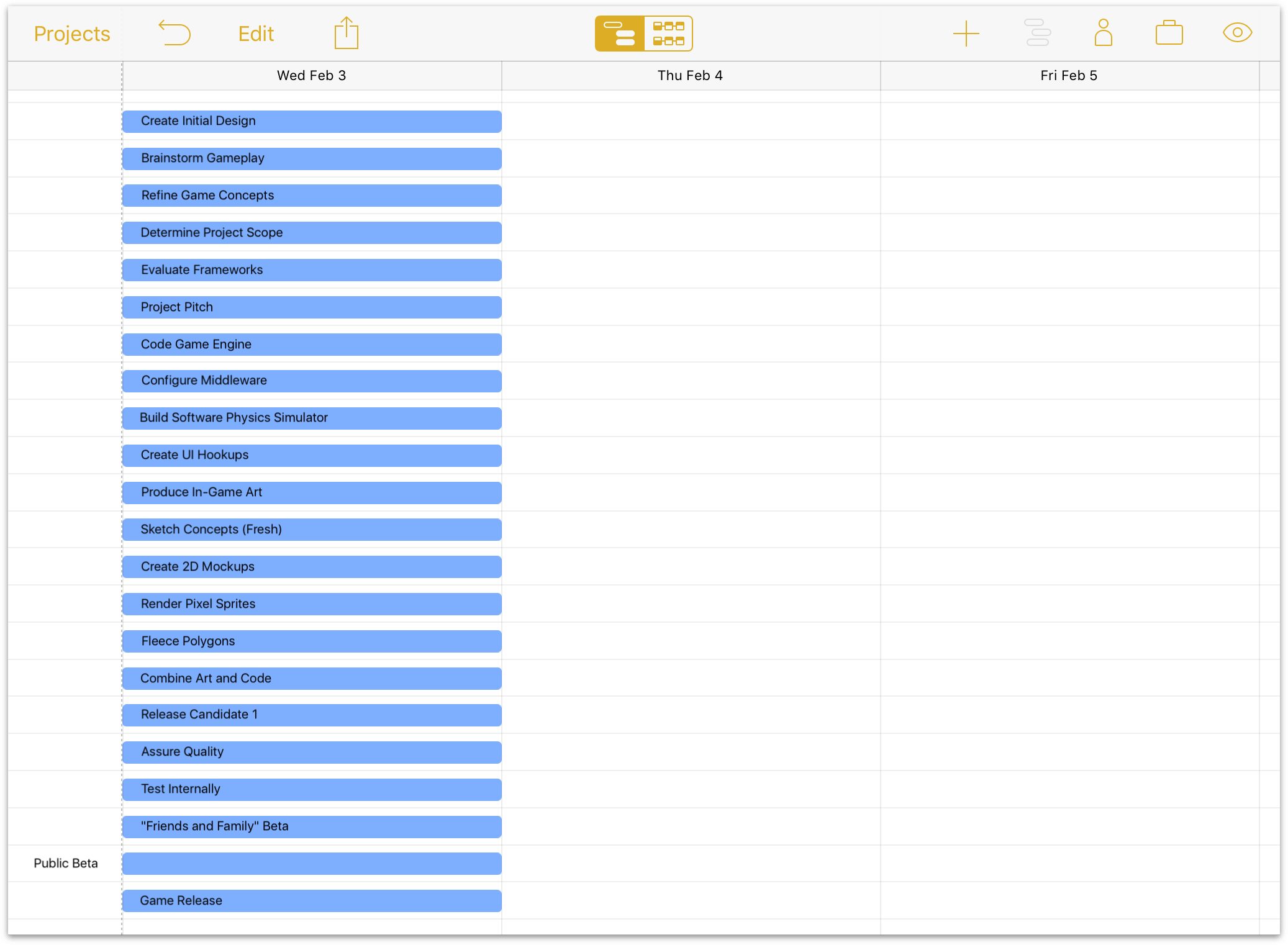
Step 4: Grouping Tasks
When tasks are closely related or interdependent it can be useful to put them in a group. Groups help organize a project conceptually, and also act as meta-tasks that can be linked via dependencies to other tasks or groups.
Note
A task group is just a container—it has no duration or effort of its own. The amount of time and energy needed to complete the group is equal to the sum of the requirements of the group’s individual tasks.
An easy way to gather tasks into a group is in Edit Mode. Tap Edit on the project screen, then tap to select all of the tasks and milestones to be grouped. Finally, tap Group in the bottom toolbar to complete the edit.
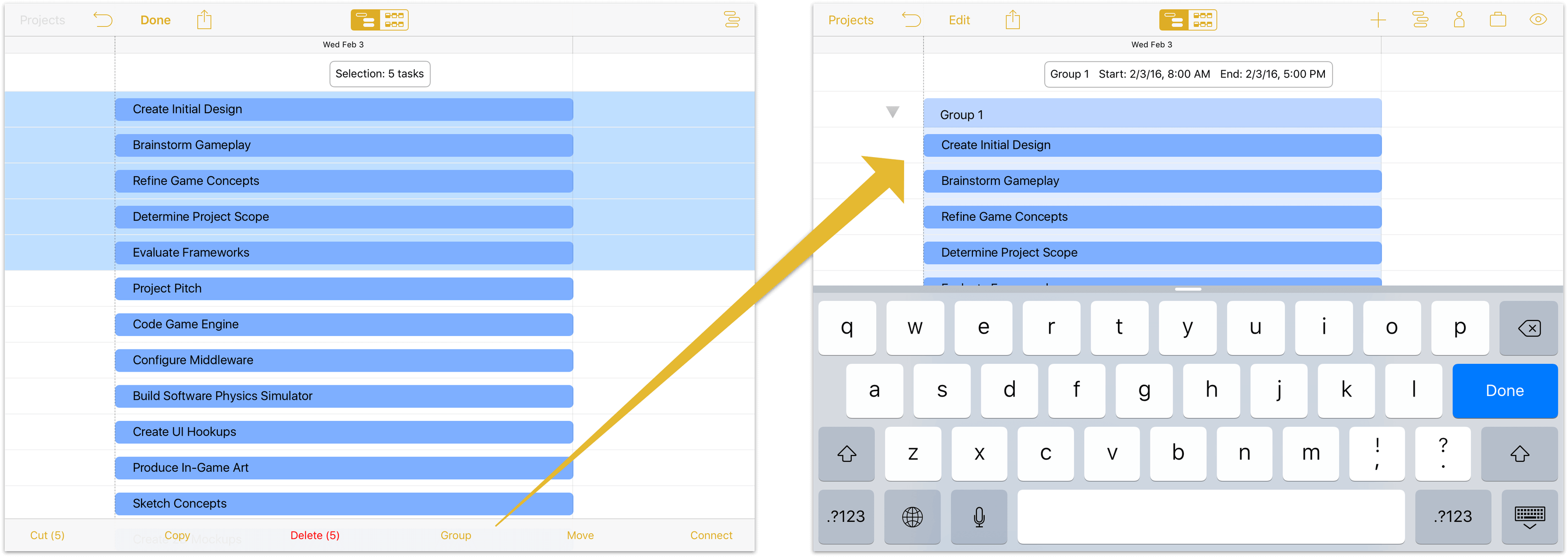
An existing task in your list may make a good candidate for a group already. Tap to select it and then open the Task inspector, where you can change its task type to Group. Assign other tasks to the new group in Edit mode by selecting the tasks (but not the group itself) and choosing Move, then tap the group and choose Inside from the contextual menu.
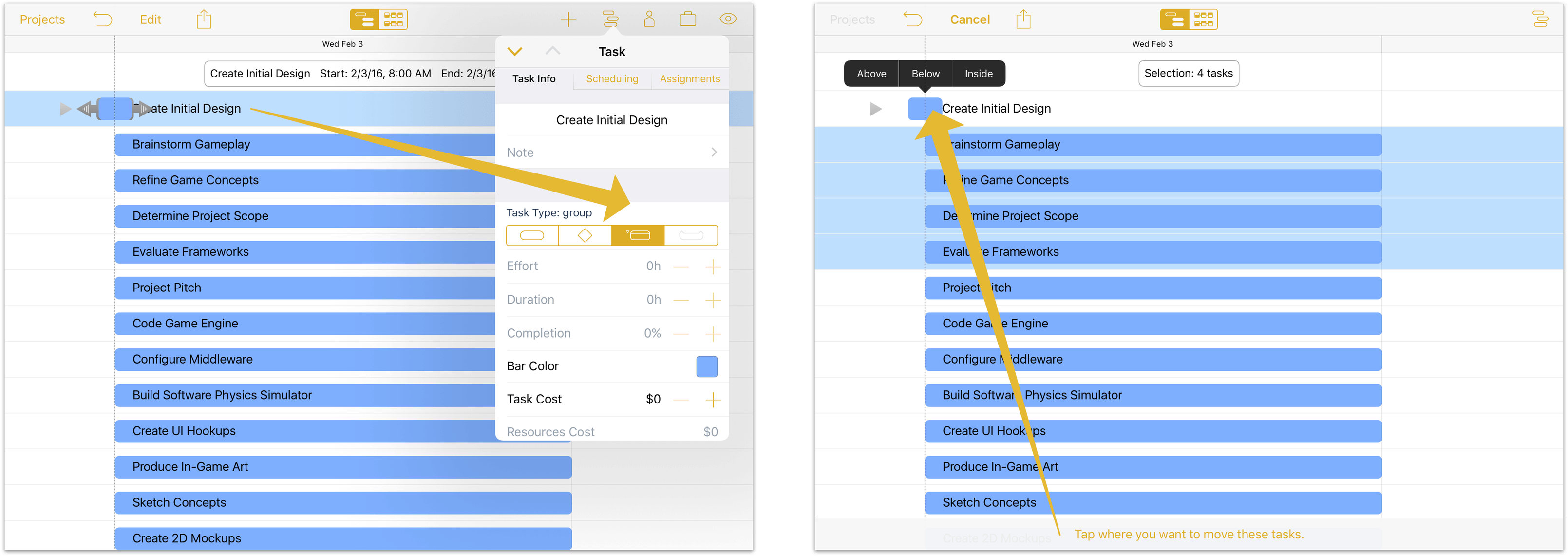
While you’re in Edit mode with the group and all of its tasks selected, this would be a good time to add a bit of visual distinction to the group as well. Open the Task inspector and tap Bar Color to choose a color that will identify all of the tasks in the group.

Step 5: Creating Milestones
Milestones are the anchor points in your project that mark important shifts in focus or unlocking a new phase of the project. Clarifying these will help break a dauntingly large project down into more manageable sections, and help dictate the tasks leading up to and following the milestone.
To create a milestone, tap and hold the new task button until the option appears:

Alternatively, tap a currently existing task to select it, then open the Task inspector. You can change the task type from a regular task to a milestone here.
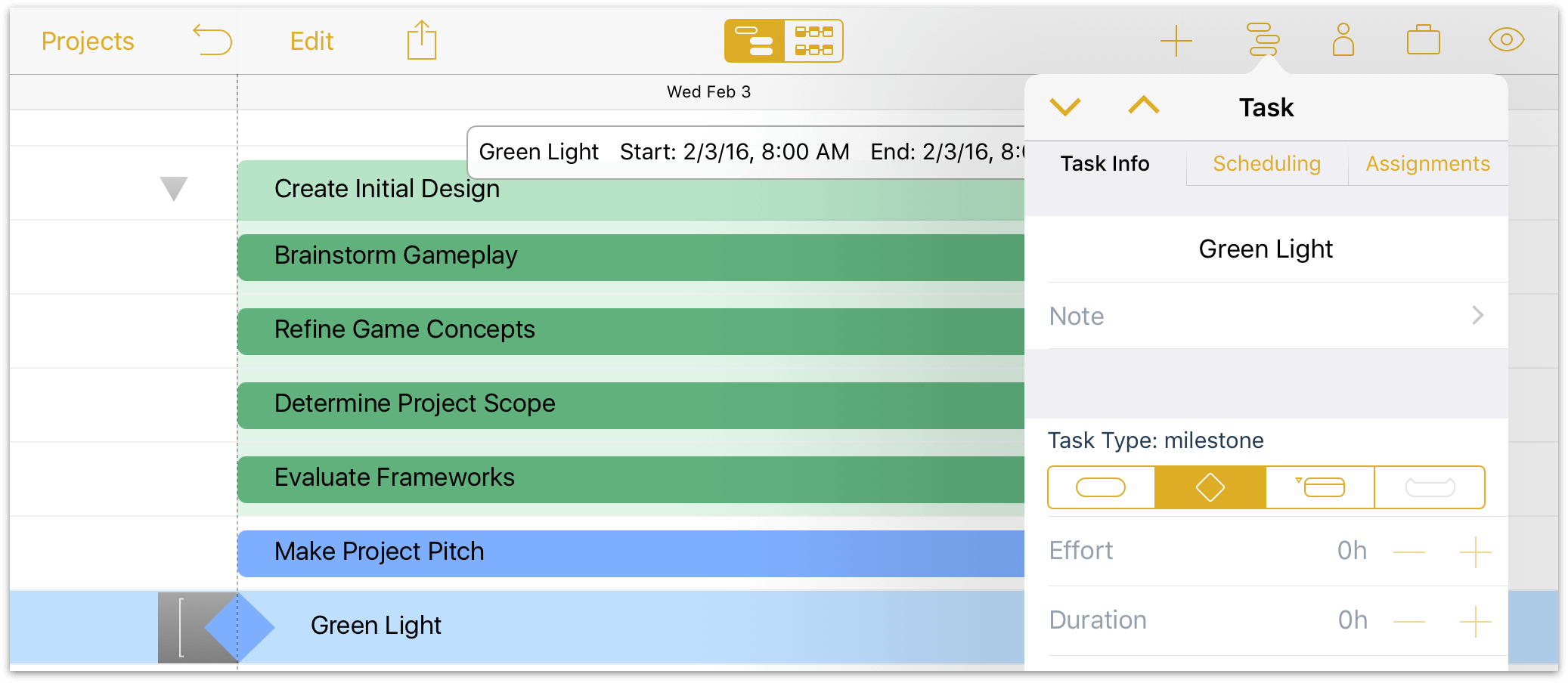
Note
When you convert a task to a milestone, you’ll see that its Effort and Duration fields in the Task inspector are greyed out. This is because milestones aren’t actionable items; they serve as important indicators of progress, but have no “mass” in and of themselves. If you find yourself wanting to apply effort to a milestone, odds are it’s actually a regular task—some piece of work that precedes an actual milestone.
Step 6: Setting Task Durations
Returning to our tasks in the Gantt chart we can begin to scope out how long each task will take. With estimated times for their completion in mind, tap a task and drag the right handle that appears to the appropriate length for the task’s duration (in this case, two full workdays).

Task duration can also be set using the Task inspector.
Note
The task duration you set in this step isn’t set in stone. By default it represents the number of work hours required to complete the task—not the absolute time that the task will take to complete. This becomes clear when you begin assigning resources to tasks; when more than one staff member puts their full effort into a piece of work, the amount of time it takes to complete is reduced.
If you take a detour to the Assignments pane of the Task inspector you’ll find options for how OmniPlan handles a selected task when resources are assigned to it.
- Adjust Task Duration—Adding new resources increases the effort available to complete them, and this option uses that effort to shorten the amount of time the task will take to complete. The opposite is also true, as removing a resource from the task will increase its duration.
- Adjust Task Effort—Adding new resources keeps the duration the same, and adds the effort they contribute to the total required to complete the task — this represents pouring work into a fixed timeframe. Removing resources indicates that less effort is needed to complete the task in the same amount of time as originally planned.
- Adjust Assigned Amounts—With this option the duration and effort stay the same regardless of resource assignments. Instead, when new resources are added, the amount of effort asked of each resource is reduced evenly across the board (one resource contributes 100 percent, two resources contribute 50 percent each, and so on).
After organizing tasks into groups and estimating the time required to complete them, we’re starting to get a better picture of how our project will take shape. At this stage our Gantt chart looks something like this:
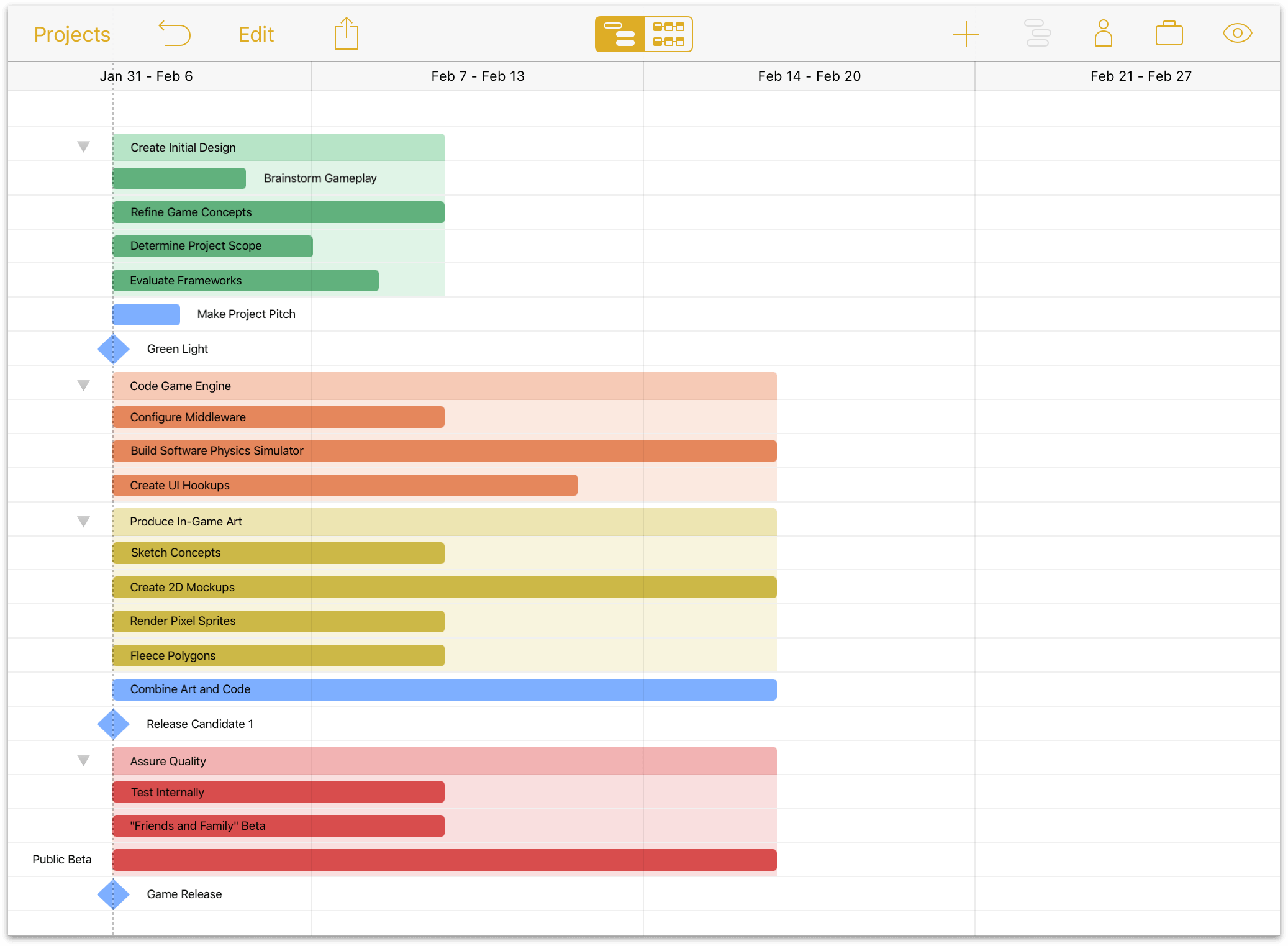
Step 7: Connecting Tasks with Dependency Lines
We can’t complete all of our tasks simultaneously! Even if we had the resources to do so, some parts of the project can’t happen until others are finished. Thankfully, the pieces are now in place to establish the ways that those tasks are dependent on the status of others. There are four ways that dependencies can exist:
Finish ▸ Start dependencies are the most common type, indicating that when task A finishes, task B can start.
Start ▸ Finish dependencies indicate that when task A starts, task B can finish.
Start ▸ Start dependencies indicate that when task A starts, task B can also start.
Finish ▸ Finish dependencies indicate that when task A finishes, task B can also finish.
Connecting tasks in the Gantt view is as easy as tapping a selected task again, which puts dependency arrow handles on either side of the task bar.

Drag an arrow from the selected task to another task to create a dependency. The type of dependency is based on the start- and end- points of the arrow: dragging an arrow from the completion of one task to the beginning of another will create a Finish ▸ Start dependency, and so on.

While in Edit mode, you can use the Connect/Disconnect button to add Finish ▸ Start dependencies or remove dependencies between any number of selected tasks simultaneously.
Tip
Having created your first dependency, now is a great time to check in with the Network Diagram view again. This is where the view really begins to shine, with clear illustrations of how tasks are connected. Experiment with connecting tasks in this view for awhile—you may find it preferable to the Gantt chart’s organizational aesthetic.
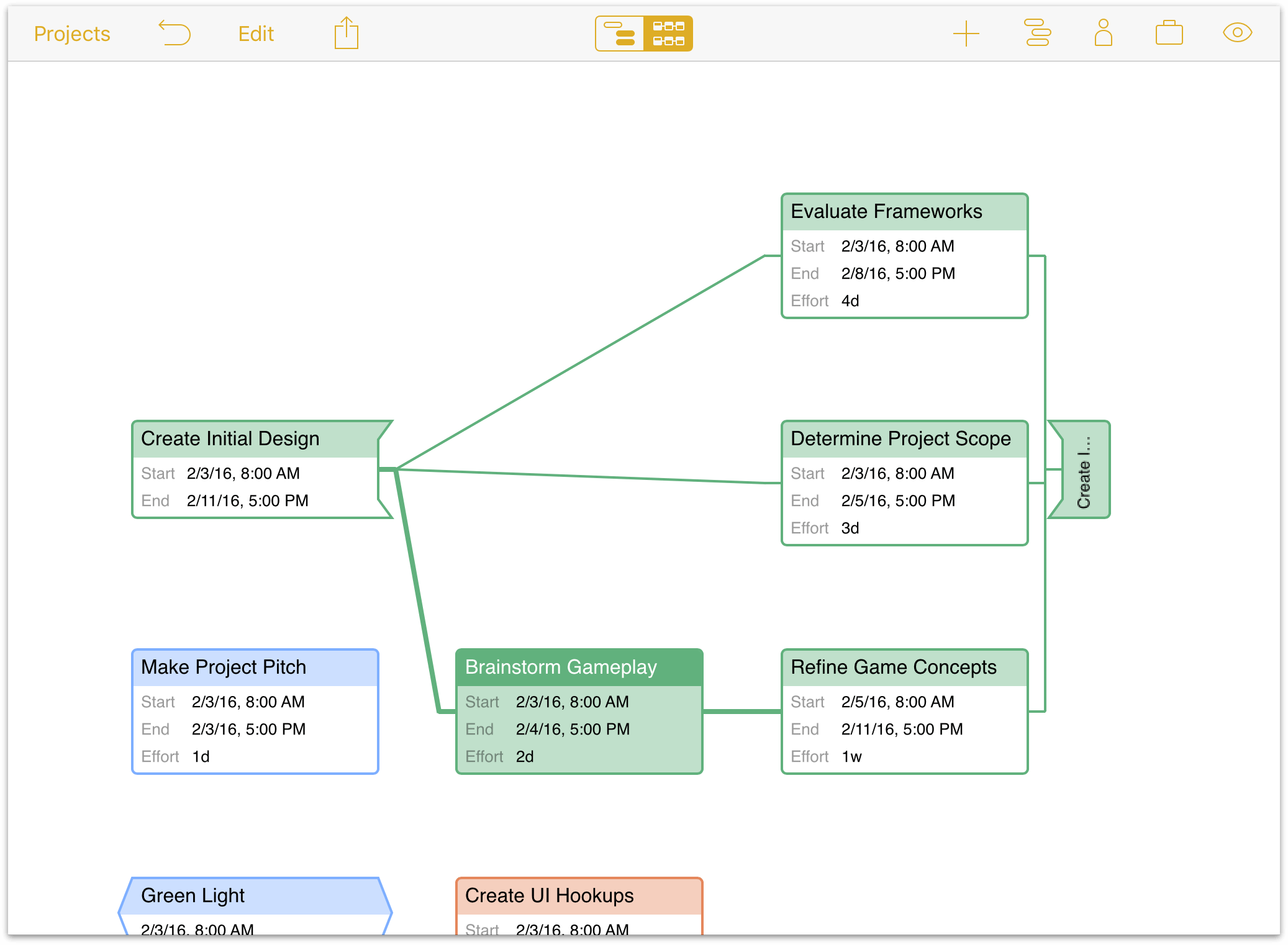
Step 8: Creating Hammock Tasks
A hammock task is one in which the duration is dependent on both when the previous task ends, and the next task starts. This type of task is useful when facing a hard deadline and deciding what can be compressed if the project is running behind schedule, or if external factors influence when parts of the project must happen.
In the case of our example project, now that we’ve established most of its dependencies we have a clearer idea of how long it’s likely to take. With that knowledge, we can anchor the final milestone to a point in time: we set Game Release for May 1st.
We decide that the public beta test period is the task that can give the most if we end up short on time toward the end, so that’s the one we want to convert to a hammock task. We start with a set of two tasks connected to each other with a Finish ▸ Start dependency in the Assure Quality group (“Friends and Family” Beta, Public Beta) with the group connected to the Game Release milestone by another Finish ▸ Start dependency.
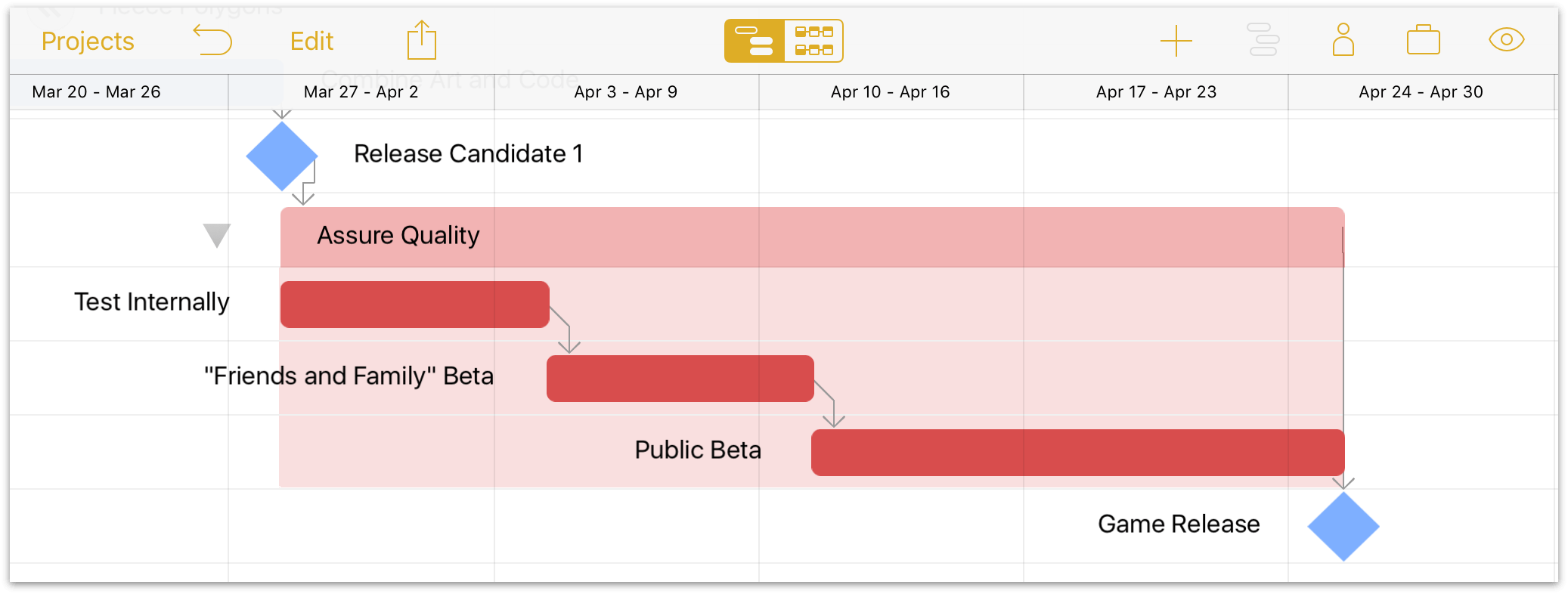
We want to release the game on May 1st, so we set the milestone’s Start at earliest date (in the Task inspector’s Scheduling pane) to reflect that.
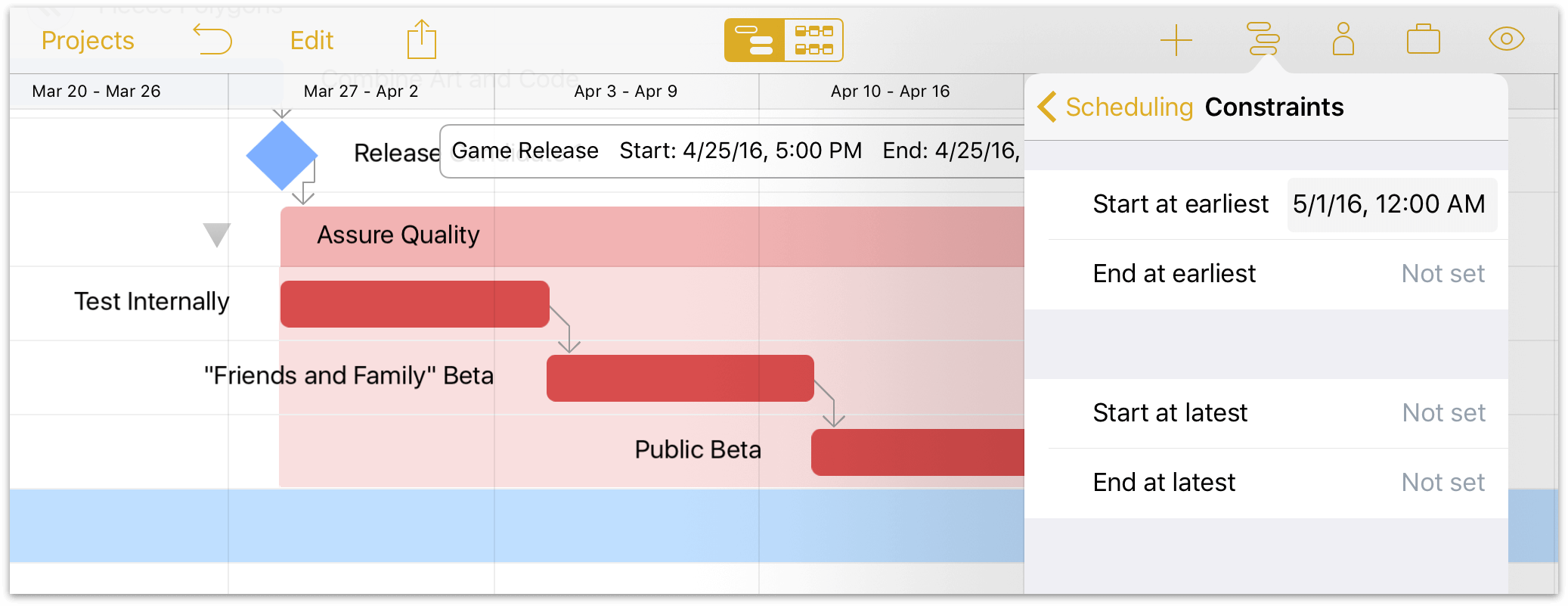
Note
This next step is only necessary because the task we want to convert to a hammock is part of a group with an expressed relationship to the milestone that follows. Creating contradictory dependencies between a group and the final task in that group results in a violation, and we don’t want that! To resolve the issue before it happens, remove the dependency between the Assure Quality group and the Game Release milestone. Don’t worry—we’ll replace it with something better soon.
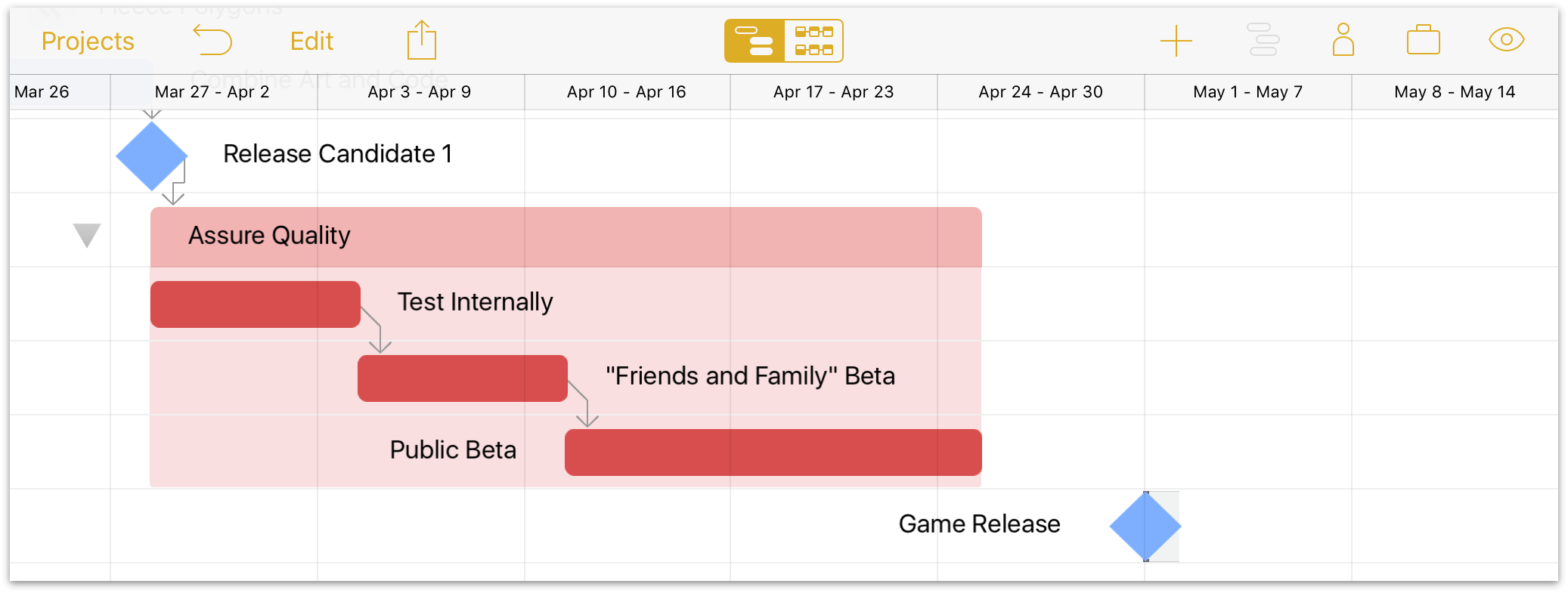
For a task to become a hammock task, it needs dependency relationships with the tasks preceding and following it. In our example the Public Beta task doesn’t have an explicit relationship with the Game Release milestone yet, so our next step is to create one. But what kind?
Our goal is to indicate that when Game Release starts, the Public Beta finishes. To do this, select the Game Release milestone and drag the left dependency arrow handle from the “start” of the milestone to the end of the Public Beta task, creating a Start ▸ Finish dependency between them.
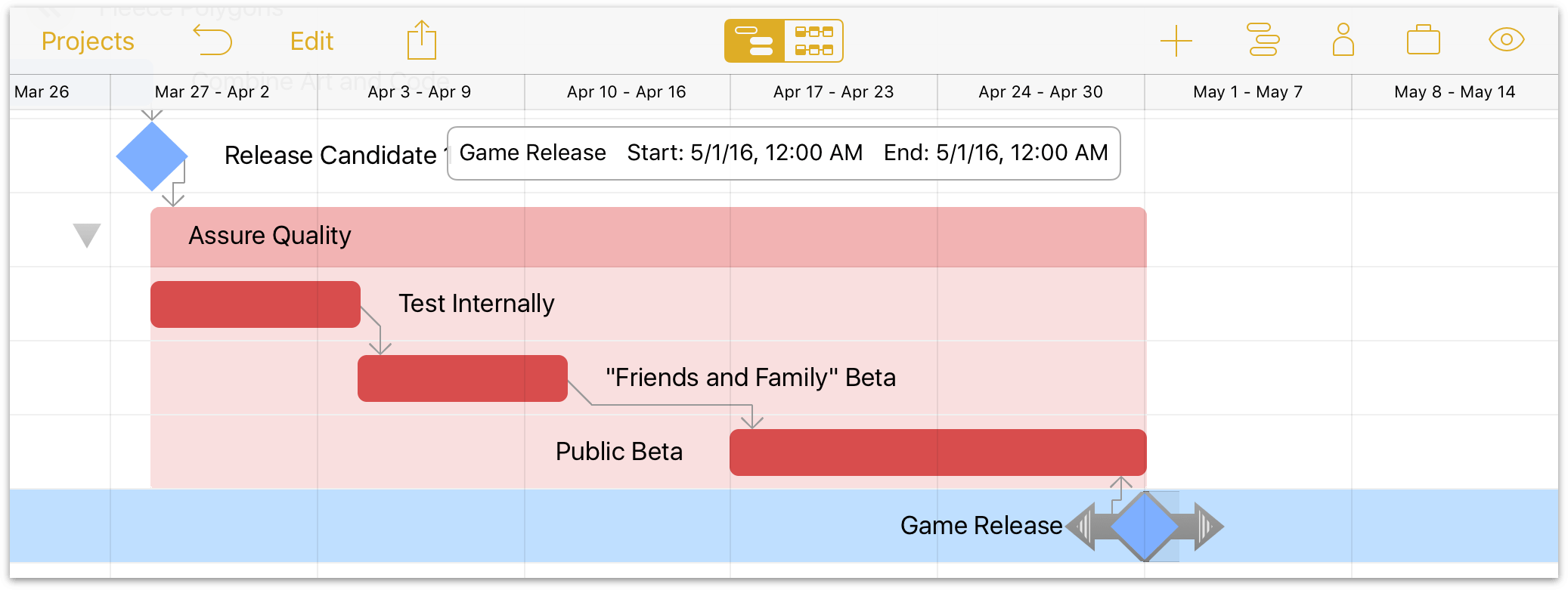
Public Beta is now in the proper state to be converted to a hammock task: It’s connected to the task preceding it with a Finish ▸ Start dependency, and the task following it (a milestone, in this case) with a Start ▸ Finish dependency. For the final step, select Public Beta and choose the Hammock task type for it from the Task inspector.
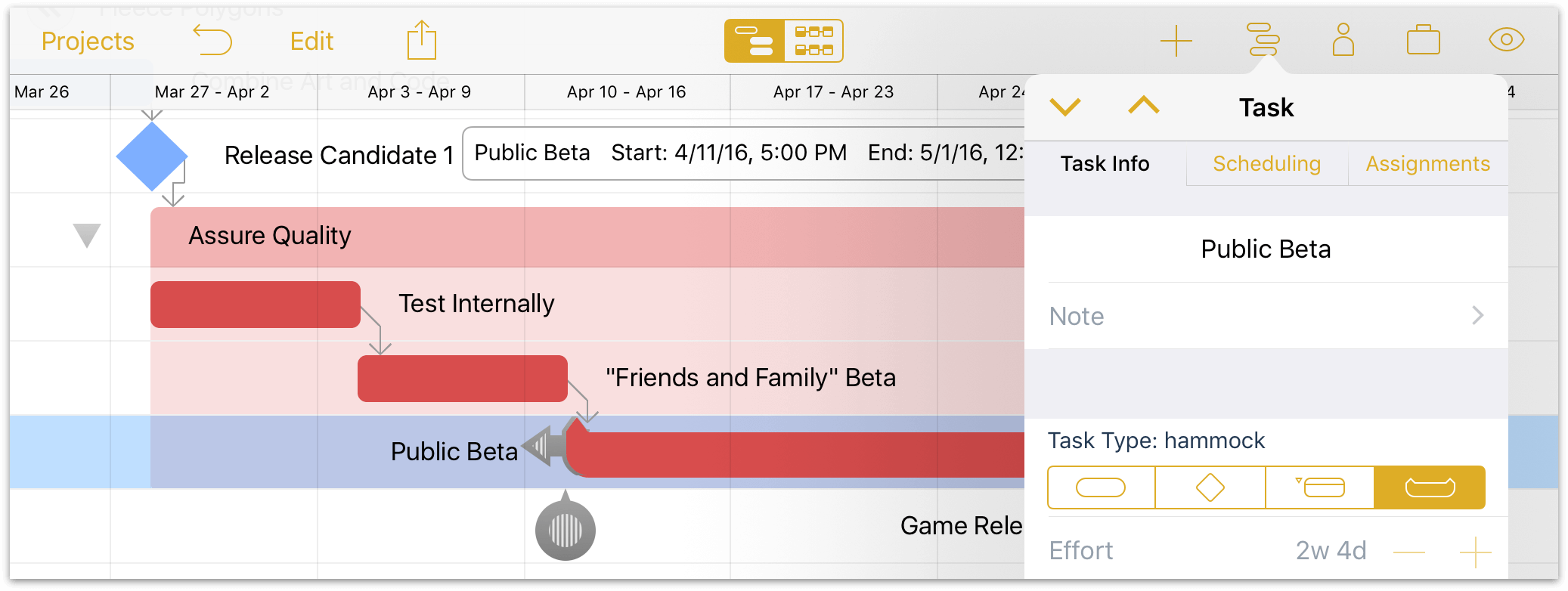
The duration of the hammock task extends automatically to fill the available space, in this case adding an extra week to the Public Beta test period. If the project is running ahead of schedule this period lengthens automatically, or if it’s running behind, it shortens right up until the scheduled release date.
Step 9: Editing the Work Week
Now that we’re starting to see the plan come together, we’ll set tasks aside for the moment and start setting up the work schedule for our project.
Open the Project inspector and tap Work Hours to access the regular weekly work schedule for the project. By default, working hours are Monday through Friday from 8:00 to 5:00, with an hour-long break for lunch at noon.
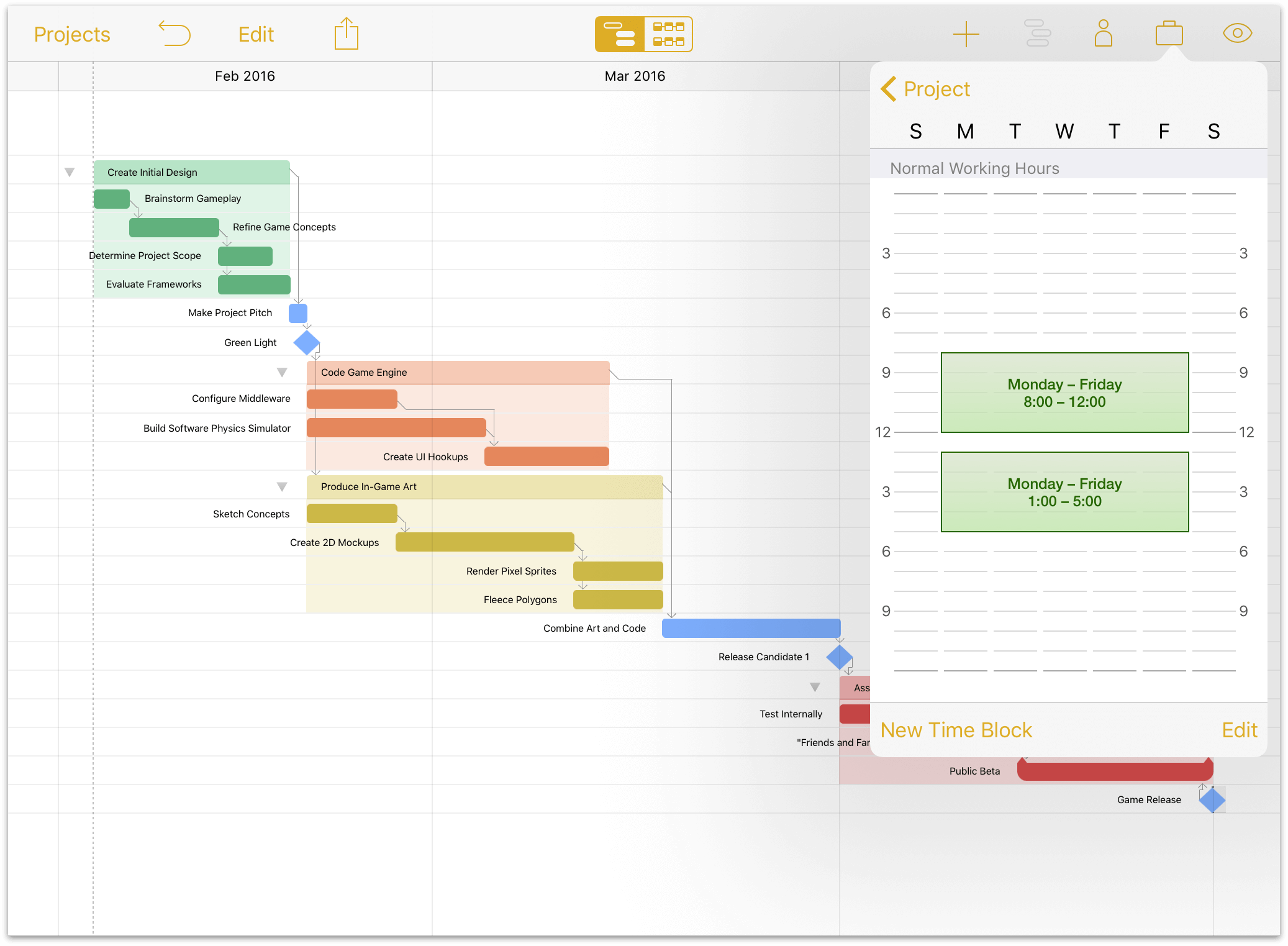
Since we’re working with a bunch of more nocturnal folks, let’s change the schedule to reflect that. Tap and hold one of the time blocks on the calendar to bring it to a new position, or drag one of the side handles to change the size of the block. We end up with a schedule that fits our needs:
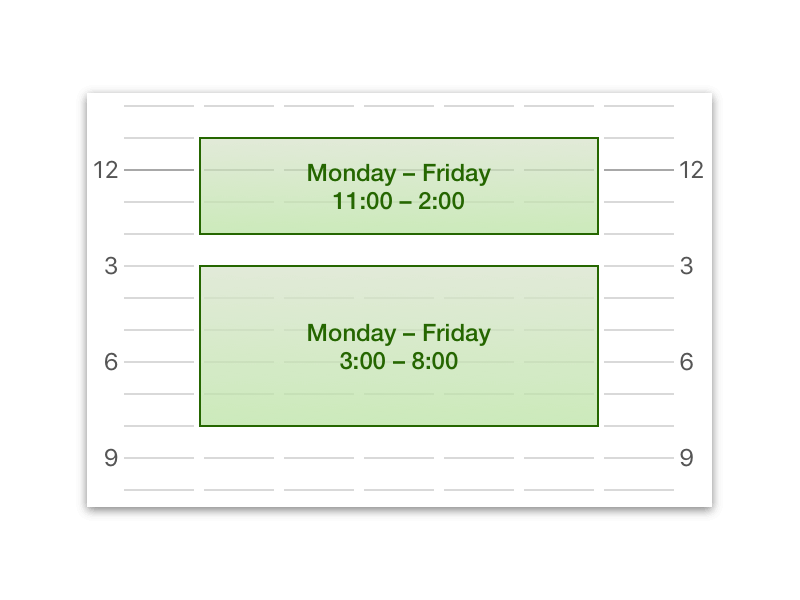
Time blocks can be created for individual days to indicate longer or shorter regular working hours (tap New Time Block), and deleted by tapping Edit.
Step 10: Setting Project Schedule Exceptions
Even the most accommodating work week will occasionally have days that are out of the ordinary. Whether it’s a national holiday, a team-wide training seminar, an industry expo or conference, or just a patch of bad weather that keeps folks out of the office, setting exceptions to the regular work schedule can be key to keeping a project on track.
One holiday we know is in the future for our project is a company tradition: Pi Day (3/14, or March 14th). We can add that to our schedule right now by returning to the top level of the Project inspector and tapping Calendar.

Green days on the exceptions calendar indicate regular work days. Swipe to scroll down to March, then tap the week of the 14th to access the exceptions calendar for that week.
Tip
For quick navigation between individual weeks of the exceptions calendar, swipe left or right on the numerical date headers. It’s a secret tiny productivity boost, and every little bit helps!
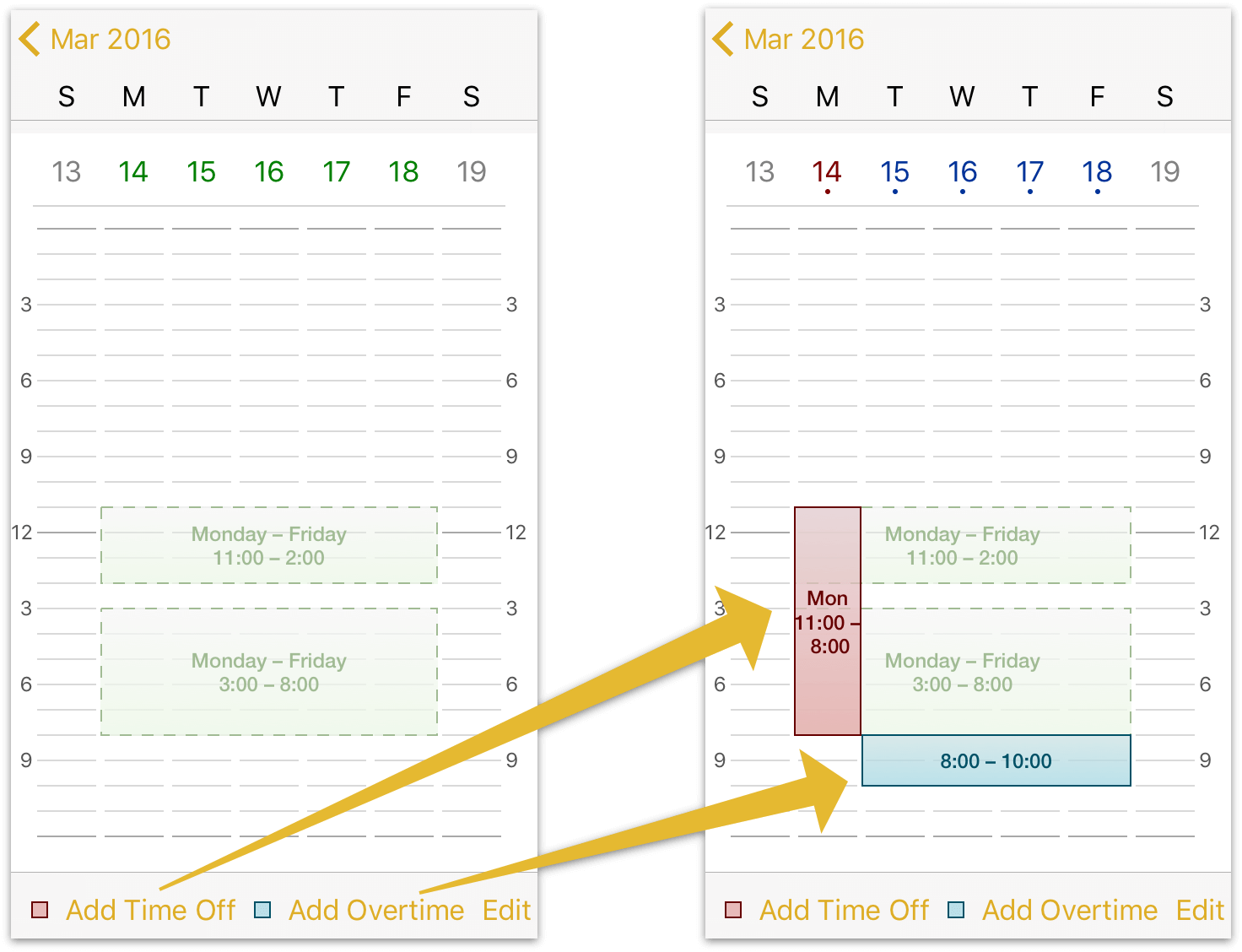
We know we want to take Pi Day off, but we can also predict that this week will be crunch mode for the team. We use the Add Time Off button to create a block of time that covers the 25th, and then replace that lost time with evening overtime hours through the rest of the week.
Tip
For an overview of holiday and weekend time in the context of your project, choose Non-Working Time from the View menu. You can opt to show holidays, holidays and weekends, or all days with work currently unassigned as shaded vertical bars in the Gantt chart.
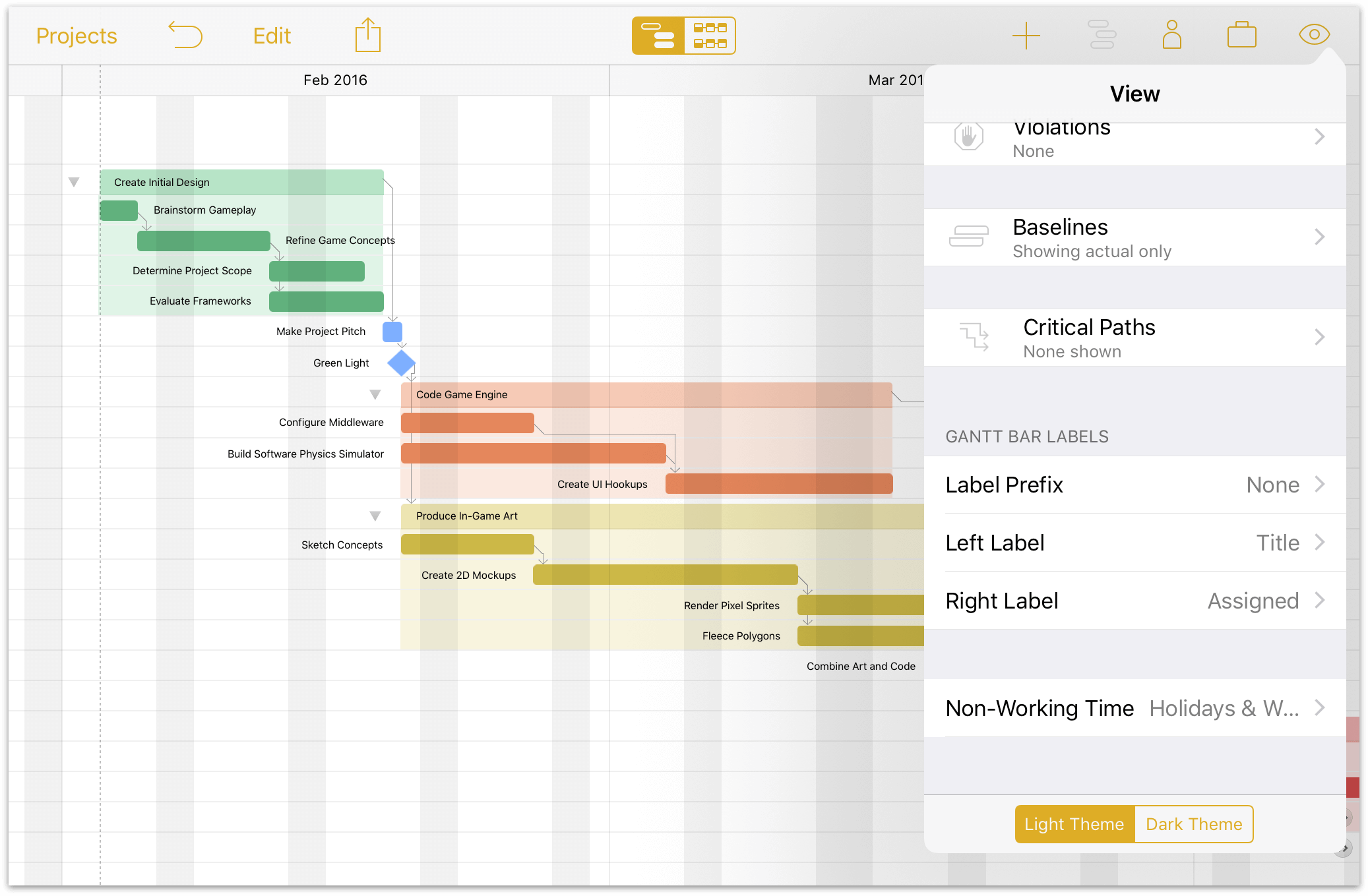
Step 11: Creating Resources
Now it’s time to start adding the team members, equipment and materials we’ll be using to bring the project to fruition. Every person, piece of infrastructure, and raw ingredient that contributes to reaching the project’s goal is counted as a resource, so let’s open the Resources inspector and get started.
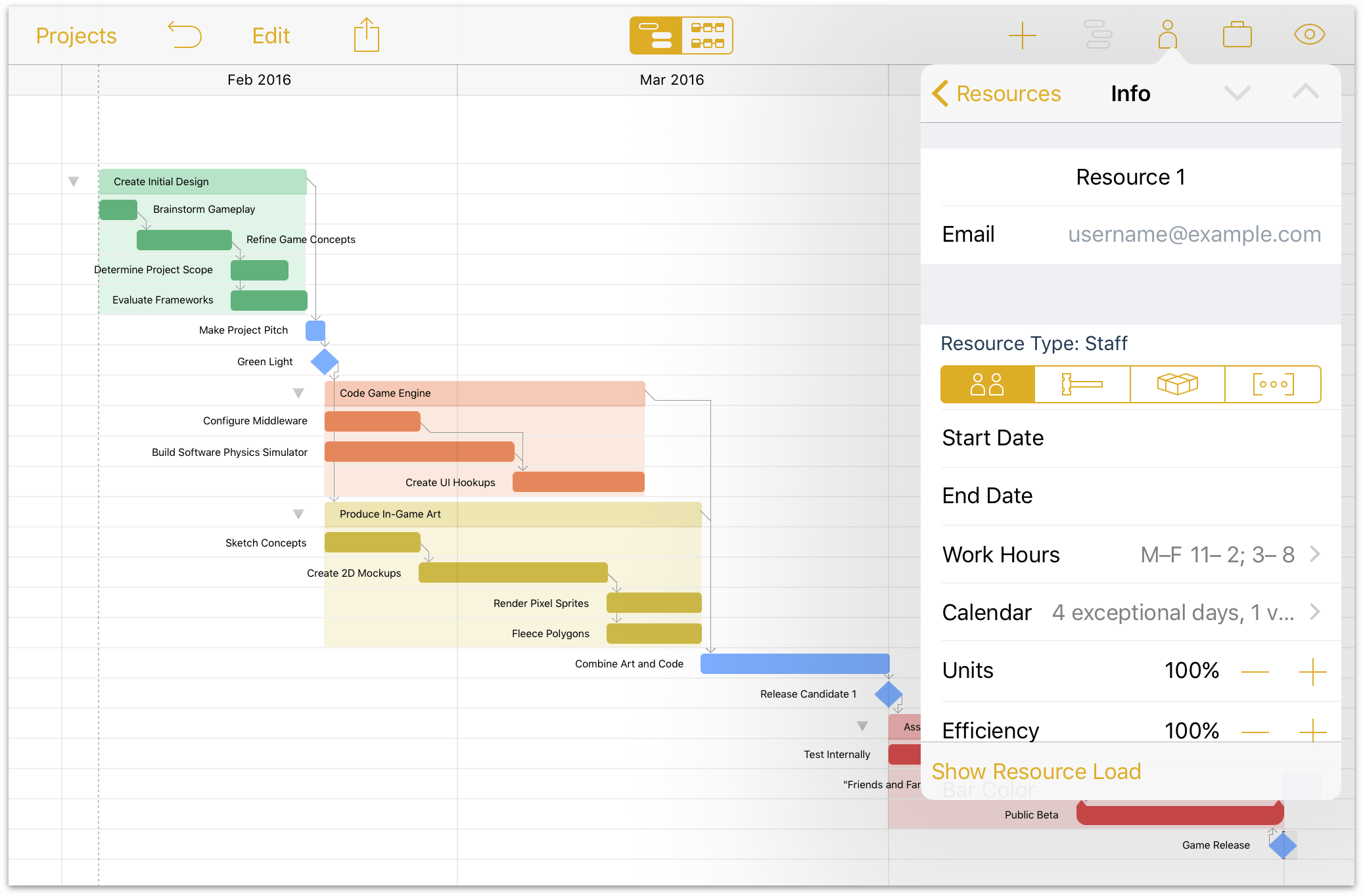
One resource has been created by default for our project – a staff member. Tap it to access and edit their details, including name, resource type, and personal calendar.
Note
When balancing workloads across multiple projects with OmniPlan Pro, a staff member’s email address is used as their unique identifier—so make sure their address is consistent across all the projects they’re participating in.
After editing the default resource we’ll create a few more to fill out the list of our team members and the technology they’re using to bring the game to life. Remove or rearrange resources at any time using the Edit button at the top level of the Resources inspector.
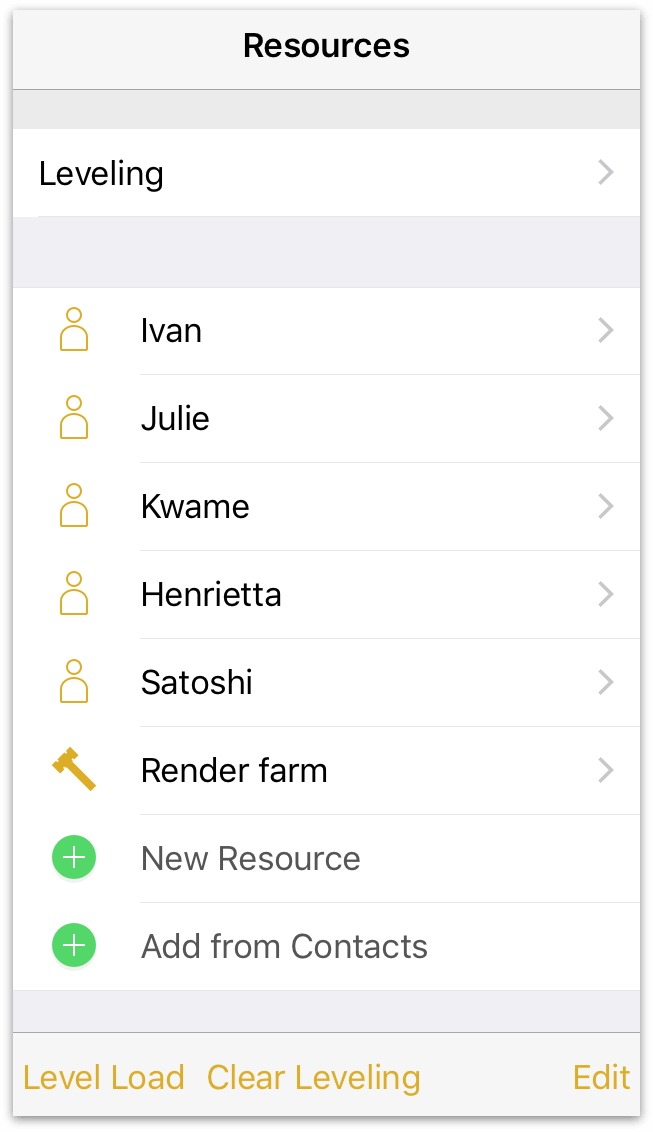
Step 12: Assigning Resources to Tasks
Assign resources to tasks by selecting the desired tasks in the Gantt chart (multiple tasks can be selected simultaneously using Edit mode), then opening the Task inspector and switching to the Assignments tab.
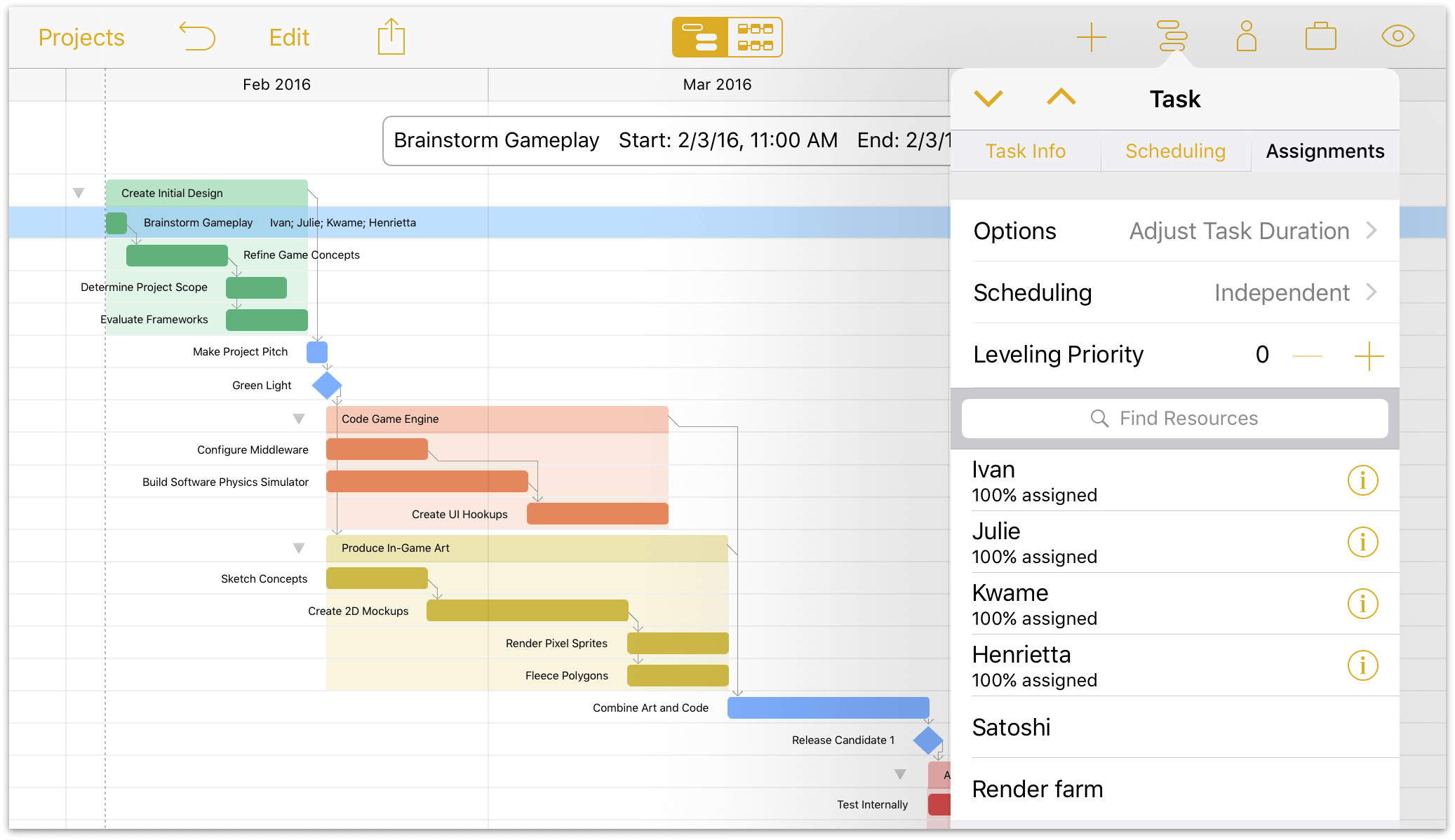
Tap each resource you’d like to assign to the selected task(s) and their names will appear next to each task that they’re assigned to.
By default, resources assigned to tasks commit 100% of their effort to those tasks. This can be affected in a few ways:
- The amount of effort a resource contributes to a given task can be manually set in the Assignments tab of the Task inspector. Assigning less than 100% of a resource’s effort to the task means the work will be completed more slowly, but frees time for that resource to be devoted to other simultaneous tasks.
- If a task’s assignment options are set to Adjust Assigned Amounts, the percentage of effort contributed by each resource will be reduced uniformly when new resources are added. This keeps both the task’s scheduled duration and required effort at constant set amounts.
- The amount of a staff member’s time dedicated to the project (relative to their full time schedule) is expressed by the resource’s Units value in the Resources inspector. If Ivan’s time is split between two projects that he spends equal time on, his Units value for this project should be set to 50%, and 100% of his effort value applied to a task in this project equates to 50% of his total time on the clock.
- A new trainee’s work might not be as productive as that of an experienced employee. In that case, the resource representing them should have its Efficiency value reduced while they are in training. This represents the amount of effort-per-time the team member contributes to tasks to which they are assigned; 100% of their effort accomplishes less than 100% of the effort of a fully trained worker.
Step 13: Setting Individual Schedule Exceptions
Individual staff members may have personalized work schedules, and they’ll almost certainly have individual needs for time off. In the Resource inspector, choose a resource and tap Work Hours to display their normal schedule.
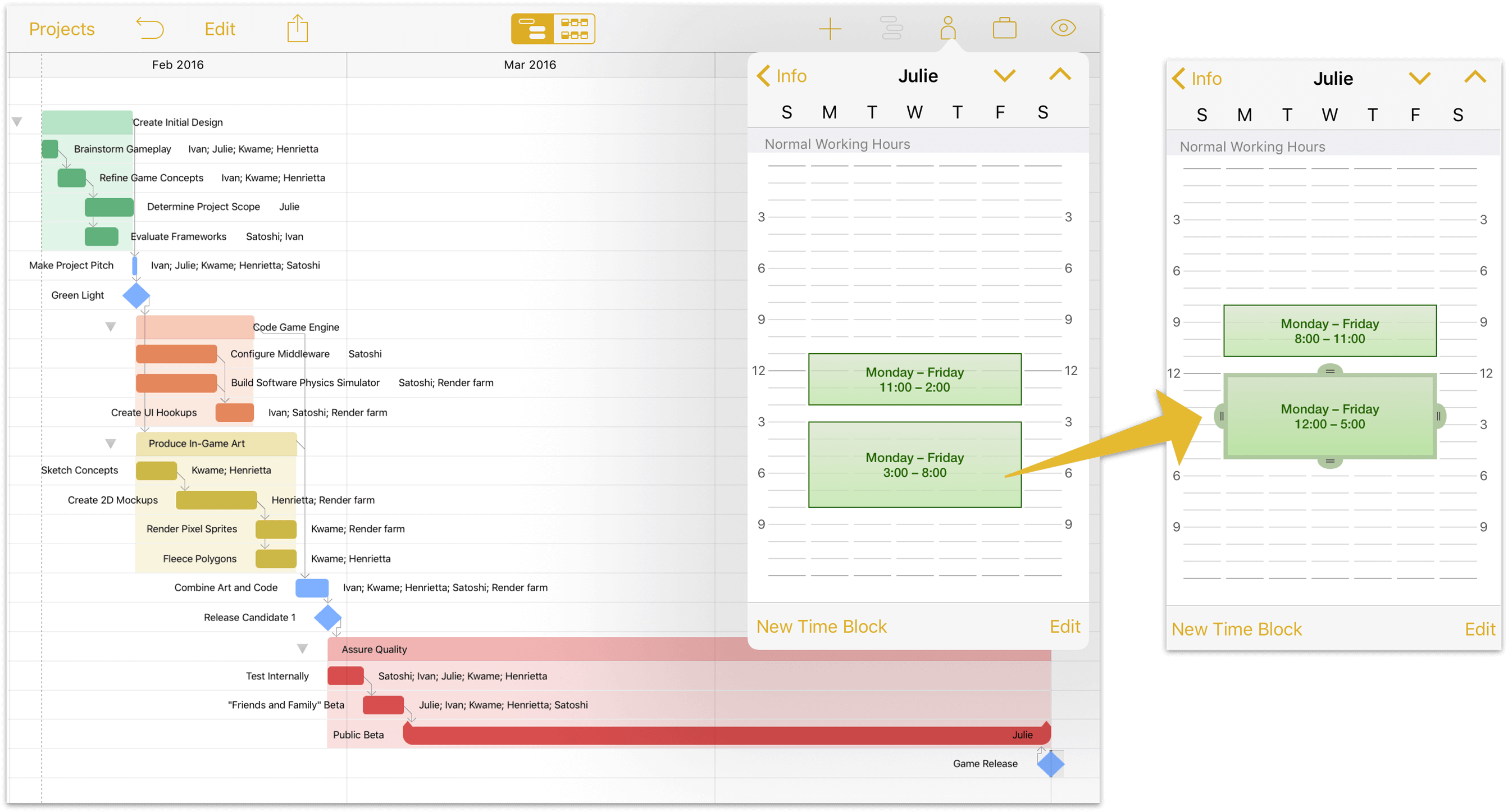
By default, Julie’s normal working hours mirror those we set for the project earlier. However, Julie is an early riser and works best in the morning, and we’re pretty flexible with hours as long as people are around through the afternoon, so we’ll shift her normal working hours forward a bit here.
Next, let’s look at Julie’s off hours. Tap Calendar to view a resource’s personal schedule exceptions for the project. As with normal work hours this schedule mirrors that of the overall project by default, with any project schedule exceptions included. To add schedule exceptions for the chosen resource only, tap the week where the schedule varies and use the Add Time Off and Add Overtime controls to edit the week’s schedule as needed.
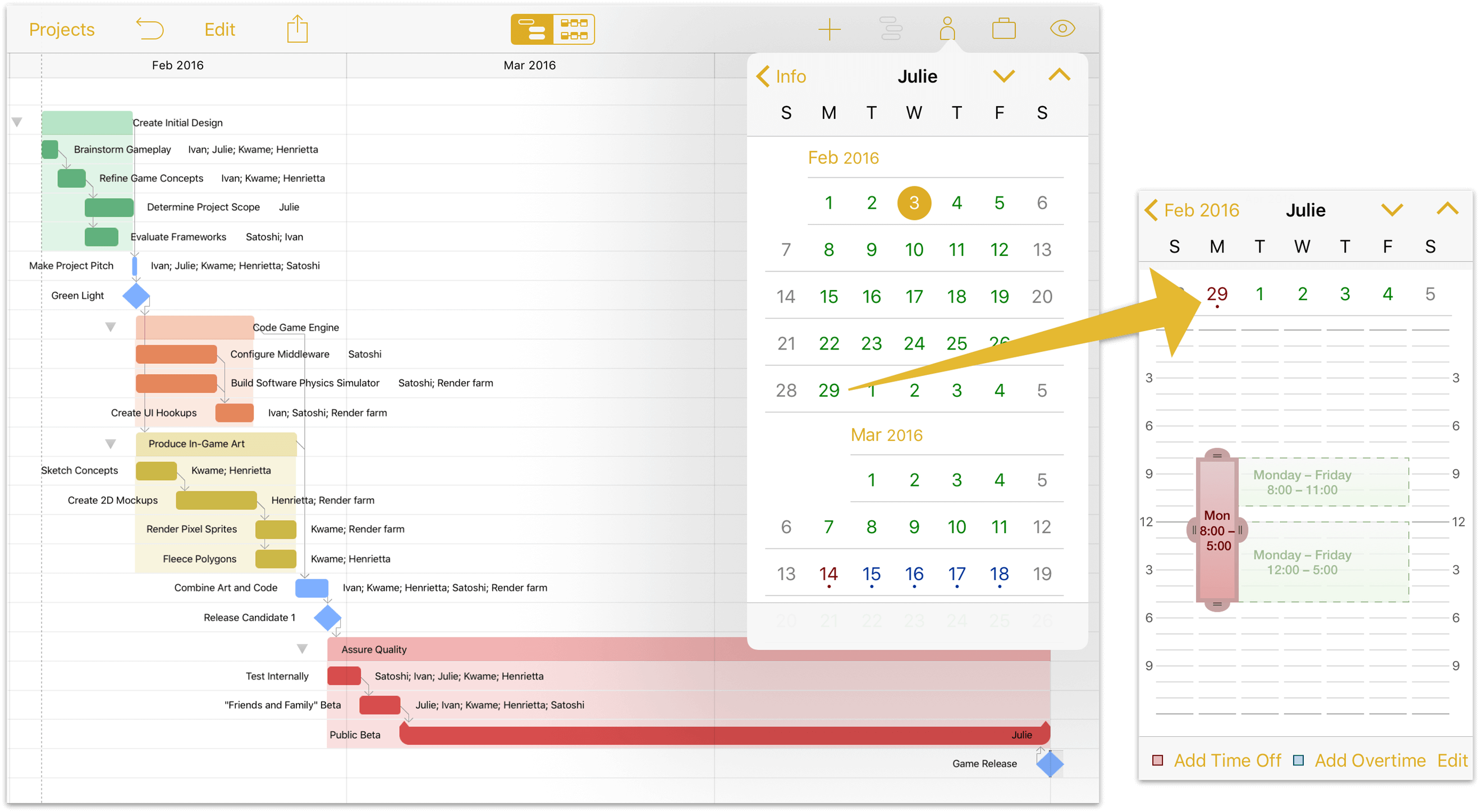
Julie’s birthday is February 29th, and she requested the time off four years ago. It would be criminal not to let her have it, really.
Step 14: Assigning Costs to Tasks and Resources
Once a project gets started, keeping track of expenses is a critical part of leading it to a successful conclusion. It’s just as important to plan those costs in advance, and at this stage in building the project we can get a pretty good feel for the budget by assigning costs to the tasks and resources we’ve added.
Where costs land the heaviest in your project depends what goes into accomplishing its constituent tasks. In the case of software development, much of the budget goes to employee salaries, with some going toward licensing middleware, outsourcing art and music production, facilities and equipment rental, and marketing (among others). Other projects, such as those in manufacturing and construction, have much higher costs in materials—lumber, bricks, silicon—or equipment rental.
Most project costs can be attributed in one way or another to a type of resource (Staff, Equipment, or Material), and resources can be assigned both Cost per Hour and Cost per Use values in the Resources inspector. Miscellaneous costs not associated with a specific resource can instead be added to the task itself, as Task Cost in the Task inspector.
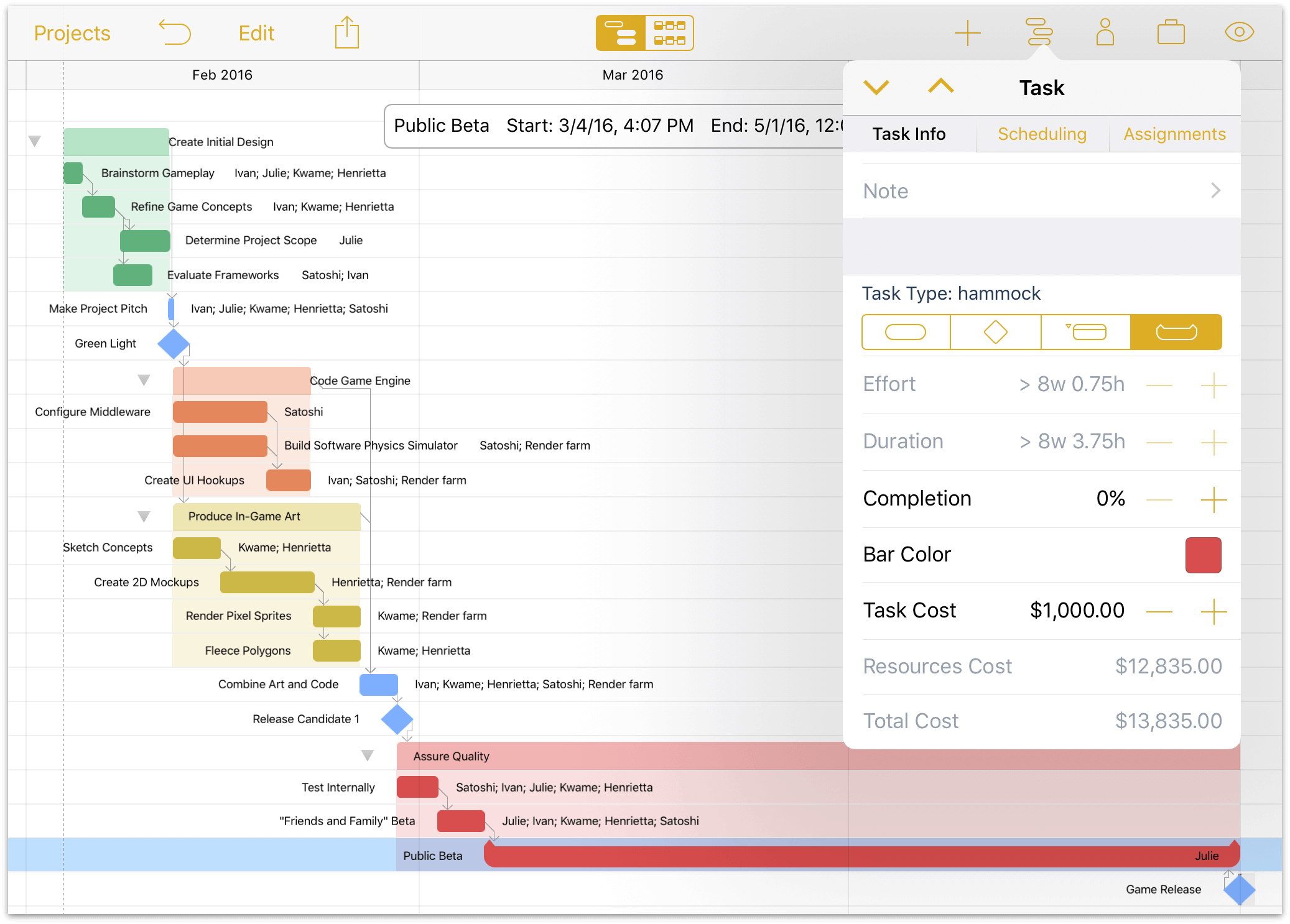
In this example, we see that the Public Beta task is currently scheduled to cost a total of $13,835. Most of this comes as the resource cost of paying Julie to take point throughout the public beta; the rest is a flat fee added to the task that we plan to use for marketing during this period.
Because we set the public beta up as a hammock task and we haven’t leveled or adjusted the project yet, it’s almost two months long. This isn’t an accurate reflection of what we anticipate once the project actually gets rolling, so we’ll want to keep a close eye on this number (it will almost certainly go down, as the duration of the hammock task shortens to allow for delays earlier in the project).
For the highest level view of expenses planned for the entire project, the Total Cost value listed in the Project inspector displays the sum of all resource and task costs currently calculated based on the cost values entered for the project’s individual tasks and resources.
Step 15: Leveling the Project
After assigning team members and equipment to the tasks that make up your project, you can ensure the team is at its most productive by leveling the workload across your resources and tasks.
It’s hard to overstate the power of leveling in OmniPlan. When you first level a project, you cross the line between human and machine—making the statement that you’ve added everything you know about the project to your document, and now it’s time to see what OmniPlan can do to help get all those things done optimally. Automation happens, and everything moves to its most efficient place based on the model of the project you’ve described.
To level the resource workload for your project, open the Resources inspector and tap Level Load. Unless your staff is already in the optimal configuration you’ll see the tasks in the Gantt view shift to accommodate the most efficient use of your resources’ time.
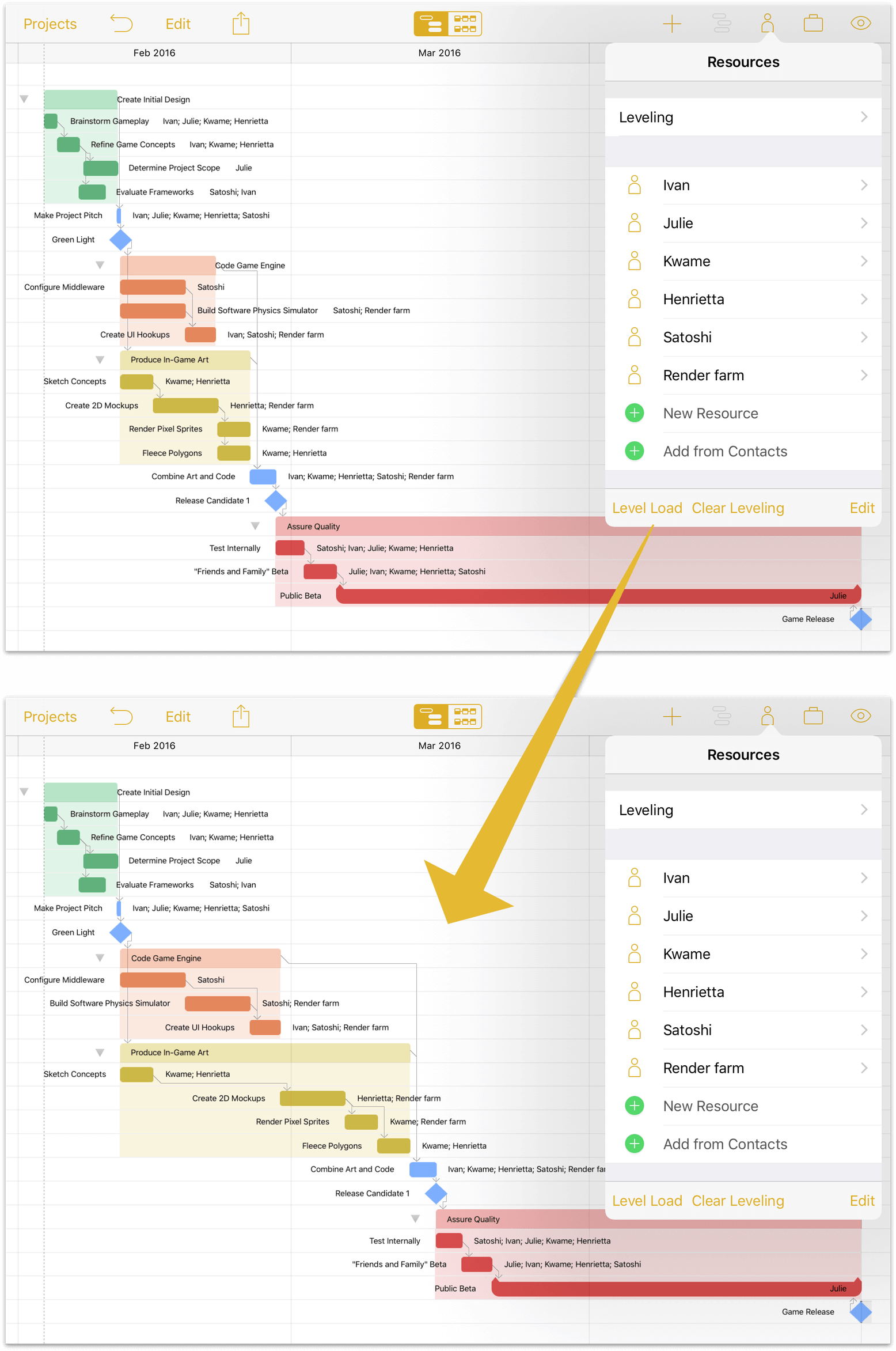
Optionally, choose Leveling from the Resources inspector and turn on Automatically Level to have OmniPlan optimize your resource use every time a change is made to your project.
Step 16: Setting a Baseline
With tasks set and resources assigned and leveled, the state the project is in now may be a glimpse at its fate in the best of all possible worlds – one where unforeseen hindrances don’t bog down progress, and where optimistic estimations rule the day.
This is the world that is captured when we set a baseline for progress, a feature used to compare how the project is actually doing against initial expectations, so milestones and resource allocation can be adjusted accordingly.
To set a baseline, open the View inspector and tap Baselines. Tap Set Baseline and enter a name (the current date is the default); it’s now selected for comparison, and can be compared against subsequently set baselines as the project progresses.
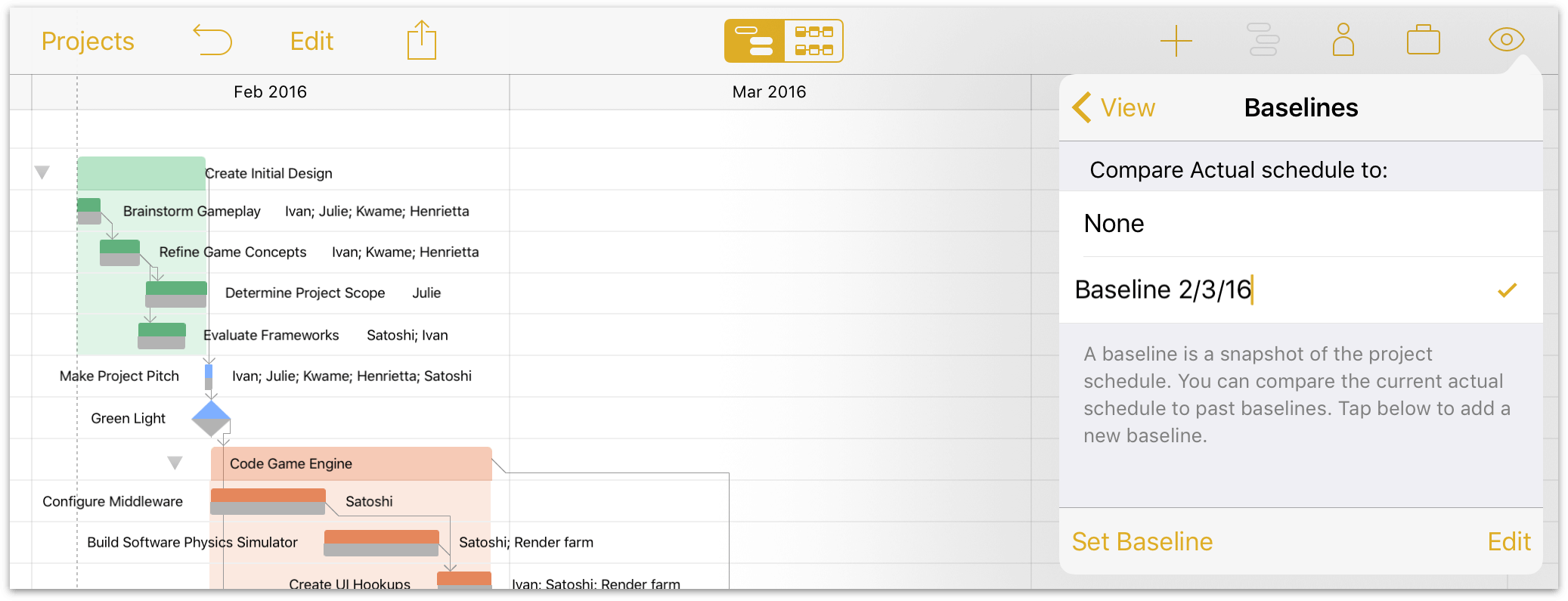
While you’re in the View inspector, now is a good time to check your project’s Critical Path (tap Critical Paths, then Overall Project, then Enabled). The critical path highlights the series of tasks and dependencies which determine the project’s duration. If any of the tasks on a critical path ends up taking more or less time than planned, then the duration of the project as a whole will change as well.
In the case of our example project, the hammock task at the end is designed as a “shock absorber” for earlier phases of the project, so it alone lies on the critical path—if it becomes delayed, its start date moves beyond the date we plan to ship the product.
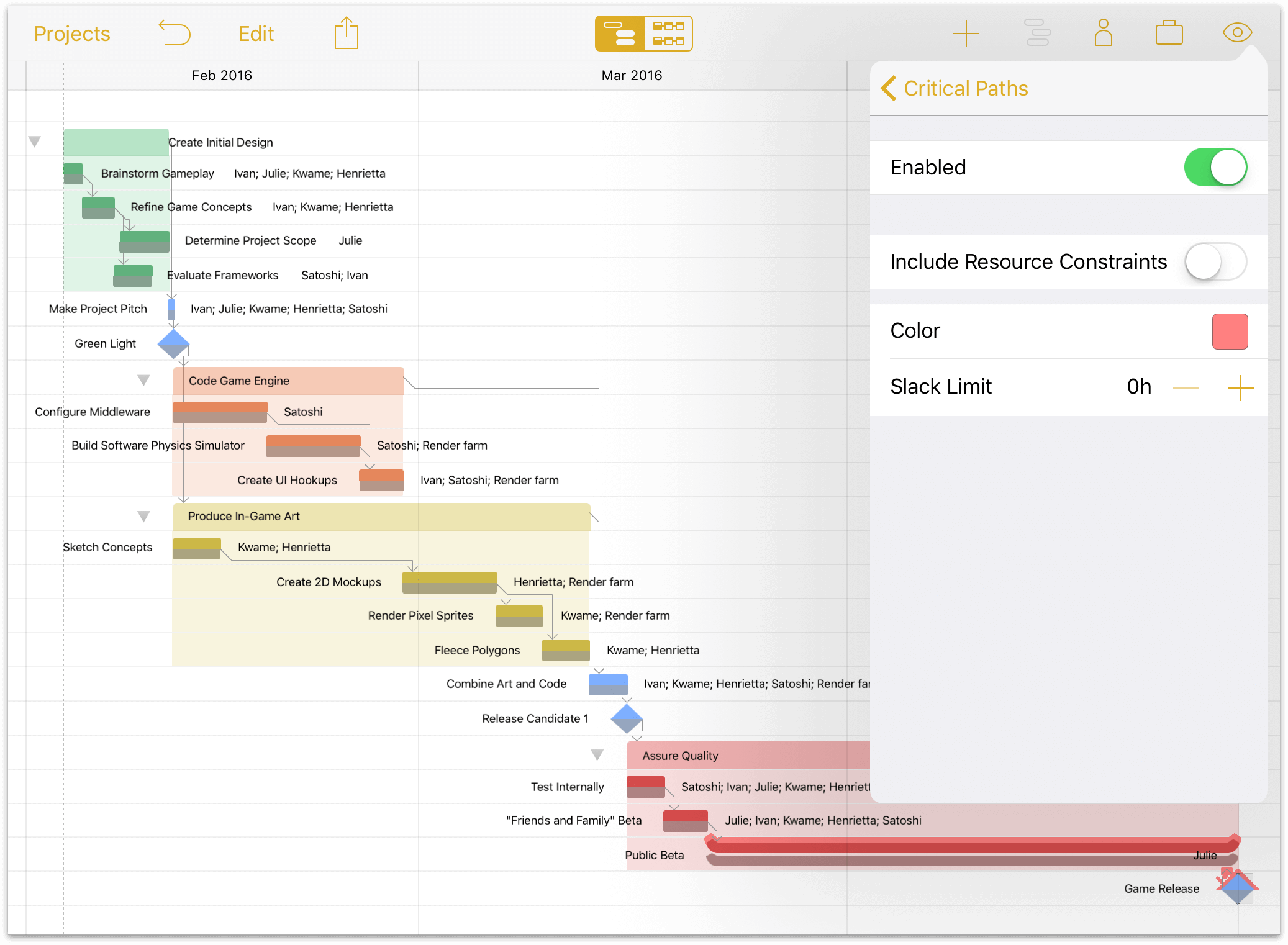
Here before us is our project in its ideal form, right before the real work begins. We have a good picture of what to expect if our estimates are accurate and everything goes well—and fortunately, we also have the tools to adjust along the way if things don’t go exactly according to plan. In the next chapter, we’ll use these tools to begin managing a project.
Managing a Project
Once work on a project begins, the steps to keep it running aren’t quite as predictably sequential as the ones used to set it up beforehand. The first few steps presented in this chapter are things to keep an eye on regularly, but some of the other tools are more specialized—they aren’t always needed, but when they are, they can be a huge help for keeping work progressing smoothly or correcting the course when unexpected situations arise.
Step 0: Checking the Baseline
We ended the project building tutorial by establishing our project’s first baseline: a snapshot of the project in its initial state, before work begins. Before proceeding further, double-check that you have this baseline saved for reference — from here on your project will be changing in ways that can’t easily be reverted, and it’s not intended for them to be. The baseline acts as a point of reference for the initial plan when you need one.
Step 1: Updating Task Completion
As work on the project begins, you can track progress against the baseline you’ve set by tapping a task currently in progress and moving the slider along to the task’s completion percentage (this can be edited in the Task inspector as well).
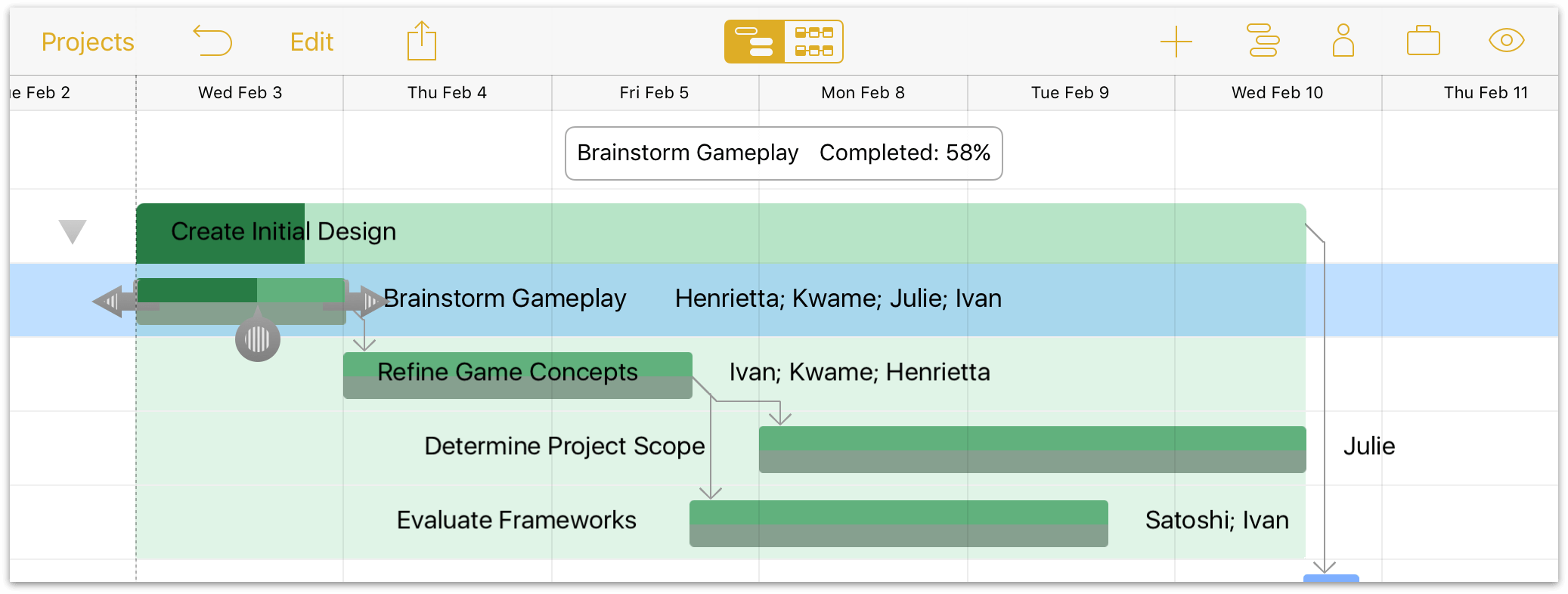
If everything is proceeding according to plan, you can use the Catch Up tool in the Project inspector to advance the completion percentage of all tasks to where they should be as of the end of today’s workday.
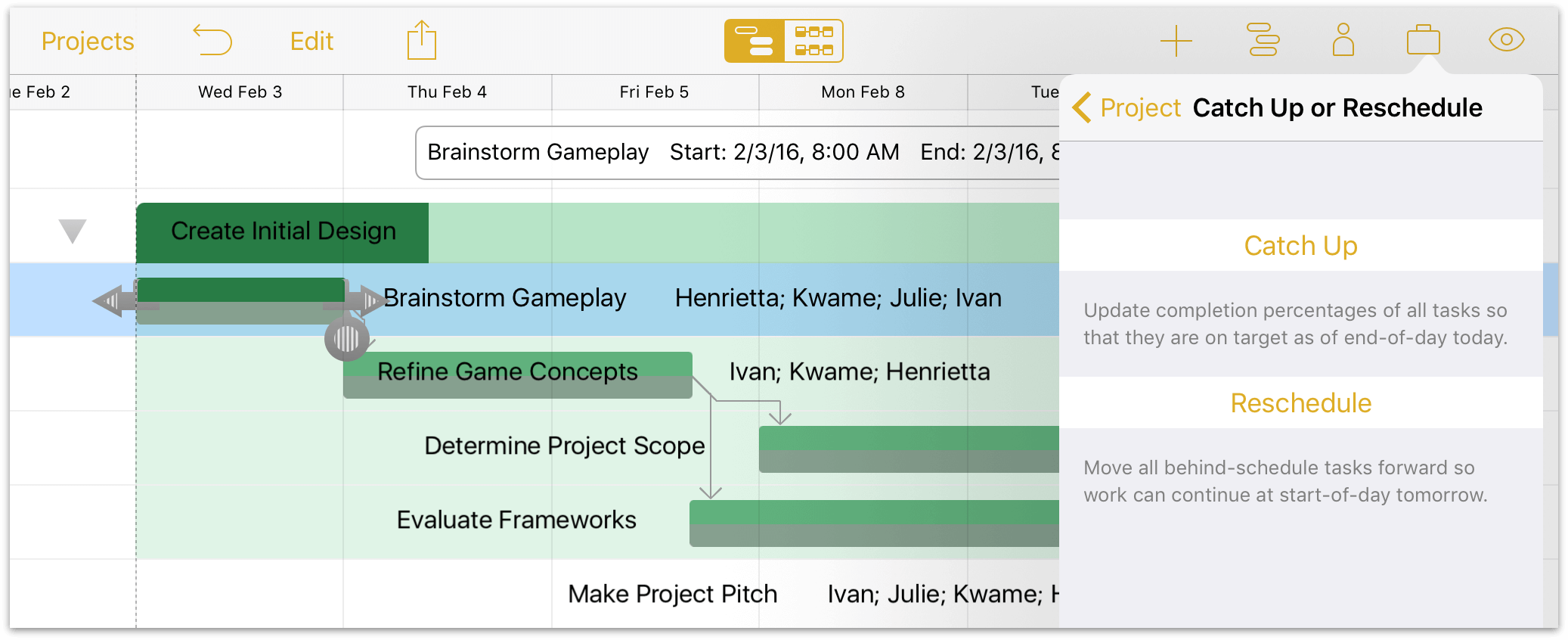
Step 2: Rescheduling Tasks
If a task is behind schedule, update the expected duration and level resources again to compensate for the additional time needed.
Alternatively, if all other work in the project has been accounted for manually, you can use the Reschedule tool to advance tasks with incomplete work to the beginning of the next workday.
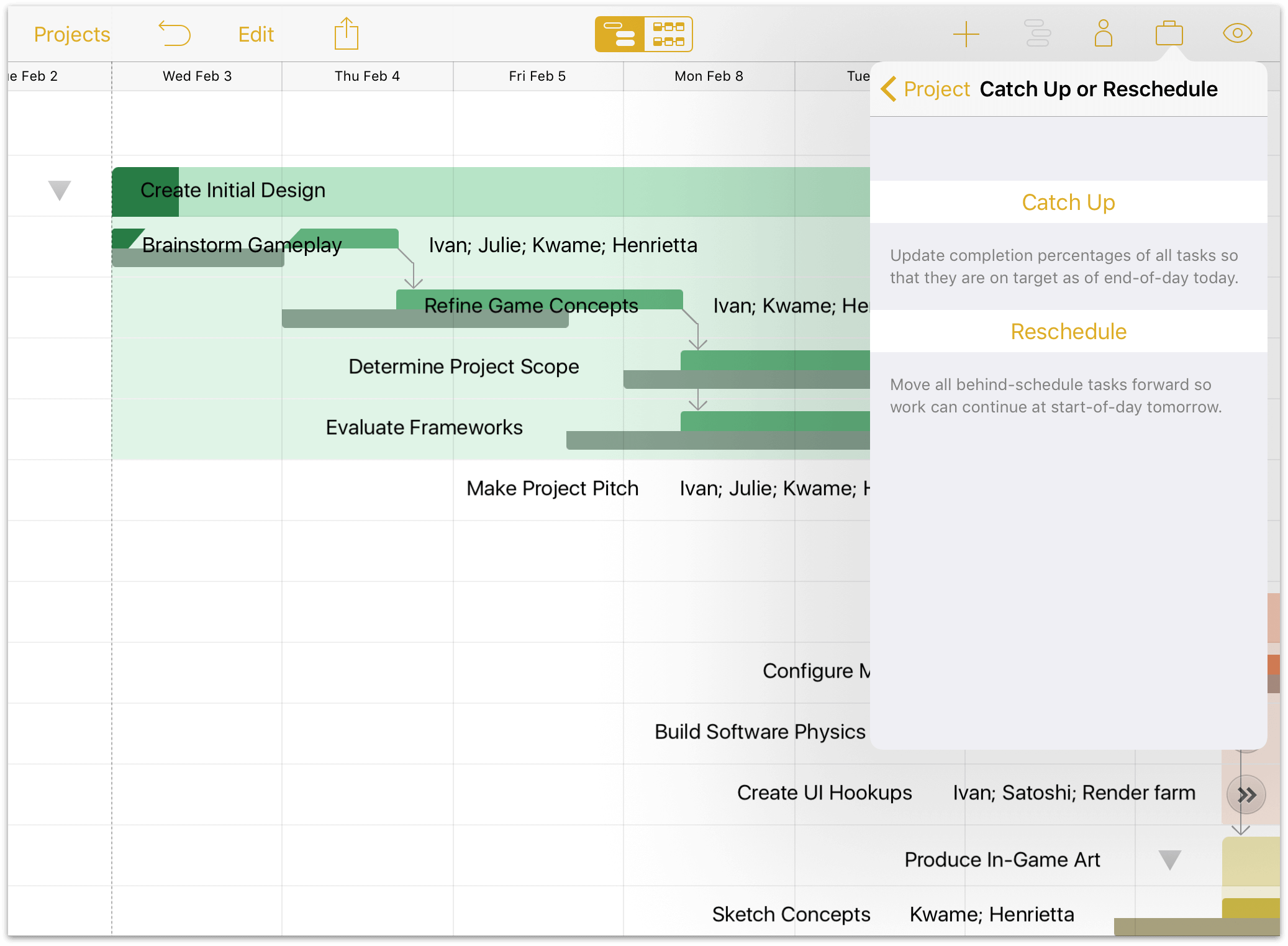
If a task is partially complete, rescheduling will split the task and leave the completed portion in its original position, advancing only the incomplete work.
Step 3: Resolving Violations
Occasionally situations will emerge that break the rules of logic you’ve set up for your project. When one of these occurs, OmniPlan will let you know with an icon indicating a violation related to the adjacent task.

Violations can be fixed by opening the View inspector and tapping Violations, or by tapping the violation icon next to the task itself. You’ll find a description of the problem and a command to tap that should resolve it.
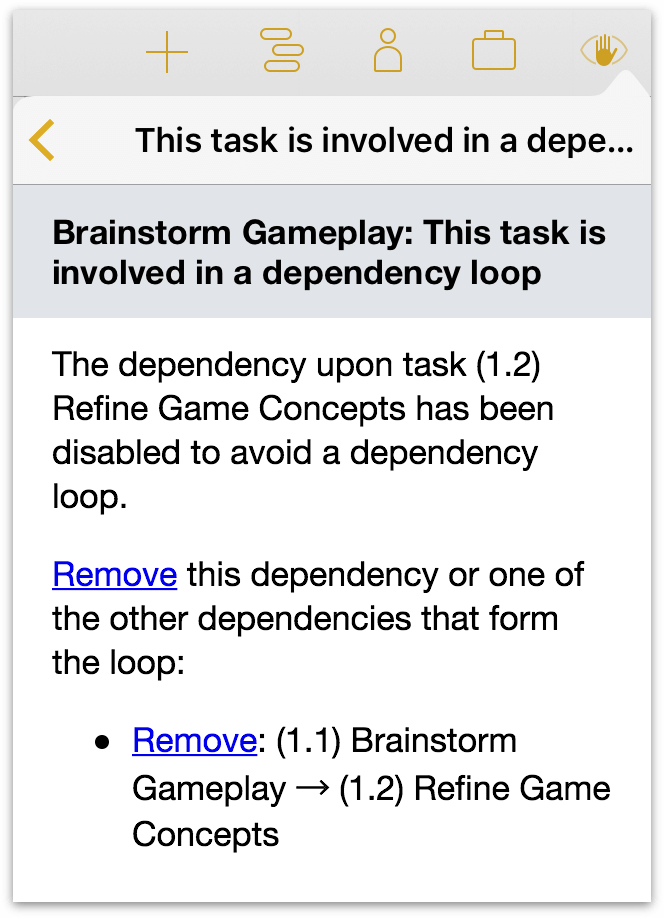
Step 4: Leveling the Project (Again)
After your project has been progressing for awhile, facts on the ground may change to the point where the initial plan has become largely irrelevant. Things are kept as efficient as possible by automatically leveling, but if something big happens—like a change in deadlines, project requirements, or personnel—you’ll want to be sure those changes are reflected in the plan, and then level the project again.
Optimal resource allocations can shift significantly due to these changes, and it’s important to know about them as soon as possible to make sure resources are working where they’ll be most useful.
Major turning points in the project—whether pre-planned milestones or unexpected diversions—are also a good time to set new baselines for progress. OmniPlan supports as many baselines as you find useful, and resetting the clock after a major shift provides a much more useful basis for progress than continuing to compare with an increasingly outdated preliminary plan.
Step 5: Splitting Tasks
Whether because a key collaborator is on vacation or another part of the project has taken priority, suspending work on a particular task can be very helpful. When you want a resource or team member to devote time to something other than the task they’re currently assigned to, splitting the task into parts around the "time out" period is a possible solution.
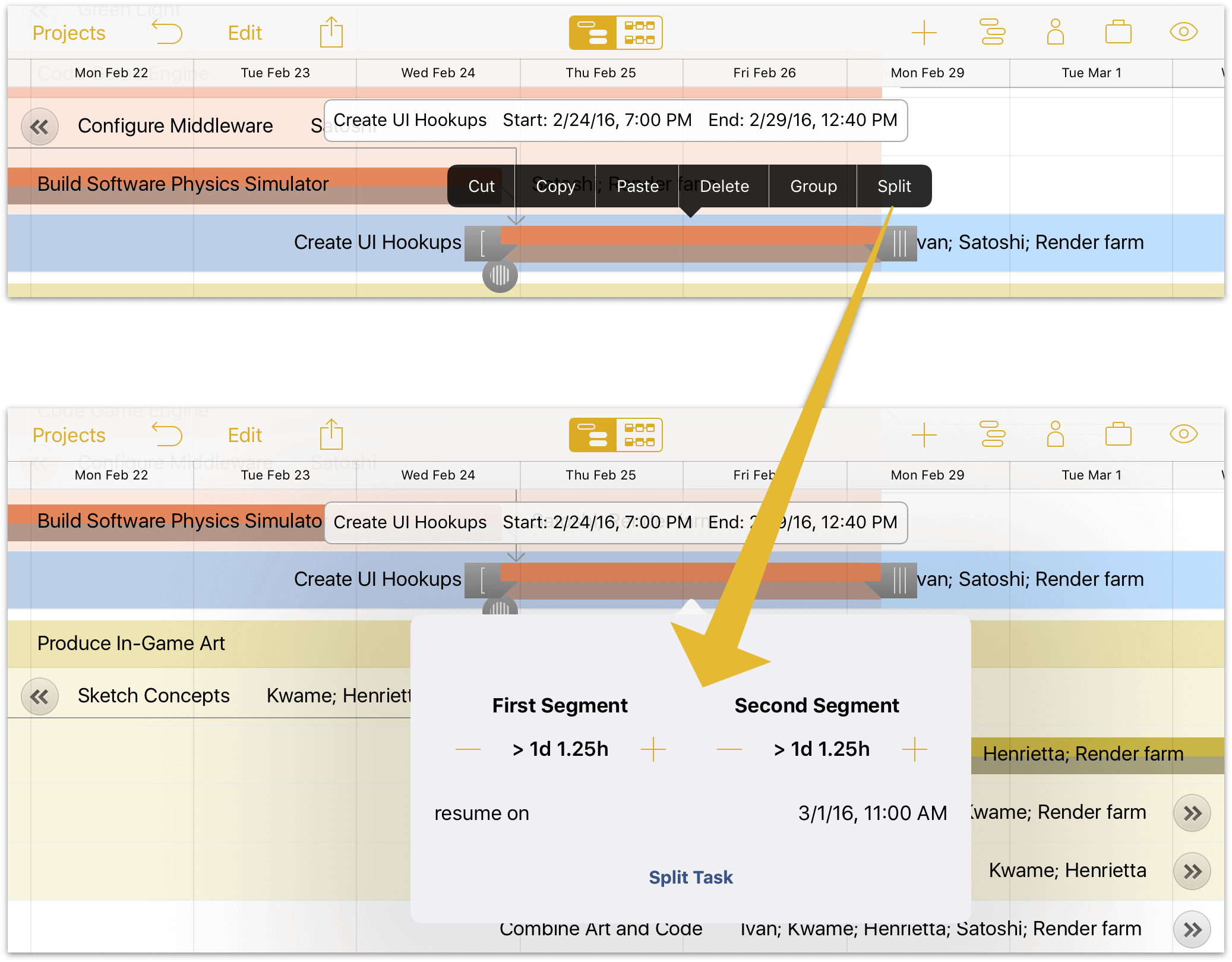
To split a task, touch and hold it in the Gantt chart until the contextual menu appears, then choose Split. You’ll be asked to choose the duration of each segment of the task, and the date and time you want the task to resume after the break. If the resource will be absent during the split, remember to indicate this on its schedule in the Resources inspector.
Note
The schedules of individual resources (usually workers) can be customized to account for personal vacation or sick days by selecting the resource in the Resources inspector and choosing Calendar.

After splitting a task it’s always a good idea to level to be sure the split is the most efficient way to manage the task at hand given the project’s available resources and time constraints.
Tip
A split task may mysteriously re-merge after leveling. If this isn’t what you want, make sure that Allow Splitting is turned on in the Resources inspector’s Leveling submenu.
Step 6: Simulating Milestone Completion Estimates (Pro)
OmniPlan 3 Pro includes tools for calculating the degree of certainty that a milestone will be complete by a given deadline, using Monte Carlo simulations based on estimations of the effort required to reach the goal. The results of these simulations can help identify where things might fall behind (or even be ahead of schedule).

To run a simulation, open the Project inspector and choose the Monte Carlo tool. The level of certainty the simulation provides is determined by the amount of effort estimated as required for completion of the tasks within each milestone, so prior to running a simulation you’ll want to use the handy Auto-Estimate Effort feature to add effort estimates to your tasks.
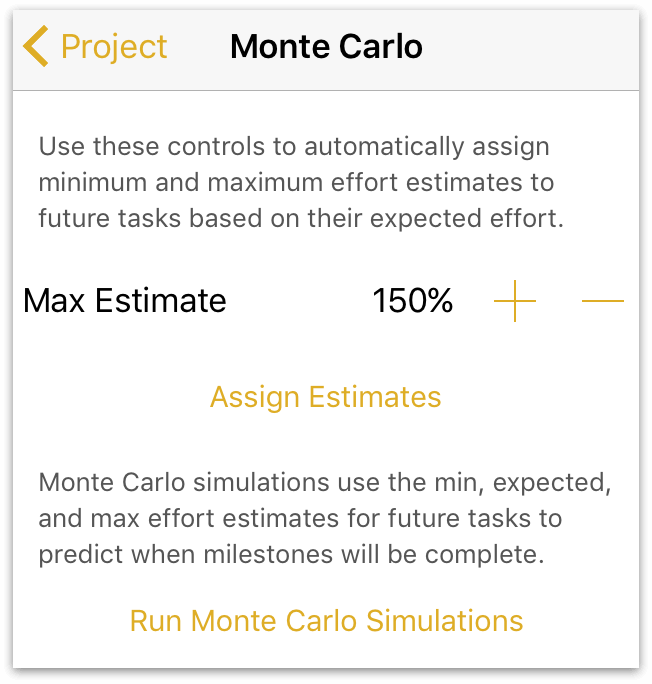
The Max Estimate percentage represents the expected range of deviation for the amount of effort that tasks within your project will require. The default is 150%, indicating that a typical task in your project can be expected to require anywhere between 50% and 150% of its expected effort to complete (the average being 100%).
Lowering the max estimate percentage indicates higher confidence in the effort values currently assigned to tasks, and reduces the variance of the simulation (setting the max estimate to 100% would set the minimum estimate to 100%, implying that you’ve seen the future). Conversely, raising the value indicates that your current effort predictions are more of a shot in the dark.
When you tap Assign Estimates, OmniPlan quickly generates hundreds of random effort values for each task within the percentile range indicated, and then takes the average result and applies it to each task for purposes of determining the likelihood that a given milestone will be completed on time.
Once the simulation is complete, a set of striped horizontal bars appears on days surrounding each milestone (represented as a small diamond). One stripe equals 10 percent confidence that the milestone will be complete on that day, while 10 bars on a day means that according to the simulation, a milestone is 100% likely to be completed on that day.
Multi-User Collaboration (Pro)
On a large project, or one where the collaborators are geographically diverse, you may want to have multiple team members able to update the project status remotely. With OmniPlan Pro for iOS, working together no matter where you are is made possible by a powerful and intuitive publication, subscription, and change tracking system.
This chapter describes scenarios where such collaboration is particularly useful, and provides a tutorial for setting up and working on shared projects.
Prologue: Why Collaborate?
Whether OmniPlan’s collaborative syncing features are appropriate for your project depends on a few factors. If the project is administrated, edited, and updated primarily by a single individual, and resources relevant to the project are exclusive to that project (among projects administrated simultaneously by the user), the standard edition of OmniPlan offers OmniPresence sync as a solution that meets most needs.
If a project has multiple editors—staff who update their own task completion percentages and extra hours worked, or site managers who track resource costs, for example—the need for collaborative features becomes evident. When stored in a shared server repository, multiple users can publish and subscribe to changes to a project, and the project’s administrator can review and accept or reject each change as it is made.
Likewise, if resources are shared between multiple projects simultaneously (staff working on Phase 1 of Project Alpha and Phase 3 of Project Beta concurrently), storing projects in the same repository allows resources with the same unique identifier to be leveled intelligently across all projects that include them.
If either of these scenarios apply to your project, the publication and subscription features of OmniPlan Pro repository sync are just what you need.
Step 0: Installing the OmniPlan 3 for iOS Pro Upgrade
To begin sharing a project for collaboration with multiple users, first be sure that the OmniPlan Pro upgrade is installed with your copy of OmniPlan. You can check whether it’s installed by visiting OmniPlan Settings in the document browser and choosing About OmniPlan. The about panel indicates whether or not the Pro upgrade is installed.

If you previously purchased the OmniPlan 3 for iOS Pro upgrade but haven’t yet installed it for this copy of OmniPlan (perhaps because it’s on a new device), choose Upgrade to Pro from OmniPlan Settings and tap Restore Purchases on the Pro Upgrade screen. And if you haven’t yet upgraded to Pro, this is the place to do it.
Step 1: Creating a Sync Repository Account
With OmniPlan Pro installed, the Locations screen of the Document Browser adds a Server Repositories location type alongside Local Documents and the option to add an OmniPresence account.

The process of creating and connecting to a server repository account is described in Multi-User Publication and Subscription (Pro) in the Getting Synced chapter, and the instructions there will help you get your first account up and running quickly (or connect to an existing one).
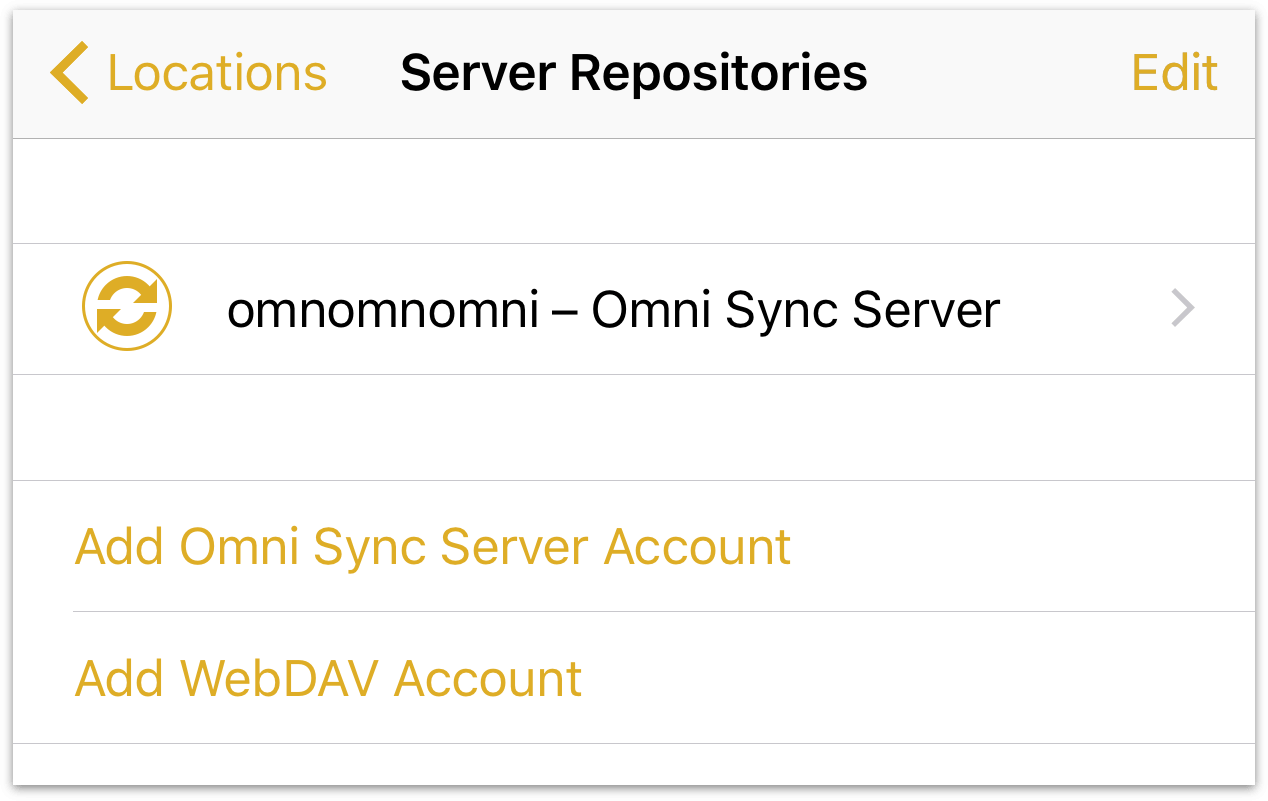
Step 1a: Importing an Existing Shared Project
When you have a server repository account connected, you’ll see it listed on the Server Repositories screen. To work on an existing project in the shared account, tap the account name and choose the project from the list.
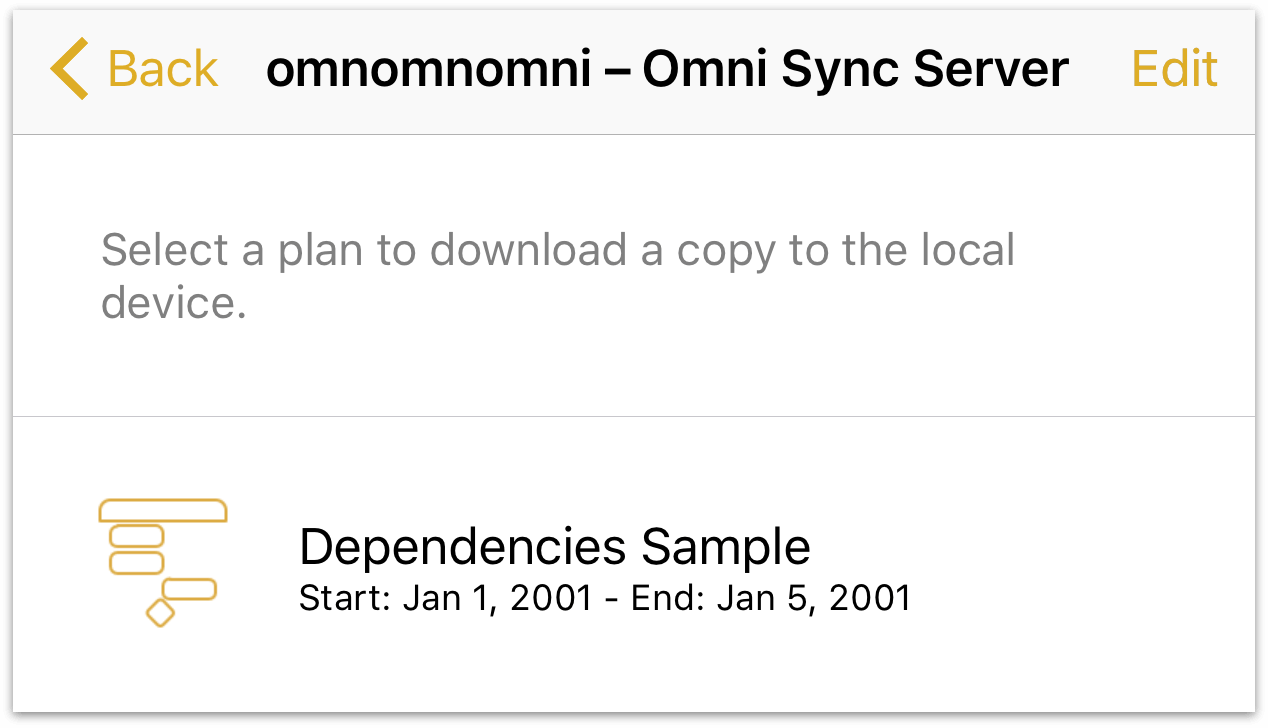
When you choose an existing project in a shared server repository, it is downloaded and copied to the Local Documents location in the Document Browser. It is available for editing just like any other OmniPlan project, with one important addition: it comes with its server repository settings pre-configured. The project is ready to publish its changes and receive updates from the server, and will by default publish changes to its resource loads and subscribe to those made in other projects on the server.
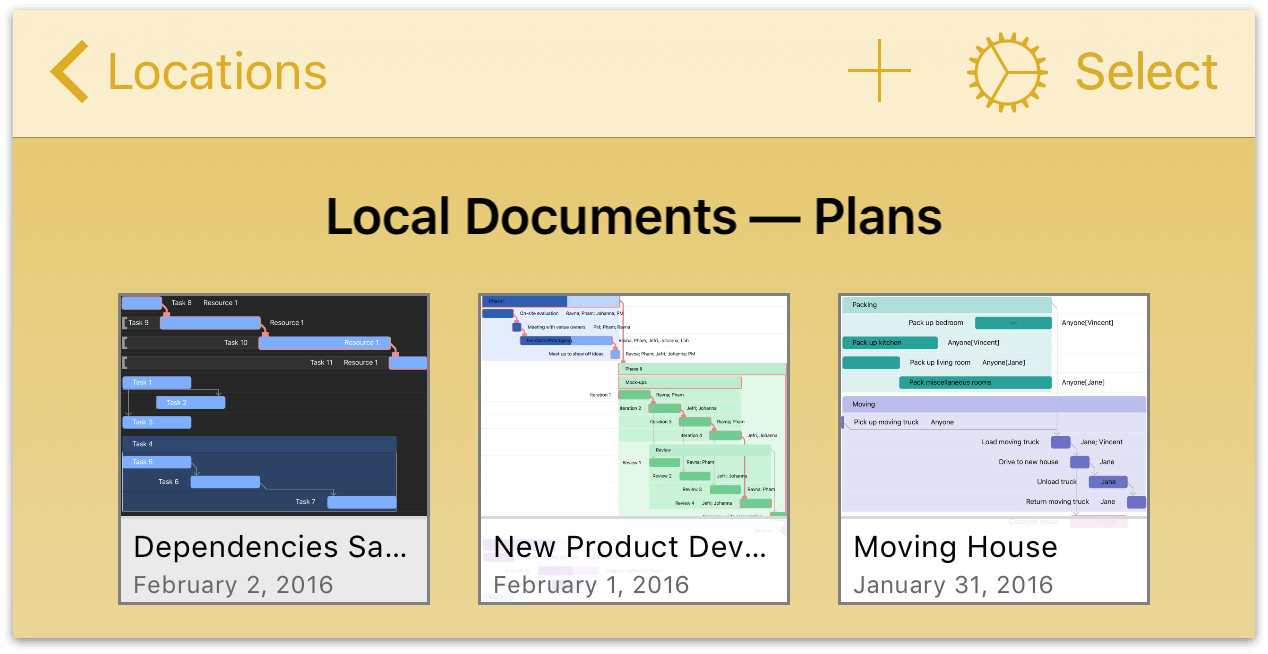
The next step describes connecting a new project to a shared server repository from scratch.
Step 2: Adding a Project to a Server Repository
To share a project you’re currently working on, open it in the Project Editor, then open the Project inspector and choose Publish & Subscribe.
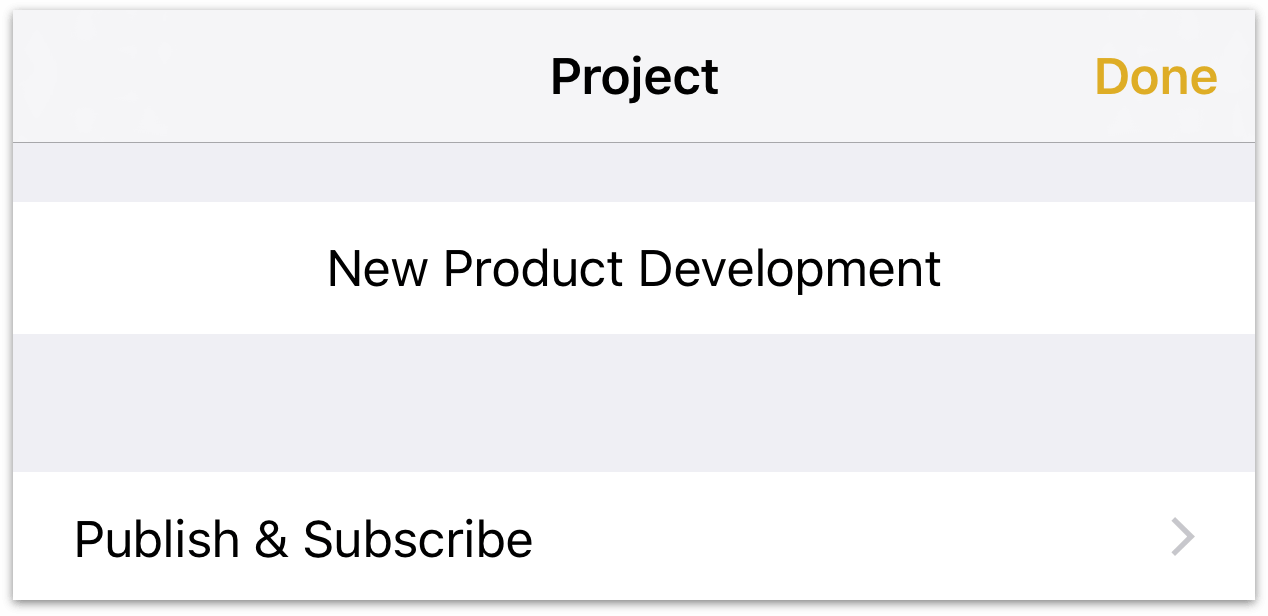
Next, choose a server account to sync with. Tap Repository to make the choice; if you have one set up (having just completed Step 1), you’ll see it listed here. If not, tap Manage Repositories and follow the instructions in the Getting Synced chapter to create an account.

When you choose a repository account for the project, it is copied to the server and is now ready to be published to the server for the first time.
Step 3: Publishing and Subscribing to Project Changes
Once you’ve chosen a server repository for your shared project, options to Publish changes to the project and Update the project based on changes made remotely appear in the project’s Project inspector. Until you tap Publish for the first time, the project continues to exist only locally on your device; tapping Publish copies the project to the server for access by others.
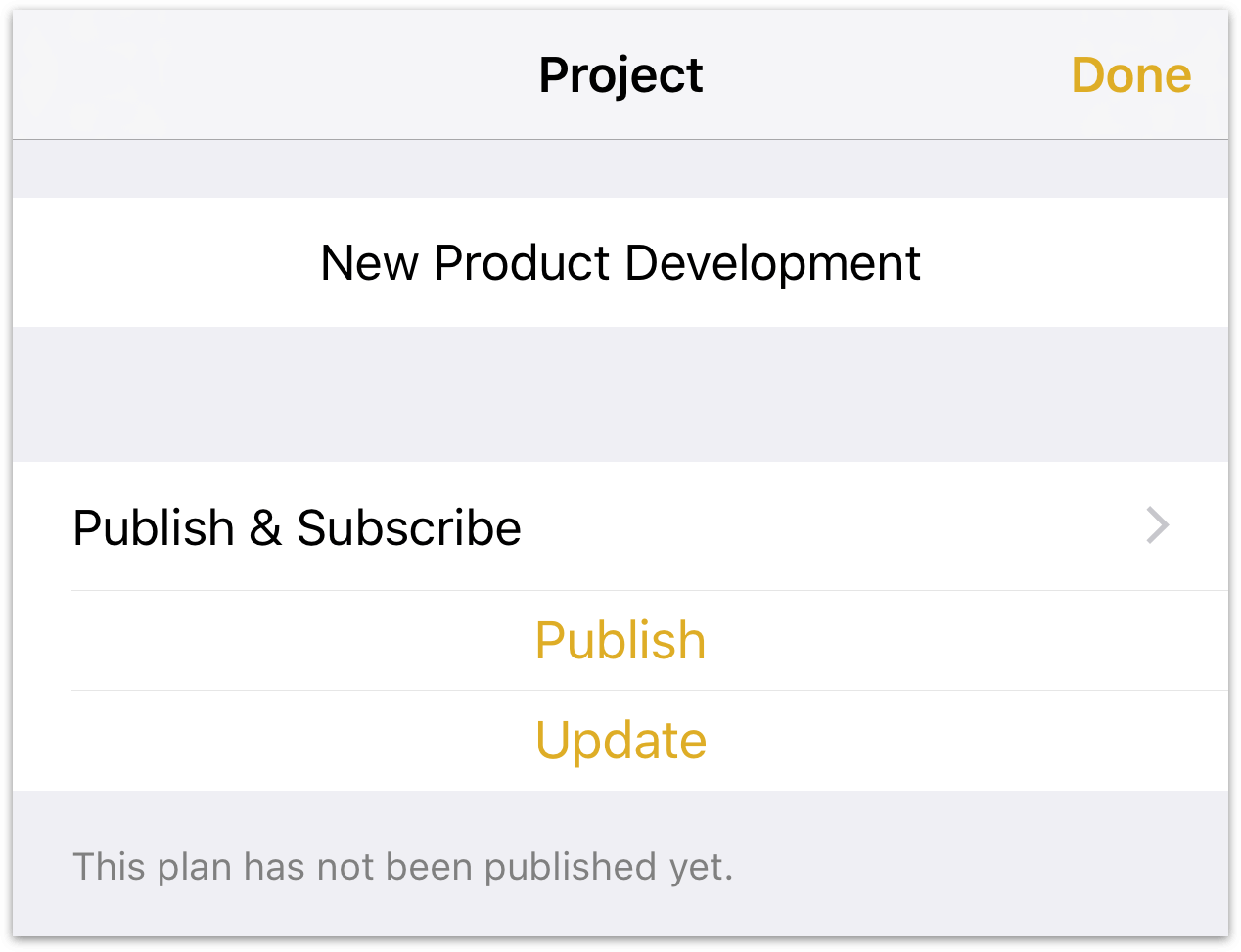
Unlike OmniPlan’s OmniPresence sync and other cloud sync methods where the primary concern is keeping files in an identical state across your devices, publish and update actions don’t happen automatically when syncing to a shared repository.
This is by design—since the project is shared by multiple contributors, it’s important to monitor changes as they’re applied. User-invoked publication and updates provide a mechanism for more deliberate information exchange and detailed change tracking tools for administration of the project.
Once a project is published, a count of changes made since the previous publish action is displayed beneath the Publish and Update controls in the Project inspector.
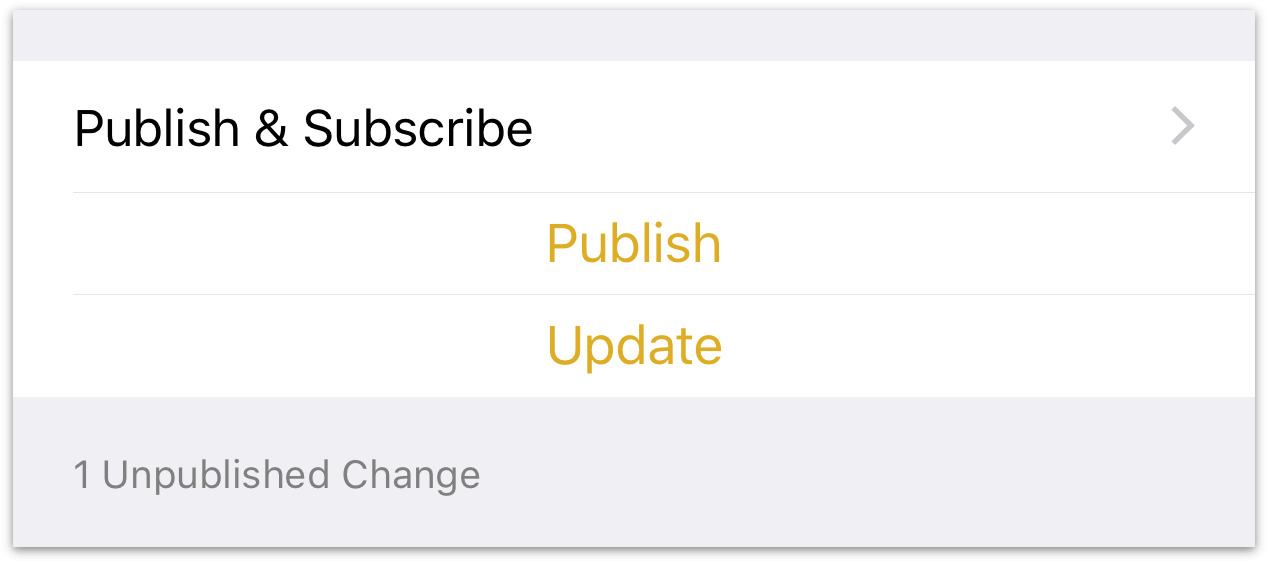
At any time after connecting a project to a shared server repository, tap Publish & Subscribe in the Project inspector to edit its repository settings.
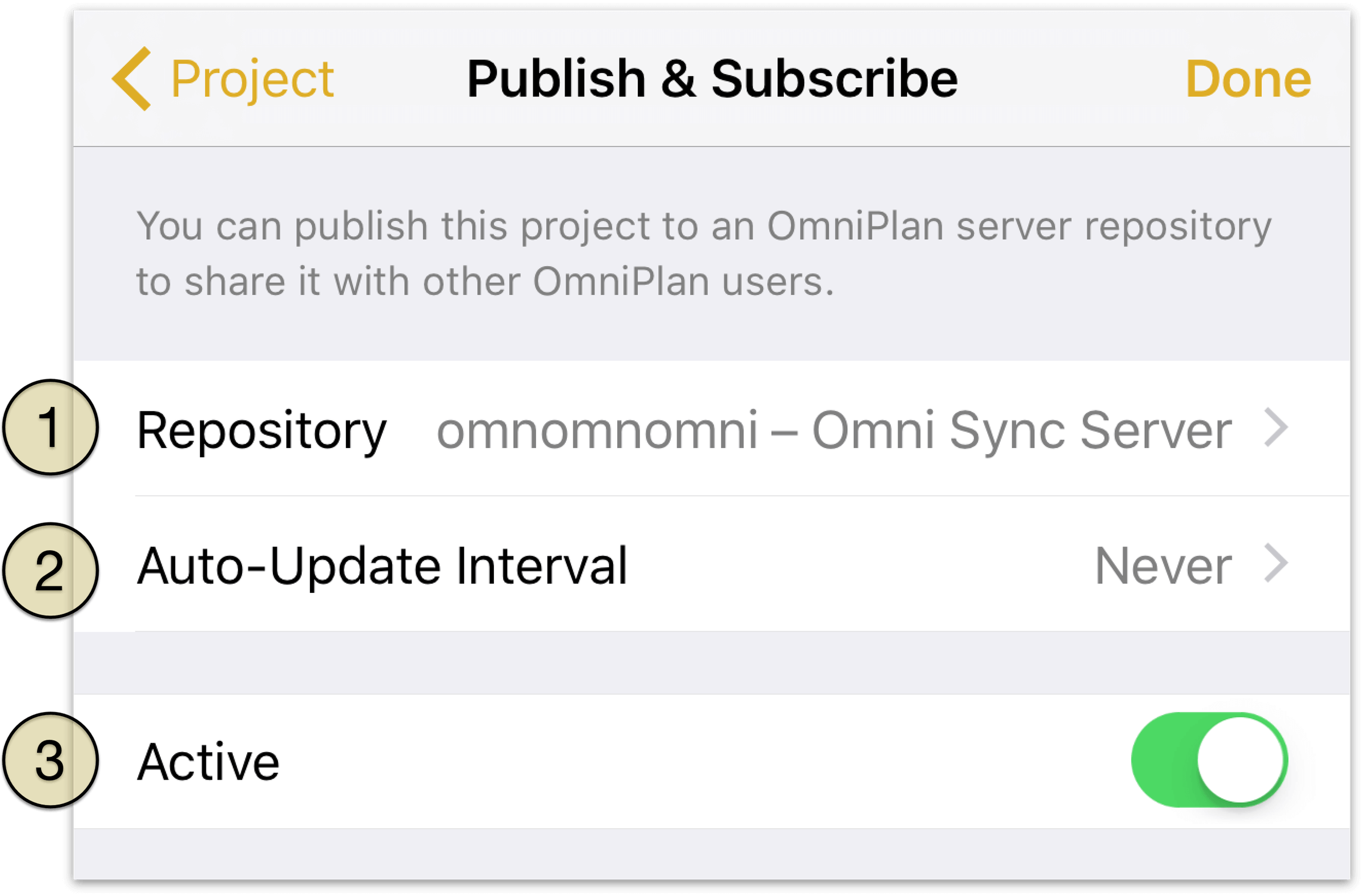
- Repository—tap to select a different shared server for the project, manage repository accounts, or choose resource load publication settings.
- Auto-Update Interval—tap to choose an interval at which the project will automatically receive new changes from the server. This is useful if the administration requirements of your project don’t involve gatekeeping of the changes made by others.
- Active—tap to switch the project between active and inactive status. An inactive project saves its repository account information, but loses the ability to publish or update until it is made active again.
Step 4: Balancing Resource Loads Across Projects
If resources (usually human members of your team) are shared between multiple projects in the same repository, you’ll want to decide whether you’ll >publish the current project’s resource loads to other projects and whether the current project will subscribe to the resource loads of others.
The settings for resource load publication and subscription can be be found in the Project inspector’s Publish & Subscribe screen under Repository.
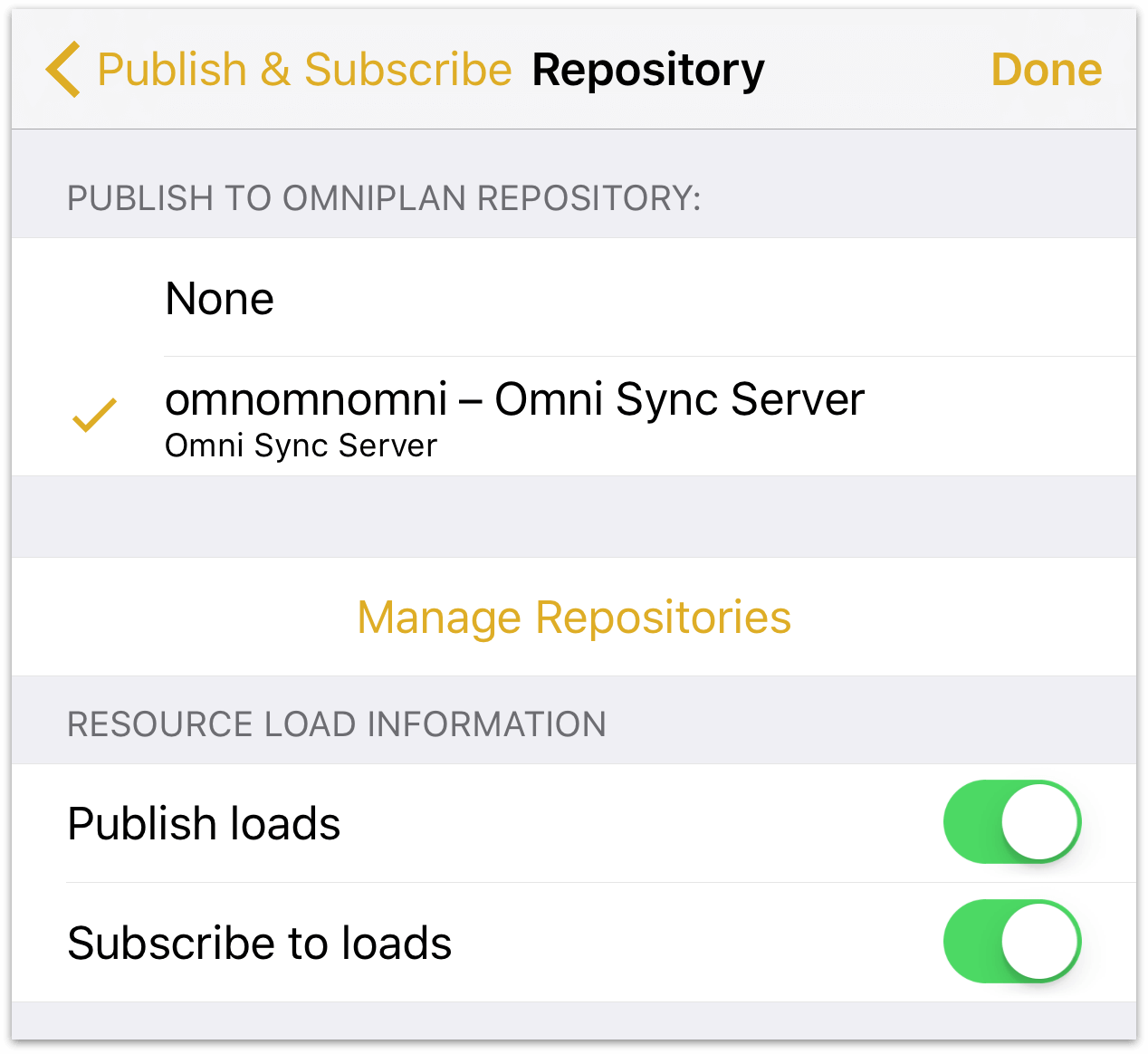
Choosing to publish a project’s resource loads means that other subscribing projects will obey its workload information when leveling; if Julie is working on Project A on Wednesday and its loads are being published to Project B, after leveling Project B won’t schedule her to work on Wednesday.
Choosing to subscribe to resource loads means that the project will obey all constraints by projects in the repository that are publishing their loads. By using only the publish or subscribe option a hierarchy of priority can be established between simultaneous projects—a project that only publishes will always have its needs met first, while a project that only subscribes will be assigned resources only when they can be spared.
By both publishing and subscribing, projects are treated as equals—and if a project neither publishes or subscribes, it ignores external factors and syncs only with its own updated resource load information.
Note
The key to balancing resource loads across projects is that individual resources be tagged and identified by a unique email address that is shared across all projects. This can be set by tapping the resource in the Resource inspector and entering an email address beneath its name.
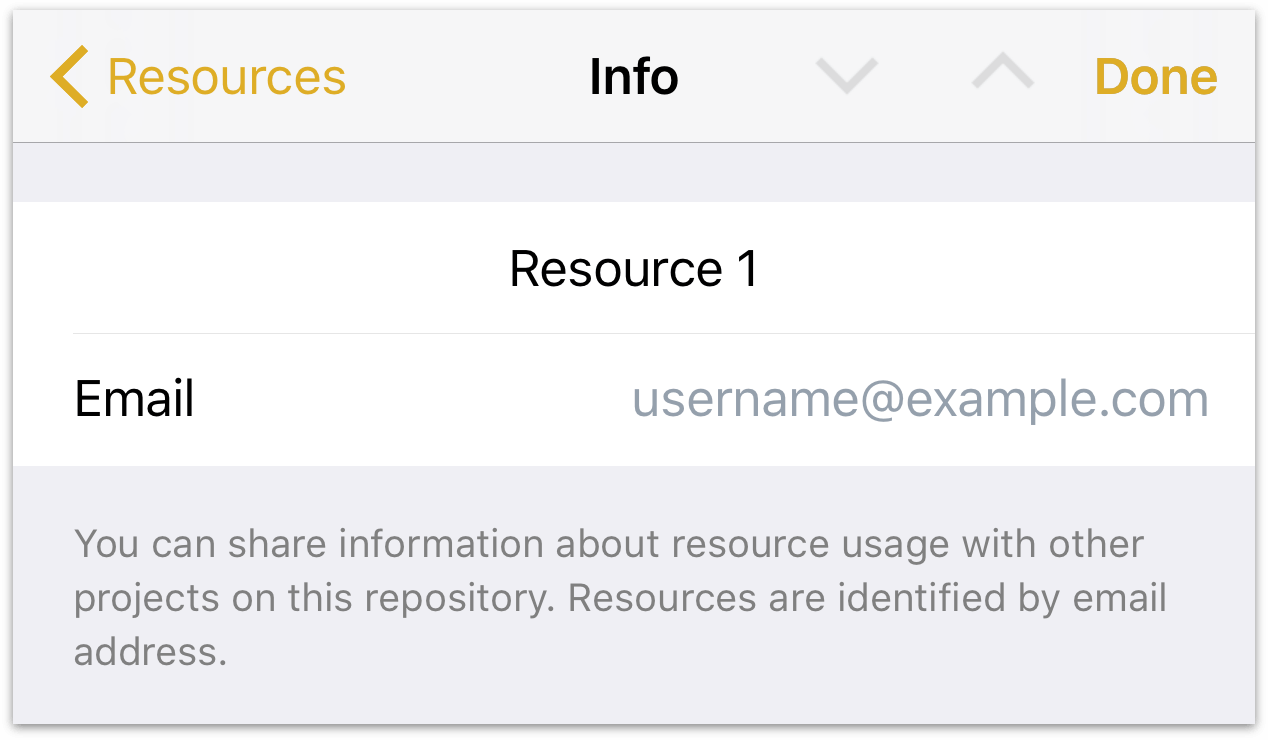
Step 5: Tracking and Approving Changes
Whether or not you’re publishing or subscribing to the resource loads of other projects, you can use change tracking to track changes made to the shared project and accept or reject the changes of others.

To enable change tracking, tap Change Tracking in the View inspector. A toggle switch appears to indicate that change tracking of the shared project is currently turned off; tap it and return to the View inspector to see that change tracking is now enabled.
From now on, whenever a change is made to the project (either locally or remotely), it will be logged in the Change Tracking screen in the View inspector. When a change is ready for review the View inspector’s icon changes to note that an approval action is required.
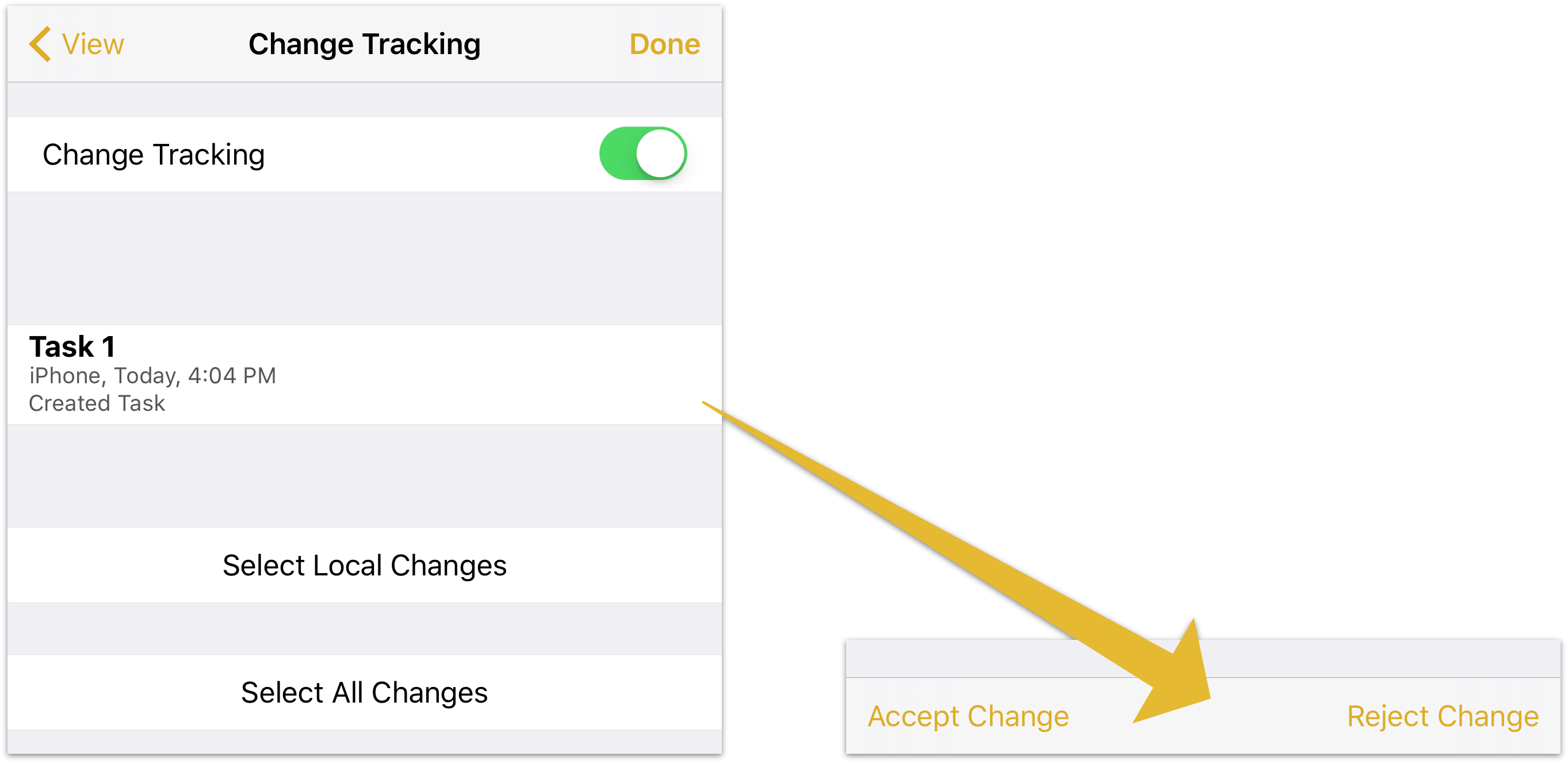
The Change Tracking screen displays a list of changes made since your last visit. Each change includes the relevant task name, the device responsible for the change, the date the change was made, and the nature of the change. In the example, the administrator’s iPhone was used at 4:04 PM today to add Task 1 to the project.
To manage changes, select them by tapping them individually or choosing to Select Local or Select All changes. With the desired changes selected, tap Accept to keep them applied, or Reject to revert the project to its state before the selected changes were made.
Note
If complex interdependent changes have been made to the project, it may not be possible to move back and forth between change states with perfect fidelity. Be sure to double-check the project after accepting or rejecting a large number of changes.
Keyboard Shortcuts
If you’re using OmniPlan for iOS with an external keyboard connected to your device, you can take advantage of the app’s built in keyboard shortcuts for many common tasks.
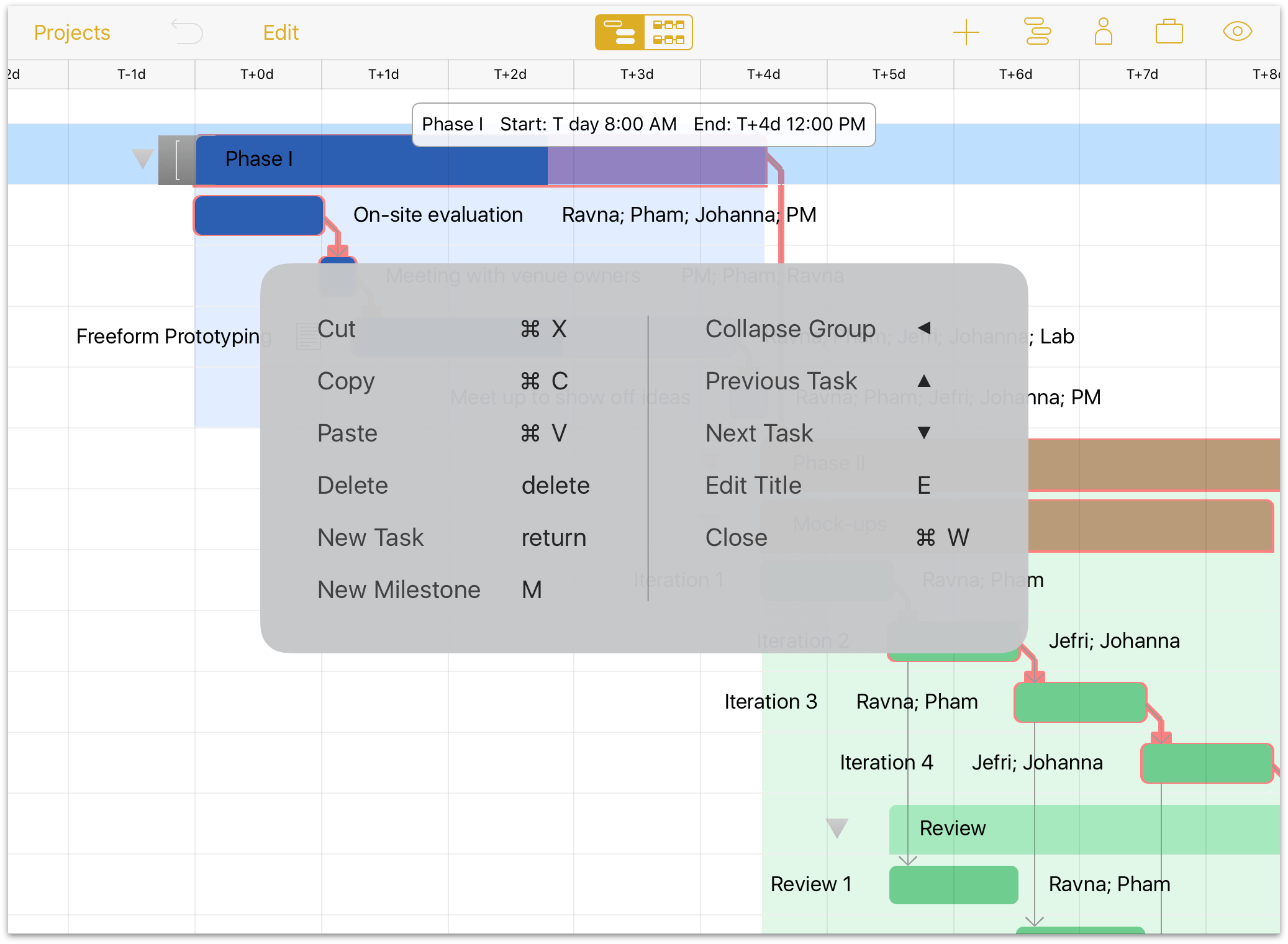
Anywhere in the app, press and hold the Command (⌘) key on your connected keyboard to view a list of available shortcuts. There are some shortcuts that work no matter where you are, while others are specific to your current view. Some locations may have more than one overlay screen’s-worth of shortcuts available; in that case, browse between pages by swiping left or right with the Command key held down.
Note
The keyboard shortcuts listed in this chapter are available in OmniPlan for iOS on all devices. However, only iPad offers the reference overlay.
Universal Shortcuts
The following shortcuts are available anywhere in OmniPlan.
- Undo (Command-Z)
- Revert the most recent action taken.
- Redo (Shift-Command-Z)
- Reinstate an action that was just reverted. Note that redo works best immediately after undoing something; if you switch views or take additional actions redo may not be available.
- Cut (Command-X)
- Remove the selected text or item(s) and copy them for pasting elsewhere.
- Copy (Command-C)
- Copy the selected text or item(s) for pasting elsewhere.
- Paste (Command-V)
- Insert copied text or item(s) at the selected location.
- Delete (delete)
- Delete the currently selected item(s). In the document browser this moves local documents to the trash; in the project editor this removes tasks from the Gantt chart.
Document Shortcuts
The following shortcuts are available when working with files in the document browser, or are used to return from an open document to the document browser.
- New Document (Command-N)
- Create a new OmniPlan document in the current location in the document browser.
- Close Document (Command-W)
- Close the project editor for the current document, saving changes, and return to the document browser.
Project Editor Shortcuts
The following shortcuts are available when working with tasks in the project editor, either in the Gantt chart or Network Diagram. Alternate shortcuts are listed for when editing text in-line.
- New Task (return)
- Create a new task in the project editor’s Gantt chart or Network Diagram.
- New Milestone (M or Shift-Command-M)
- Create a new milestone in the project editor’s Gantt chart or Network Diagram.
- Expand Group (right arrow or Command-right arrow)
- Expand the contents of a currently selected group.
- Collapse Group (left arrow or Command-left arrow)
- Collapse the contents of a currently selected group.
- Previous Task (up arrow or Command-up arrow)
- Move to the task above the current task in the Gantt chart.
- Next Task (down arrow or Command-down arrow)
- Move to the task below the current task in the Gantt chart.
- Edit Title (E or Command-E)
- Edit the title of the currently selected task.
Getting Help
When you’re in need of help—whether you’re puzzled by the Gantt chart, having trouble syncing, or experiencing another issue with OmniPlan—it’s good to know that the Support Humans at The Omni Group are available to lend you a hand.
The OmniPlan Website
The OmniPlan website is always a good place to find the latest information about OmniPlan, complete with an ever-growing support section.
The Official Forums
The Omni Group maintains online forums for all of our products, and you’re invited! Come share your questions and ideas with other users and Omni staff.
Email Support
If you’re stuck, if you have a good idea for a future version of OmniPlan, or if you just want to let us know how we’re doing, go ahead and send us an email. Use this link or choose Send Feedback from Settings to conjure up a message addressed to us. We take support seriously, so you can expect a prompt response actually typed by human hands.
Release Notes
For detailed information about what has changed in each minor version of OmniPlan, check out the Release Notes in Settings.
Glossary
The following is a list of terms specific to OmniPlan or project management that you’ll encounter throughout this manual, defined and listed in alphabetical order for easy reference.
- Actual schedule
- The actual schedule, in contrast to a baseline schedule, represents the way a project turns out in real life. Before a baseline is set for a project, the baseline and actual schedules are the same. After a baseline is set, further editing changes the actual schedule only.
- Assignment
- Assigning a resource to a task means that the resource is expected to be actively busy with that task throughout its duration. Assignment amounts are expressed as the percentage of the resource’s time being spent on the task.
- Baseline schedule
- A baseline schedule, in contrast to the actual schedule, is the way a project is planned to proceed. At the moment a baseline is set for a project, the baseline and actual schedules are the same. After the baseline is set, further editing changes the actual schedule only. As a project progresses, multiple baseline schedules can be set to provide updated benchmarks for comparison.
- Child
- A task nested hierarchically within a task group (the group becomes that task’s parent). This is terminology common to outlining software.
- Cost
- A task or a resource can have a monetary cost. The total cost of a task is the sum of the task cost and the costs of the resources assigned to it. A resource can have a per-use cost and a per-hour cost.
- Critical path
- A critical path is a series of dependent tasks which, if any of their durations change, will cause the whole project’s duration to change.
- Dependency
- The relationship by which one task must start or finish before another task can start or finish. For example, the task "Buy paint" must finish before the task "Paint fence" can begin.
- Duration
- Duration, in contrast to effort, is how long a task takes to complete in actual working time (that is, not including off-time). For example, a task which takes 4 hours of effort, and is assigned to 2 resources, has a duration of 2 hours. When you assign resources to a task, the duration or effort may change.
- Efficiency
- The measure of how much work a resource can get done in a certain amount of time. Efficiency can affect duration and effort: 100% efficiency means the resource can contribute 1 hour of effort for every hour of work; 50% efficiency means it can contribute 1 hour of effort for every 2 hours of work; and so on.
- Effort
- Effort, in contrast to duration, is how much work time a task takes to complete, considering all of the resources assigned to it. For example, a task which has a duration of 4 hours, and has 2 resources assigned to it, has an effort of 8 hours. When you assign resources to a task, the duration or effort may change.
- Equipment
- Equipment is a type of resource. It represents some kind of reusable asset, such as some special computer hardware. It can also be useful to consider things like meeting rooms to be equipment, if you need to balance their use between different tasks. For equipment resources, units represent the percentage of the resource that is available. Equipment can have Efficiency, Cost per Use, and Cost per Hour values.
- Gantt Chart
- The Gantt chart is a chronological representation of the project. Each task is represented by a bar, corresponding to a row in the outline, and possibly connected to other tasks by lines representing dependencies.
- Group
- Items in the Gantt chart or Network Diagram can be grouped together hierarchically. In the Gantt chart, a task group appears as a bracket enclosing its members from above. In the Network Diagram, the bracket appears to the left and right of its members.
- Level
- Leveling a project, or leveling resources, means automatically rearranging the project to make sure the resources are being used as efficiently as possible. This prevents a resource from being assigned at more than 100% of its available capacity at any time, and finds the best order for resources to work on tasks in order to complete them as quickly as possible.
- Material
- Material is a type of resource, representing consumable supplies. For material resources, Units represents the number of the resource that is being used throughout the project. This value updates as the resource is assigned to more tasks. Material resources can have Cost per Use and Cost per Hour values.
- Milestone
- A milestone is a task with no duration and no effort whose purpose is to mark some important point in the timeline of a project.
- Parent
- A task group exists at a level of hierarchy above its member tasks, and is considered their "parent". The tasks within a parent group are known as its "children".
- Resource
- Resources are the people and things needed to get a project done. Resources are listed in the Resources Inspector, and can be assigned to tasks. The three types of resources are Staff, Material, and Equipment.
- Resource load / Resource allocation
- A resource’s load is the amount of effort it is assigned to do at various times throughout the project. If a resource is assigned at more than 100% of its availability all at once, it is said to be overloaded or overutilized. Resource leveling tries to alleviate overload of resources.
- Staff
- Staff is a type of resource, representing people who work on the project. Staff units are measured as percentages. A person who is fully available to the project has a unit value of 100%; someone who is spending part of their working hours on other projects would have lower available units; note that this is not the same as having fewer working hours or being less efficient. Staff can have Address, Efficiency, Cost per Use, and Cost per Hour values.
- T day
- The first day of a project that has an undetermined start date. Until the start date is set, all dates are represented by an amount of time after T day, such as T+2w 1d.
- Task
- An item of work that needs to be done for the project to progress, represented by a corresponding task bar in the Gantt chart or node in network view.
- Units
- Units measure amounts of resources in various contexts. For a staff resource, the units value is a percentage representing how much of the person’s time is available to be assigned to tasks. Equipment resources are similar to staff in that units represent the percentage of the equipment’s effort that is devoted to the project. For material resources, the units value is a number representing a physical quantity.
- Violation
- A violation is a problem in the project that represents an untenable logical contradiction in the arrangement of its constituent tasks. Tasks that start before the project start date, tasks that don’t have enough time to complete before their dependent tasks need to start, and dependencies that cause a task to be prerequisite to itself are all examples of violations.

